据说统计推断是统辅基础五大件里最难的,这门课也可以直接称为数理统计(基础)。我初概的体验并不是很好,甩锅给了不匹配的教材,还记了 PF。但统计推断要洗心革面好好上,也打算做预习。不仅是因为不打算再去数学系回炉重造,也是担心留下一种隐隐怀疑自己并不是很适合学统计的感觉,本科过半又换方向的试错成本就略高了。
不过,我确实也很好奇到底适不适合、有多感兴趣呢?真不行的话,该换还得换呀。
这课的 PPT 是英文,老师讲课用中文,教材英文中译都有,图书馆借来的是中文版,据说考试卷子是英文的。
妈呀.jpg,所以以下遇到名词的话会中英都写。一些懒得打的东西就直接通过截图 PPT 或者手写拍照给出,主要我也怕我把写的东西弄丢了(。
Lecture 1
先吹了会水,尽管课时紧张,还是要骗骗大家统计学前景非常广阔 x
本节介绍统计推断中的一些基本概念,对应教材第五章《随机样本的性质》。
研究范围约定及基本定义
研究范围的约定:在研究大量数据、确定其行为时,因为难以全部分析,我们会对其进行多次随机抽样(Sampling),研究多次得到的样本的性质,以及“多次”中蕴含的性质,来推断总体数据的性质。这是统计推断的核心思想之一。以下约定一些术语。
Population(总体):总的研究范围,用一个随机变量 \(X\) 来概括,\(X\) 服从有某些参数 \(\theta\) 的分布 \(F\)。我们的目标正是通过抽样来找到这个分布 \(F\),从而刻画 Population 的性质。
Population parameters:用于表征 Population 的性质,比如期望,方差,矩,也就是上述的 \(\theta\)。例如,对于一个服从正态分布的 Population,它的 Population parameters 记为 \(\theta=(\mu, \sigma^2)\)。
Sample(样本):多次抽样得到的随机变量 \(X_1,X_2,...,X_n\) 独立同分布,有相同的(边缘)概率密度函数(PMF) \(f(x)\),则称其为 Population 中的(随机)样本。
Sample size(样本量):显然上述的那个 \(n\) 就是样本量,表征样本大小,trivial。
举个例子。现在有 10000 个产品,其中有一部分废品。我们想知道大约有多少废品又不希望检测所有的产品,于是每次抽样 100 个进行检测。此处的 Population 就是指 10000 个产品,每次的 Sample 是抽到的 100 个样品,Sample size 是100。可以在 Population 上定义随机变量 \(X\),如果产品是废品则 \(X=1\),合格则 \(X=0\),则每个样本可以表征为 \(X=\lbrace X_1,X_2,...,X_n\rbrace\)。
在我们抽样之前,\(X_i\) 都还是未知的随机变量,和 Population 同分布。然而抽样之后,\(X=\lbrace X_1,X_2,...,X_n\rbrace\) 就成为了一个确切的,由实数组成的数组,比如在上述例子中,某次抽样得到的结果是一个由 \(0,1\) 表示的数组。
Sample space(样本空间):和概率论中的样本空间不太一样的是,这里的样本空间表示所有抽样可以得到的数组,用 \(\chi\) 表示,这个符号和 Chi-Square 分布的符号是相同的。在上述例子中,就是:\(\chi = \lbrace (x_1,x_2,...,x_{100}) | x_i \in \lbrace 0,1 \rbrace,i=1,2,...,100\rbrace\)。
Simple random sampling:怎么定义随机抽样?如果能使得到的 \(X_1,X_2,...,X_n\) 独立同分布(\(i.i.d. \sim F\)),那么这种抽样方式就是简单随机抽样,也称为随机抽样。
需要注意的是,简单随机抽样是有放回的,否则抽到某一元素的概率会不断变化,并不是独立的。
Joint distribution function:\(F(x_1,x_2,...,x_n)=F(x_1)F(x_2)...F(x_n)\)
Joint density function (if exists):\(f(x_1,x_2,...,x_n)=f(x_1)f(x_2)...f(x_n)\)
统计量
定义了这么多东西之后,我们可以研究抽取出来的随机样本 \(X_1,X_2,...,X_n\),研究方式是定义一些关于这些随机样本的函数,研究函数的性质。
Statistic(统计量):记抽取得到的随机样本 / 数据为 \(X_1,X_2,...,X_n\),函数 \(T(X_1,...,X_n)\) 称为一个统计量。显然,在抽取之前它是一个随机变量的函数,也即一个随机向量;但在抽取之后,\(T\) 可以计算为一个实数。
作为随机变量,\(T\) 的概率分布称为 Sampling Distribution,抽样分布。
亿些常用的 Statistic:
Sample mean:\(X = \frac{1}{n} \Sigma_{i=1}^n X_i\)
Sample variance:\(S^2 = \frac{1}{n-1} \Sigma_{i=1}^{n} (X_i-X) ^2\)
Sample standard deviation:\(S\)
K-th origin moment(k 阶矩):\(a_{n,k} = \frac{1}{n} \Sigma _{i=1} ^{n} X_i ^k, k =1,2,...\)
K-th center moment(k 阶中心矩):\(m_{n,k} = \frac{1}{n} \Sigma _{i=1} ^{n} (X_i-X) ^k, k =2,3,...\)
Order statistic(次序统计量):排列所有的样本为 \(X_ {(1)} \leq X_ {(2)} \leq ... \leq X_{(n)}\),则 \((X _{(1)}, X _{(2)},...,X _{(n)})\) 是次序统计量。
Sample medium(中位数):\(m_{\frac{1}{2}}=X_{n/2}\) 或者 \(\frac{1}{2} (X _{n/2}+X _{n/2+1})\)
Extremum of sample:\(X _{(1)},X _{(n)}\)
Sample p-fractile(\(0<p<1\)):\(m_p = X_{(m)}\),其中 \(m=[(n+1)p]\)
Sample range(极差):\(R=X _{(n)}-X _{(1)}\)
Sample coefficient of variation(样本变异系数):\(v=\frac{S}{X}\)
Sample skewness(样本偏度),Sample kurtosis(样本峰度)自查:
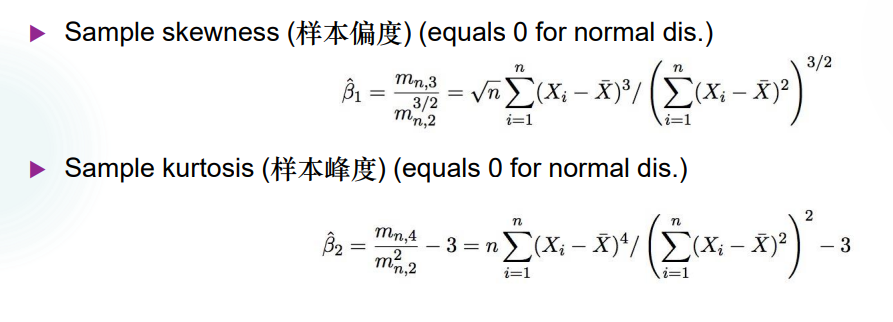
Empirical distribution function(经验分布函数):
\(I_A(x)=1 \\; for \\; x \in A, otherwise \\;0\)
\(F_n(x)=\frac{1}{n}[number\\; of\\; X_1,X_2,...,X_n \leq x]\)
对于二阶随机向量:
\(S_{XY}=\frac{1}{n} \Sigma _{i=1} ^{n} (X_i-X)(Y_i-Y)\)
\(S_X,S_Y,X,Y\) 各自同上定义。
经典分布查阅
卡方分布
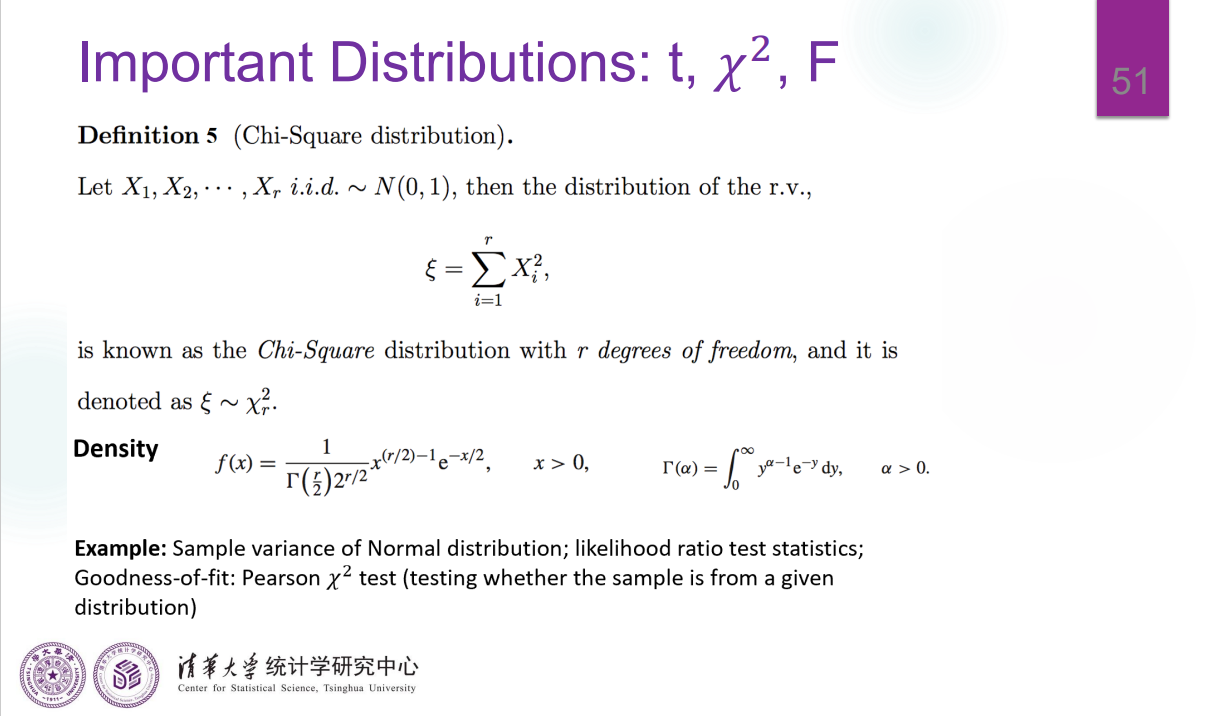
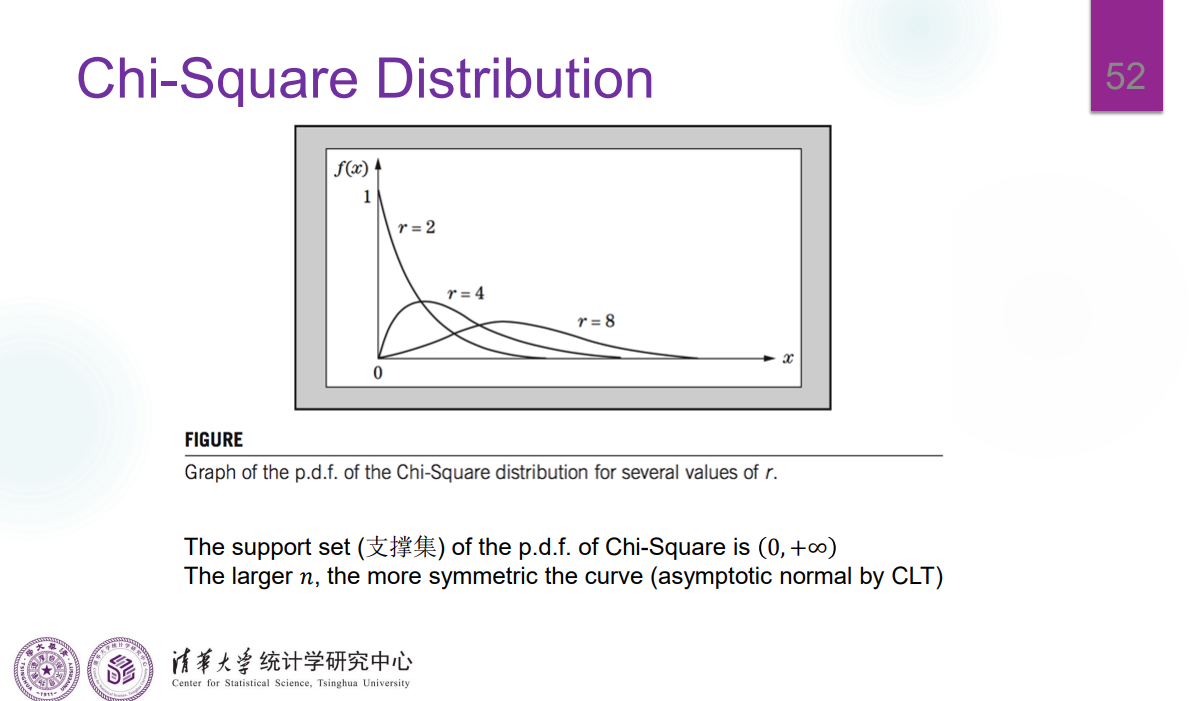
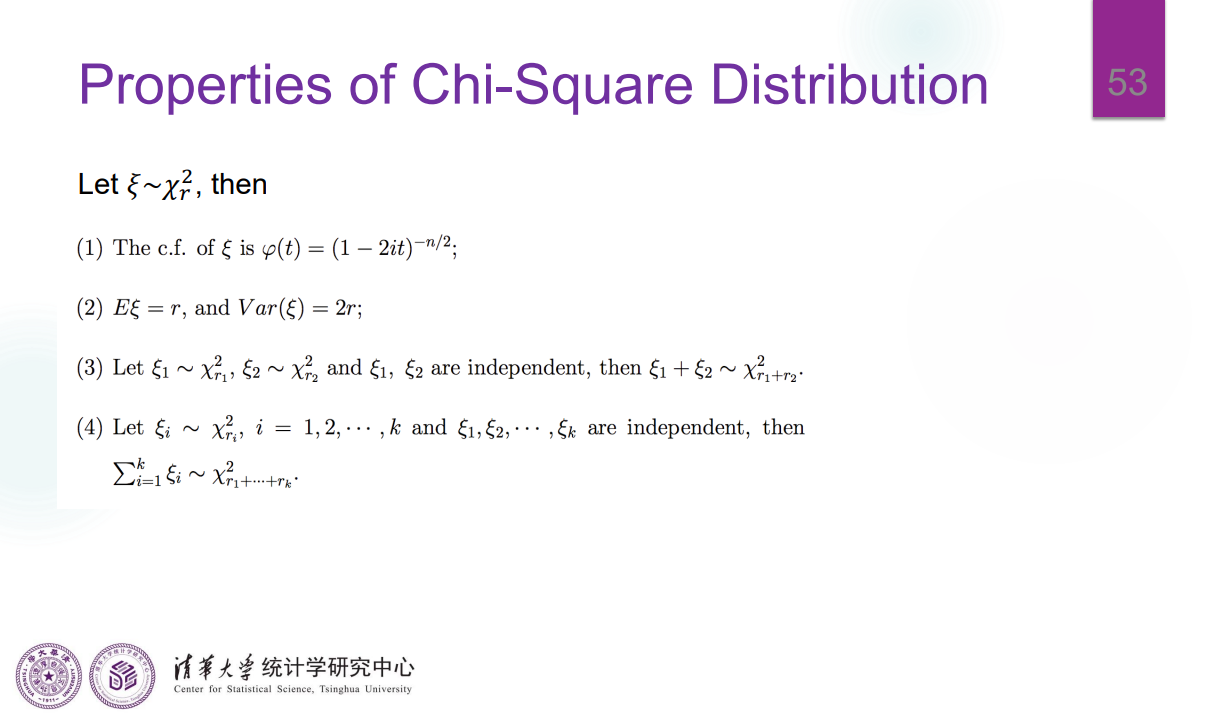
\(t-\)分布
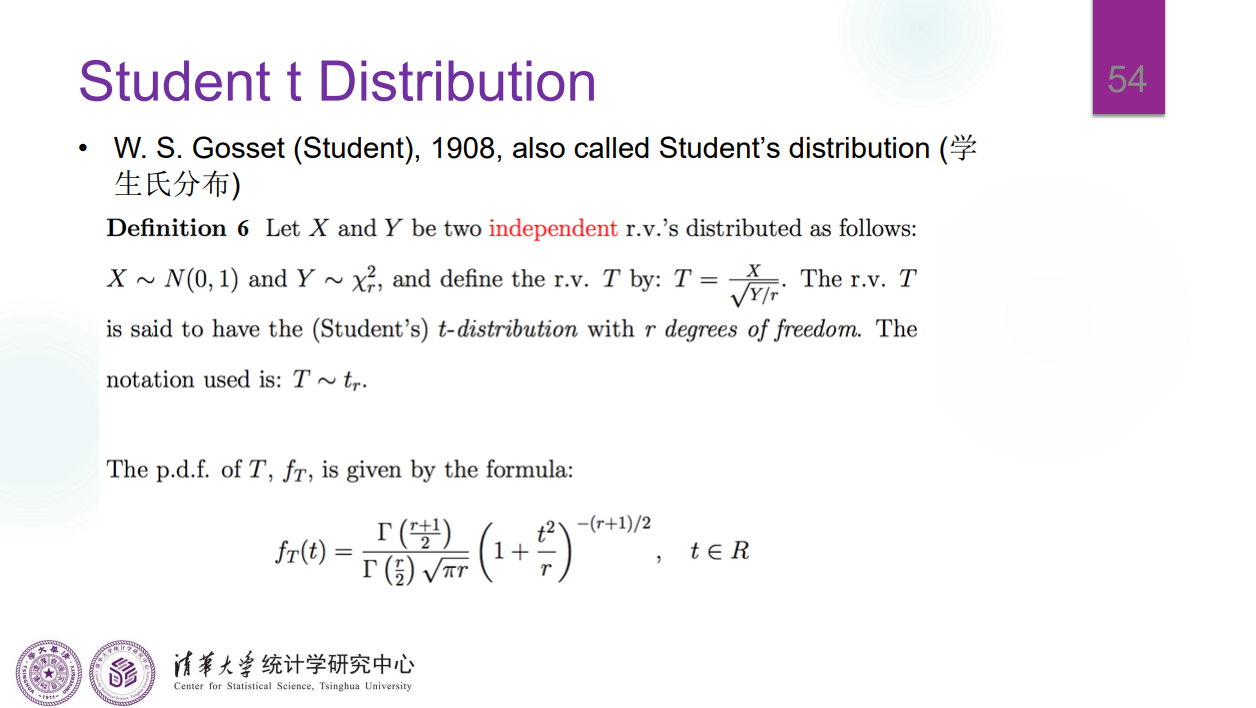
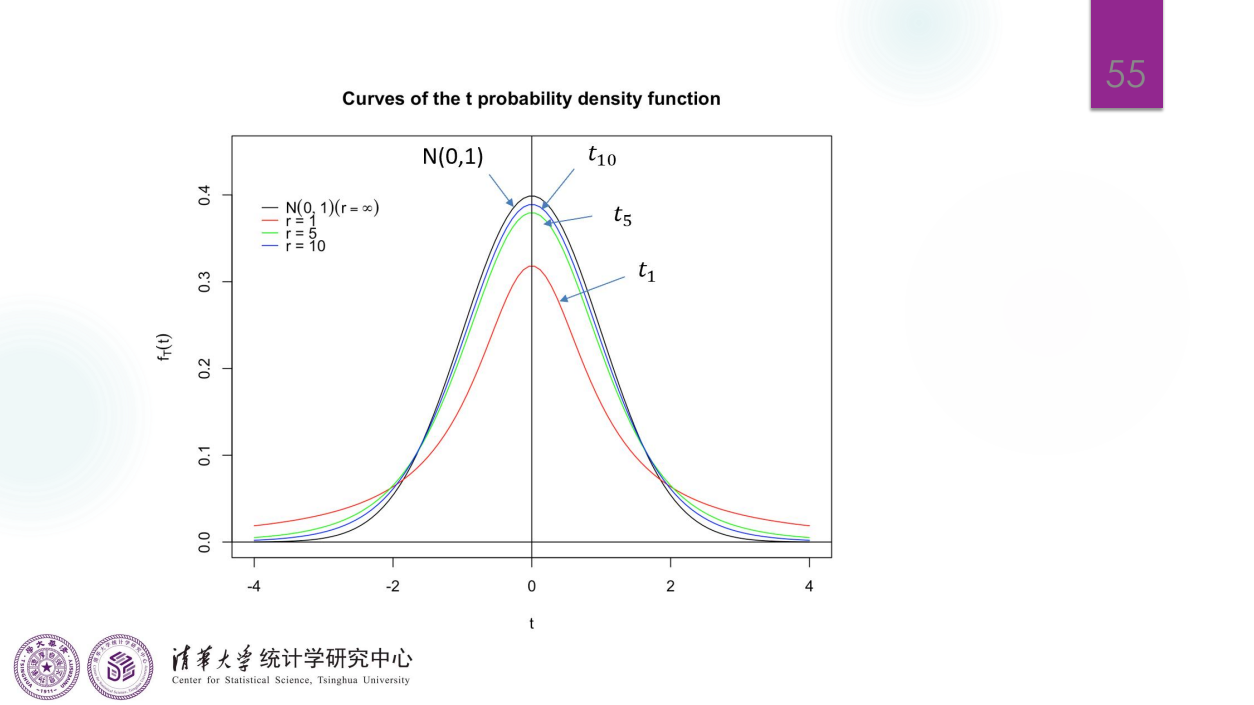

\(F\) 分布
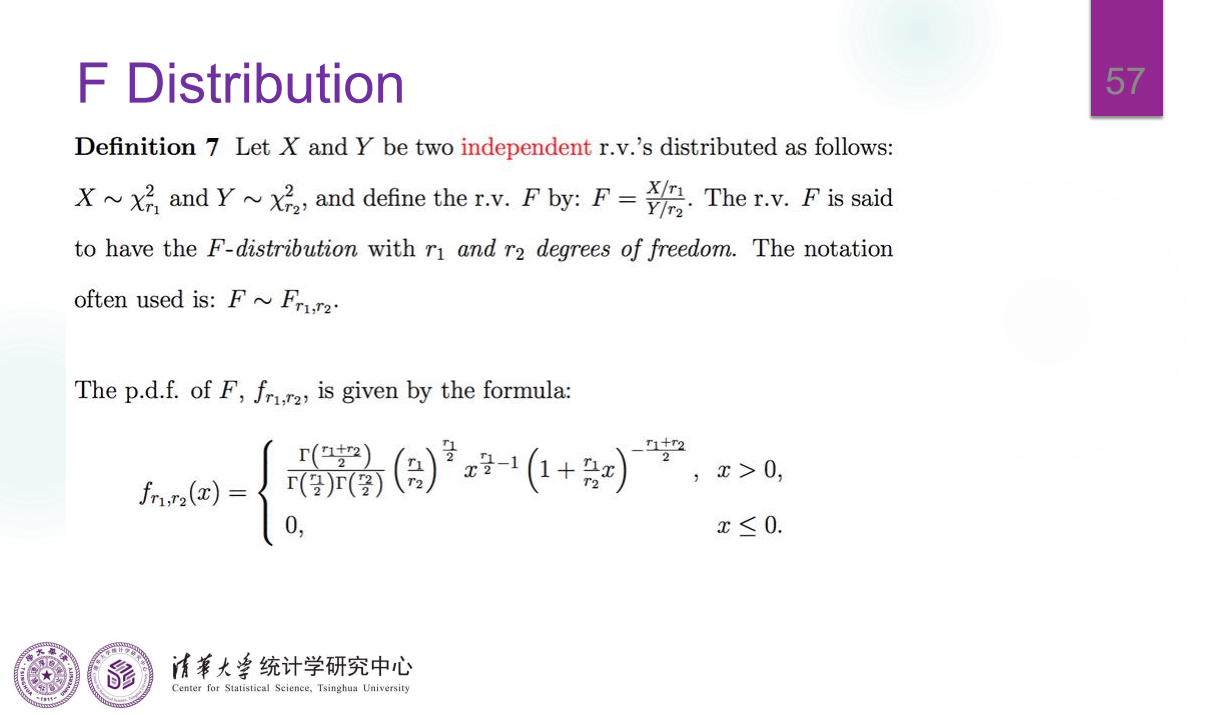
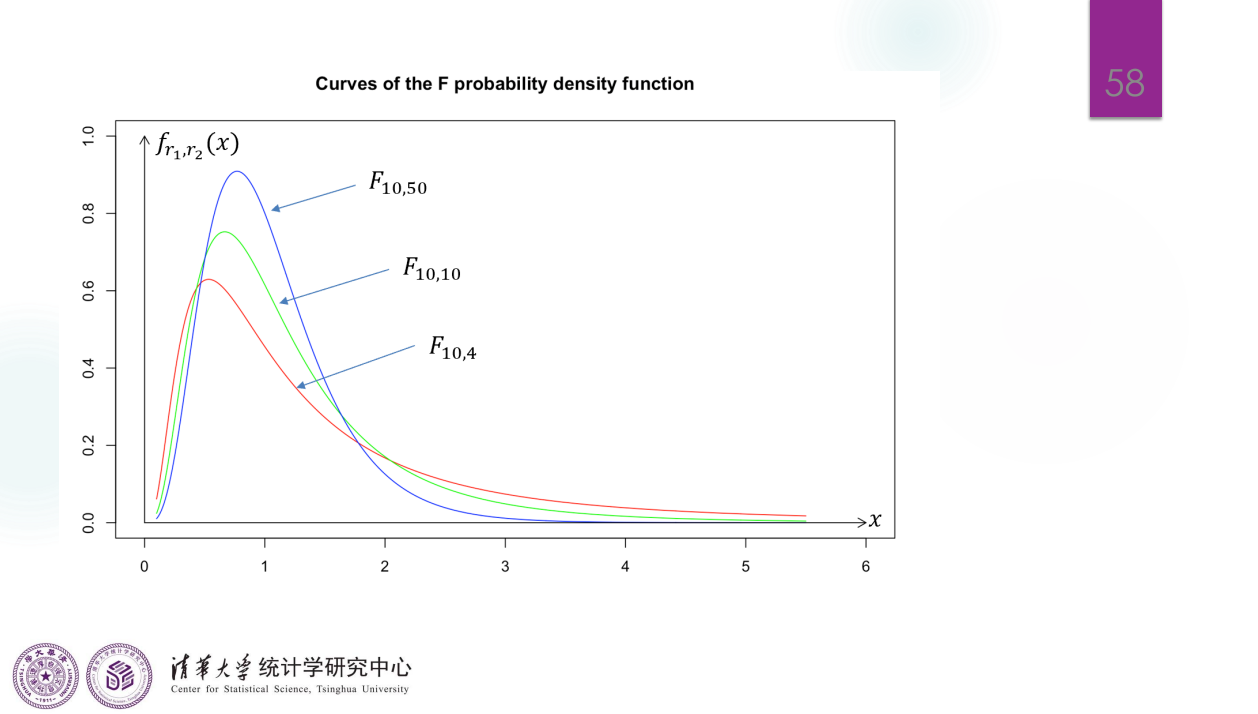

Lecture 2
本节仍然是介绍统计学的基础内容,讨论了一些 Statistic 的性质,并介绍了分布族。
我偷懒,定理和证明就直接拍手写了,自认为自己的字还没那么不堪入目。另外每个学期都会有找不到的笔记,还是存电子版吧(
统计量及其性质
Lecture 1 中介绍了 114514 个常用的 Statistic,我们对其中一些讨论它们的 sample distribution 的性质。
特殊统计量
Sample mean:因为它的形式是 \(nX = X_1+X_2+...+X_n\),且 \(X_i\) 互相之间 i.i.d.,我们可以用概率母函数 / 矩母函数来处理得到 \(nX\) 的分布。
如果只是求近似而不是准确的分布,可以使用 Central Limit Theorem 进行估计,但要注意,只有 \(X_i\) 的方差有限的情况才能使用 CLT。
Linear transformation:形为 \(Y=\frac{X}{n}\),于是我们可以用 \(CDF\) 转 \(PDF/PMF\) 的方式计算它的 \(PDF/PMF\),直接给出结论:\(f_Y(y)=nf_X(ny)\)。
经典结论
Theorem 1:

Theorem 2:
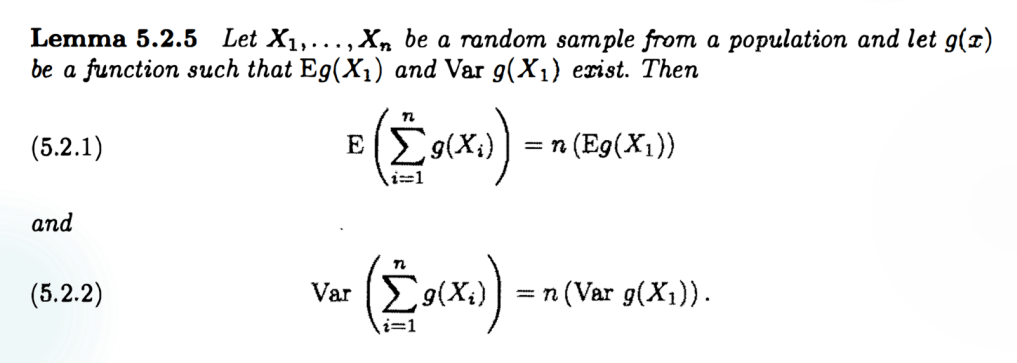
这个第二问的证明,要用一下 \(cov(X_1,X_2)=0\),权当留个提示。因为我第一遍没证出来。
Theorem 3:

因为 \(\bar{X}\) 的期望和 \(X_1\) 的期望相同,\(S\) 的期望和 \(X_1\) 的方差相同,因此二者是 unbiased statistic(无偏统计量)
正态分布的随机抽样
Theorem 1:考虑独立不同分布的正态分布的线性组合,它的方差和期望也是一个线性组合。一般这种类似于 \(X_1+X_2+...+X_n\) 的都可以用矩母函数证明。

Example 1:

\(X,Y\) 是两个方差和期望都已知的正态分布,要求 \(P(X>Y)=P(X-Y>0)\),而 \(X-Y\) 是正态分布的线性组合,也是参数已知的正态分布,将其标准化即可。
Theorem 2:考虑一组由正态分布随机抽样生成的 statistics,用矩阵形式表示:
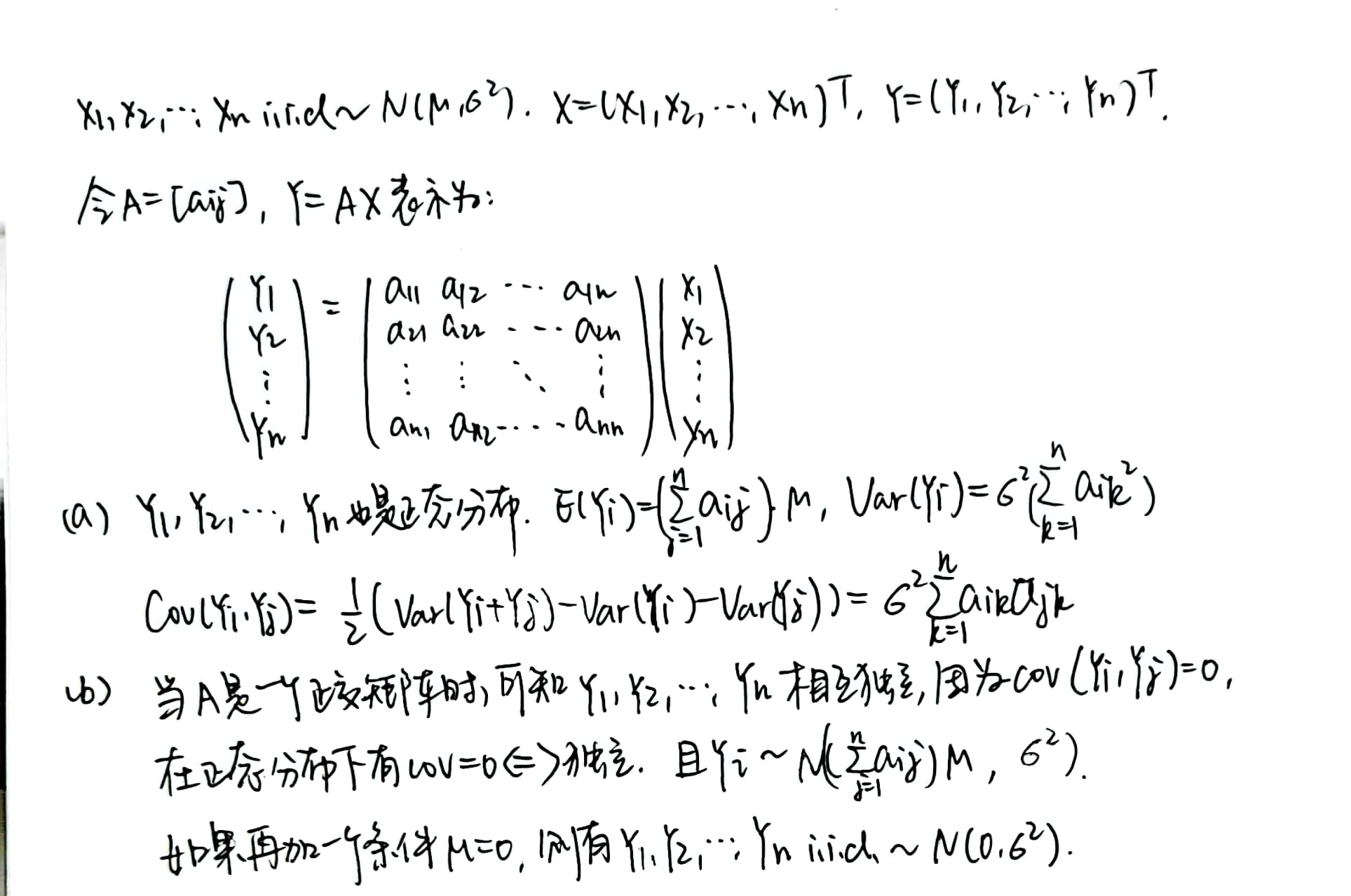
可以看到矩阵是正交矩阵时有很好的性质。固定正交矩阵的第一行之后,我们可以对此时的 \(\bar{X}\) 和 \(S^2\) 进行讨论:
Theorem 3:\(\bar{X}\) 和 \(S^2\) 是独立的,且由 \(S^2\) 可以生成一个 Chi-Square 分布。

指数分布族
概念
简单来说,一个分布的 PDF / PMF 可以表示为 \(f(x; \theta) = c(\theta)h(x) exp[\Sigma_{j=1} ^{n} w_j(\theta) t_j(x)]\) 的形式,则无论随机取多少个独立同分布的 sample,它们的联合分布也可以保持这个形式,则称该 population 属于指数分布族。
其中的 \(\theta\) 表示该分布的参数,可以表示为 \(\theta = (\theta_1,\theta_2,...,\theta_k)\)
比如正态分布,Poisson 分布都属于指数分布族:
\(f(x_1,x_2,...,x_n;\theta) = (\sqrt{2\pi} \sigma)^{-n} exp(-\frac{1}{2\sigma ^2} \Sigma_{i=1} ^{n} (x_i-\mu)^2)\) 为正态分布的 Joint PDF;
\(f(x_1,x_2,...,x_n;\theta) = e^{-n\theta} (\Pi_{i=1} ^{n} \frac{1}{x_i !}) exp(ln\theta (x_1 + x_2 +...+ x_n))\) 为泊松分布的 Joint PMF。
实际上,连续的指数分布族还有 Gamma,Beta 分布族,离散的指数分布族还有二项和负二项分布族。
自然指数分布族
自然指数分布族和举例:
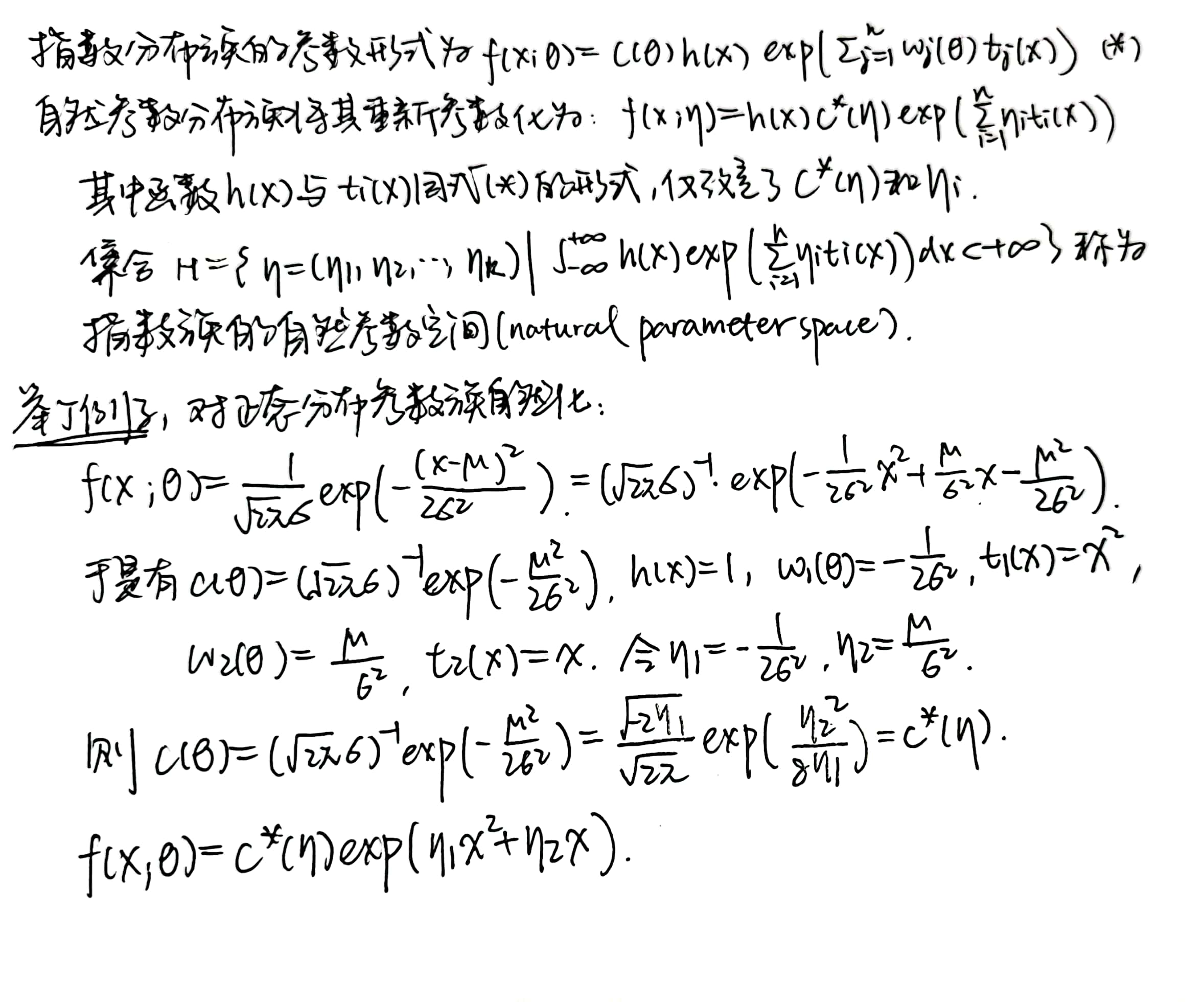
位置与尺度族
位置与尺度族:直观来说,位置族的形状完全一样,但位置上有偏移,例如若干个期望不同而方差相同的正态分布;尺度族的位置相同,形状上有伸缩变化,例如若干个期望相同但方差不同的正态分布。
位置族:取一个标准概率密度函数(standard PDF)\(f(x)\),位置族中的其他函数 \(f(x-\mu)\) 相对于这个标准函数的偏差记为 \(\mu\),称为 location parameter(位置参数).
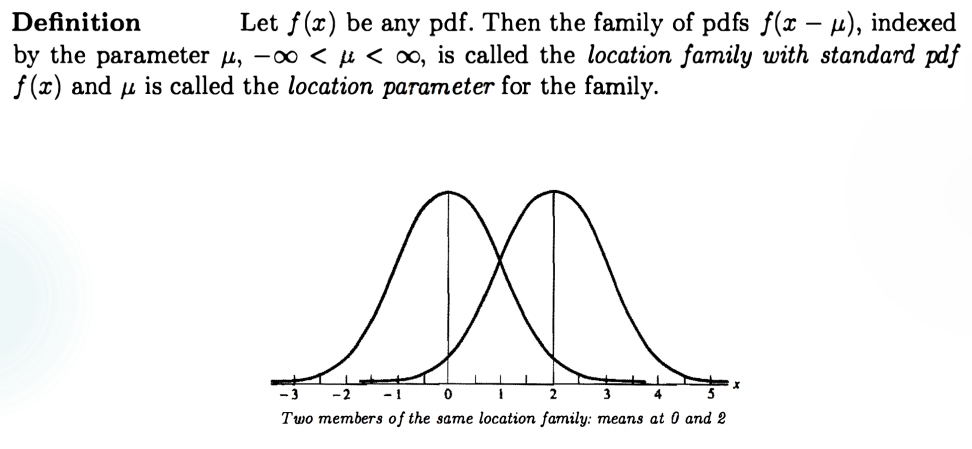
尺度族:取一个标准概率密度函数(standard PDF)\(f(x)\),尺度族中的其他函数 \(\frac{1}{\sigma} f(\frac{x}{\sigma})\) 相对于这个标准函数的偏差记为 \(\sigma\),称为 scale parameter(尺度参数).

位置-尺度族:取一个标准概率密度函数(standard PDF)\(f(x)\),位置-尺度族中的其他随机变量 \(X\) 有 PDF 为 \(\frac{1}{\sigma} f(\frac{x-\mu}{\sigma})\) ,当且仅当存在以 \(f(z)\) 为 PDF 的随机变量 \(Z\),从而有 \(X=\sigma Z+\mu\)。
这一定理可以用 CDF 法证明。
例子:\(Z\sim N(\mu,\sigma ^2)\),且 $X=aZ+b $,于是 \(X\sim N(a\mu +b,a^2 \sigma ^2 )\),相对于 standard distribution \(Y\sim N(0,1)\),location parameter 为 \(a\mu +b\),scale parameter 为 \(a\sigma\)。
Delta Method (Application Only)
就两个定理,也没证明。用于已知参数的分布 \(X\) 的函数 \(g(X)\),对其进行近似。第一个定理针对 \(g'(\mu) \neq 0\),第二个定理针对 \(g'(\mu)=0\) 的情况进行进一步近似。
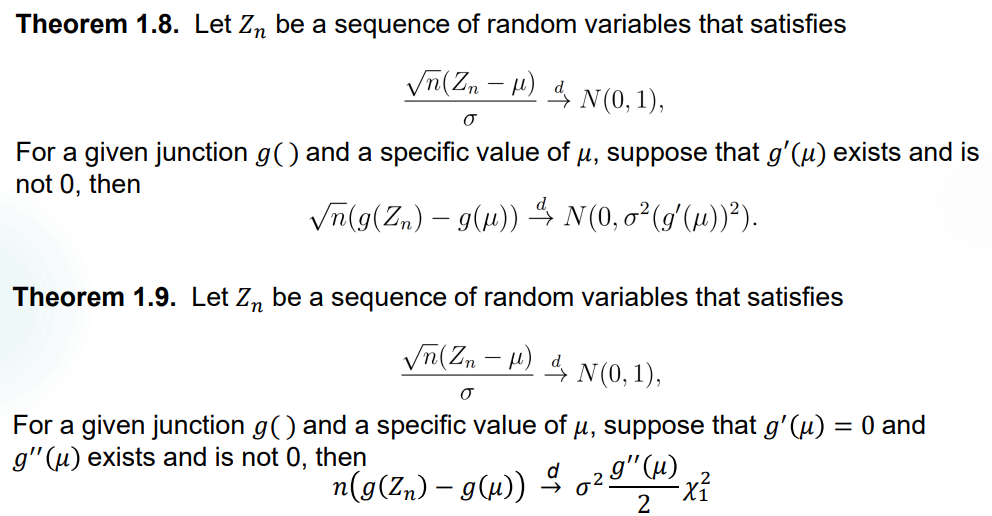
其他定理查阅
大数定律
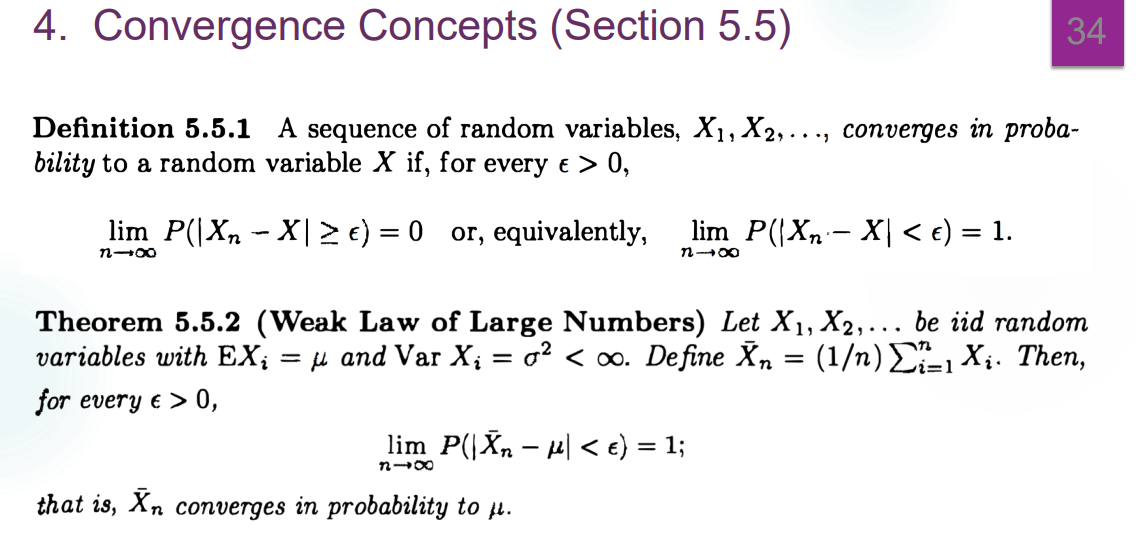
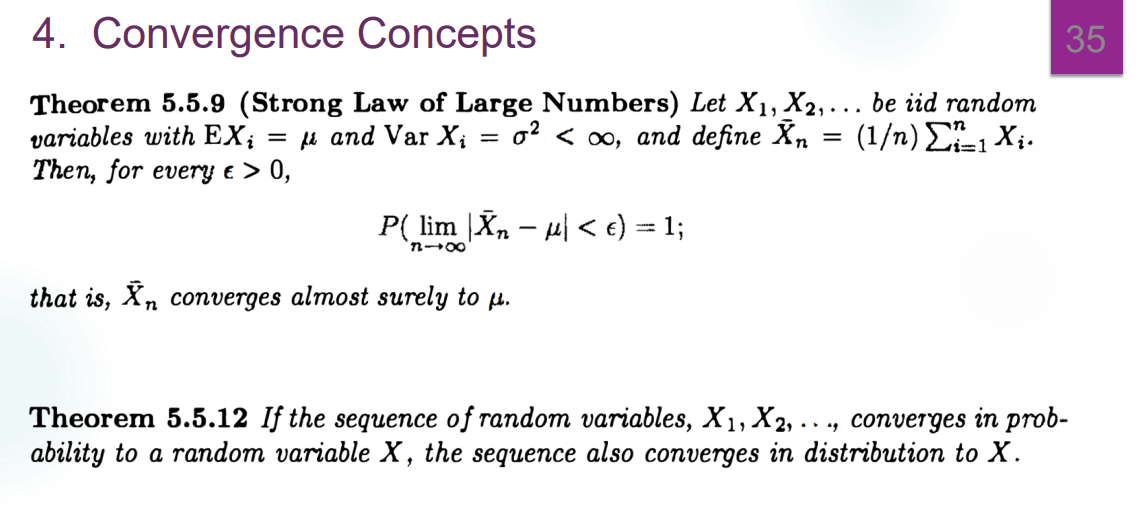
中心极限定理
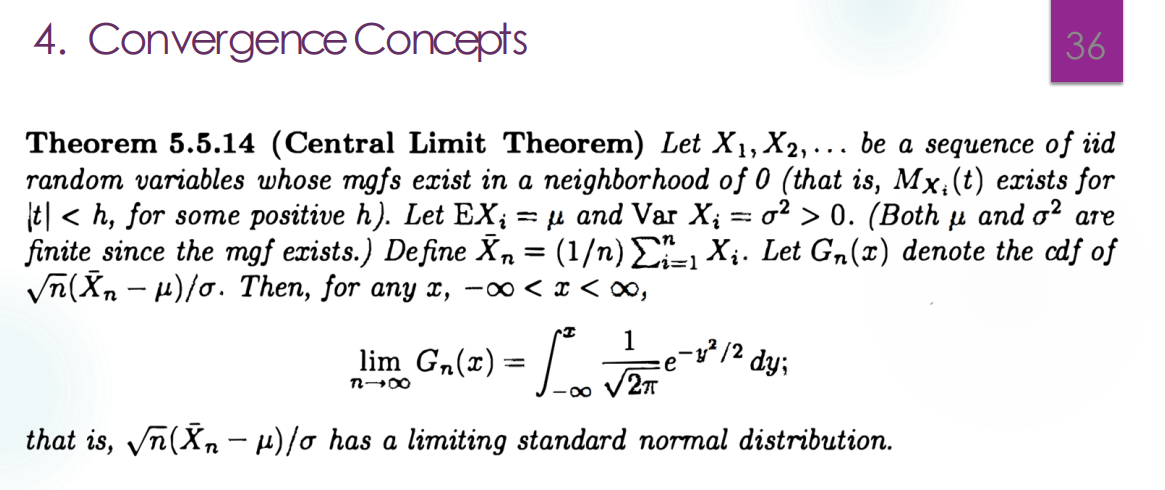
Slutsky's Theorem

Homework 1


Lecture 3
本节介绍数据简化原理,仍然围绕 Statistic 的选取展开。
Data don't make any sense, we will have to resort to statistics.
然而,每一个 statistic 的使用都不可避免地会遗失数据的细节。这些细节有时是没有用的,statistic 反而保留了最有用的部分(例如 parameter);有的时候是有用的,根据数据处理的目的,有可能需要重新选择 statistic。
充分统计量
定义和应用
Sufficient statistics:\(T(x)\) 是一个充分统计量当且仅当样本 \(X\) 在 \(T(X)\) 条件下的分布与 \(\theta\) 无关。
写作数学语言:\(P_\theta(X=x | T(X)=T(x)) = \frac{P_\theta (X=x)}{P_\theta(T(X)=T(x))} = \frac{p(x;\theta)}{q(T(x);\theta)}\) 与参数 \(\theta\) 无关。于是,验证一个 statistic \(T(x)\) 最直接的方法就是计算 \(x\) 的联合分布的概率密度,以及 \(T(x)\) 的概率密度,对二者求比值。
对一些特殊的分布,我们来寻找它们的充分统计量。
Bernoulli sufficient statistic:\(X_1,X_2,...,X_n i.i.d\sim B(1,\theta)\),则 \(T(X)=X_1+...+X_n\) 是 \(\theta\) 的充分统计量,可以通过 \(T(X)\sim B(n,\theta)\) 来验算。
Normal sufficient statistic:\(X_1,X_2,...,X_n i.i.d\sim N(\mu,\sigma^2)\),则 \(T(X)=\bar{X}\) 是 \(\mu\) 的充分统计量(注意不是 \(\sigma\) 的充分统计量),可以通过 \(T(X)\sim N(\mu,\frac{\sigma^2}{n})\) 验算。
Sufficient order statistic:\(X_1,X_2,...,X_n i.i.d\),population 的 PDF 是 \(f(x)\),于是全体次序统计量 \(X_{(1)},...,X_{(n)}\) 是充分统计量,因为 \(P(X_1=x_1,...,X_n=x_n | X_{(1)}=x_{(1)},...,X_{(n)}=x_{(n)}) = \frac{1}{n!}\)
Remark:这提示我们,次序统计量可以是多维的。
显然,这样寻找充分统计量是不现实的。以下有因子分解定理帮助我们寻找合适的 \(T(x)\):
Factorization theorem:设 $f(x;) $ 是 sample X 的联合概率密度函数,统计量 \(T(x)\) 是 sufficient statistic 当且仅当存在函数 \(g(t;\theta)\) 和 \(h(x)\),满足 \(f(x;\theta)=g(T(x);\theta)h(x)\)。
对离散条件的 Factorization theorem 进行证明:
左推右,trivial。右推左:
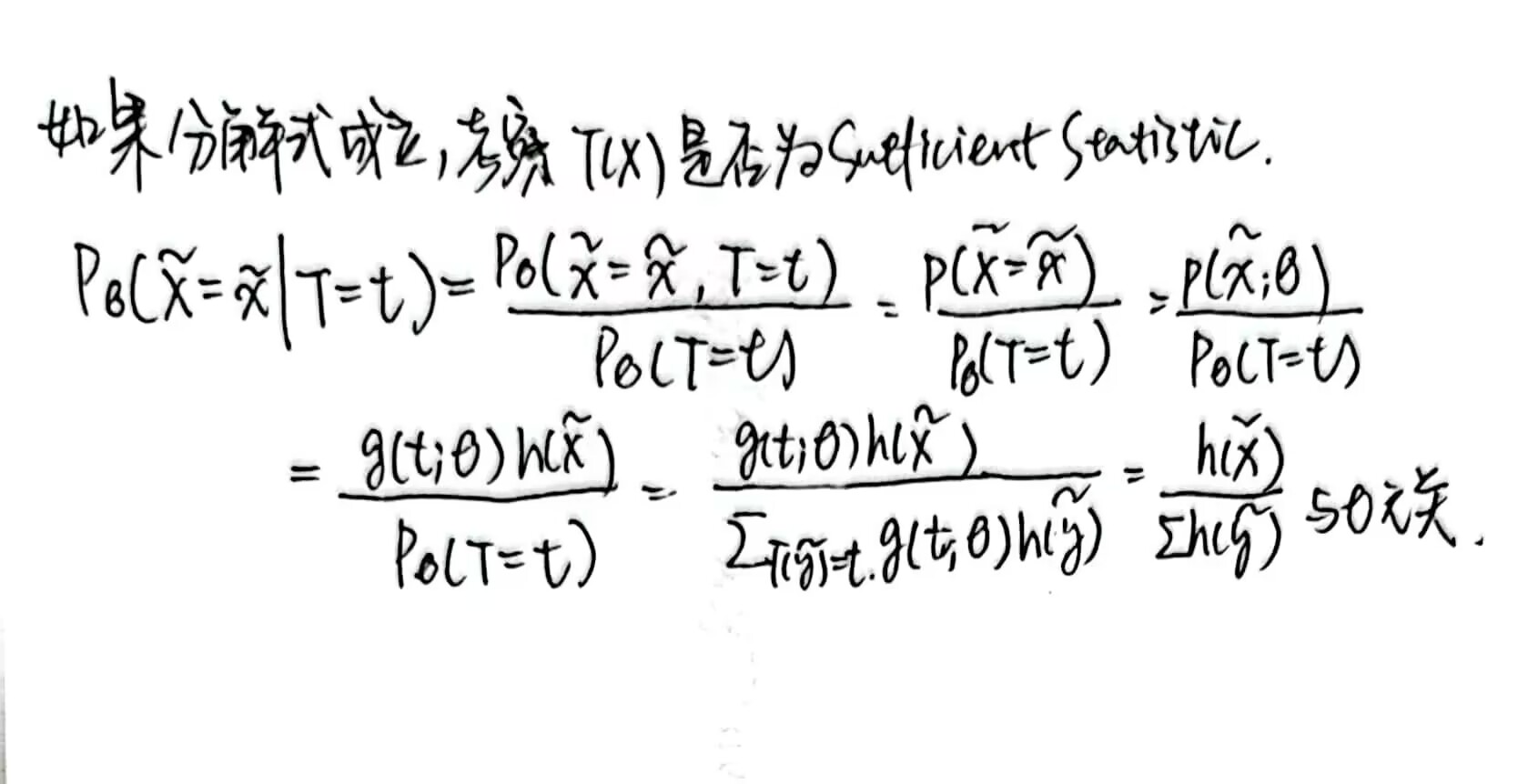
因此,由 Factorization theorem 可以知道,把 Joint PDF 里面 \(\theta,\bar{x}\) 不可分离的部分,以及 \(\theta\) 单独的部分取出放在一起,就可以从中找出 sufficient statistic。
应用数理统计的概率写法,求充分统计量
Uniform sufficient statistic:\(X_1,X_2,...,X_n i.i.d\sim Unif(\theta_1,\theta_2)\),寻找关于 \(\theta_1,\theta_2\) 的充分统计量。
事实上,Joint PDF 可以写成 \(f(x_1,x_2,...,x_n)=(\frac{1}{\theta_2-\theta_1})^nI_{\lbrace\theta_1 \leq x_1,x_2,...,x_n \leq \theta_2\rbrace}\),也即
\(f(x_1,x_2,...,x_n)=(\frac{1}{\theta_2-\theta_1})^nI_{\theta_1 \leq x_{(1)}}I_{x_{(n)} \leq \theta_2}\),于是 sufficient statistic 是 \(x_{(1)},x_{(2)}\)。
Exponential sufficient statistic:\(X_1,X_2,...,X_n i.i.d\sim exp(\lambda)\),寻找关于 \(\lambda\) 的充分统计量。
事实上,Joint PDF 是 \(f(\bar{x};\lambda)=\lambda^n e^{-\lambda(x_1+...+x_n)}=\lambda^ne^{-\lambda t} h(\bar{x})=g(t;\lambda)h(\bar{x})\),于是有 \(T(\bar{X})=X_1+X_2+...+X_n\) 是 sufficient statistic,而 \(h(\bar{x})=I_{x_i>0,i=1,2,...,n}\)。
还有很多例子,懒得举了
Exponential family 的 PDF 有比较好的性质: \(f(x; \theta) = c(\theta)h(x) exp[\Sigma_{j=1} ^{n} w_j(\theta) t_j(x)]\)
于是 Joint PDF 可以写为 \(f(\bar{x}; \theta) = c(\theta)^m \Pi_{i=1}^m h(x_i) exp[\Sigma_{j=1} ^{n} \Sigma_{i=1} ^m w_j(\theta) t_j(x_i)]\),因此这一样本的充分统计量是 \((\Sigma_{j=1}^m t_1(X_j),...,\Sigma_{j=1}^m t_n(X_j))\)。
充分统计量的性质
- \(T\) 是参数 \(\theta\) 的充分统计量,且 \(T=\phi(S)\),则 \(S\) 也是充分统计量。
- 如果 \(\phi\) 是一一对应,二者的信息量相同。
- 如果 \(\phi\) 不是一一对应,则 \(T\) 是 \(S\) 的一个精简而且还是充分统计量,是更有用的。
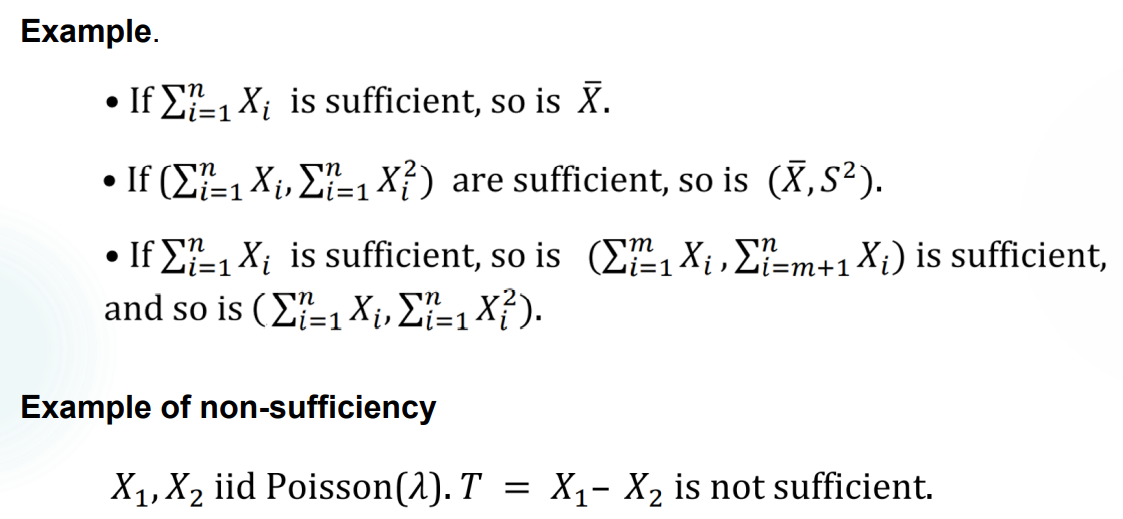
- Examples(懒得抄了):

极小充分统计量
sufficient statistic \(T^*(X)\) 被称为 minimal sufficient statistic 当且仅当:对任意充分统计量 \(T(X)\),存在函数 \(\psi\) 使得 \(T^*(X)=\psi(T(X))\)。也就是说,\(T^*(X)\) 实现了数据的最大简化。minimal sufficient statistic 的维度是最小的,它不一定唯一。
- 判定定理:\(f(x;\theta)\) 是 \(X\) 的 PDF,则对两个样本点 \(x\) 和 \(y\),\(f(x;\theta)/f(y;\theta)\) 是 \(\theta\) 的常函数当且仅当 \(T(x)=T(y)\),那么 \(T(X)\) 是 \(\theta\) 的 minimal sufficient statistic。证明如下:

举一些例子。
Normal minimal sufficient statistic:\(X_1,X_2,...,X_n i.i.d\sim N(\mu,\sigma^2)\),则 \((\bar{X},S^2)\) 是 \((\mu,\sigma^2)\) 的极小充分统计量。
Uniform minimal sufficient statistic:\(X_1,X_2,...,X_n i.i.d\sim Unif(\theta,\theta +1)\),则 \((X_{(1)},X_{(2)})\) 是 $$ 的极小充分统计量。
分别验证如下:
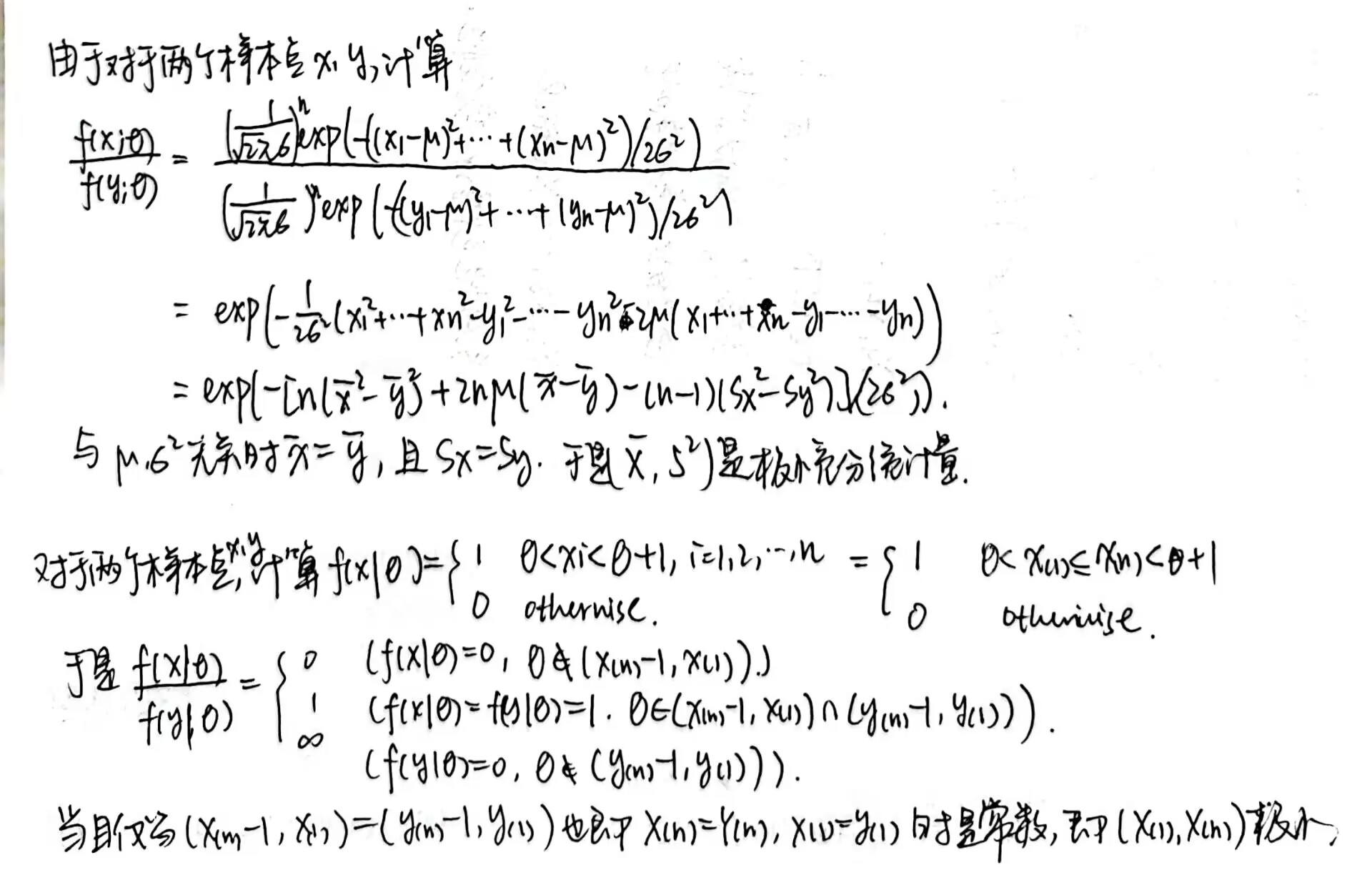
辅助统计量
定义
\(S(X)\) 是 ancillary statistic 当且仅当它的分布是 \(\theta\) 的常函数。比如说,常数就是一个 trivial ancillary statistic。
\(S(X)\) 是一阶 ancillary statistic,当 \(E(S(X))\) 也是 \(\theta\) 的常函数时。
举一些例子:
Uniform ancillary statistic:\(X_1,X_2,...,X_n i.i.d\sim Unif(\theta,\theta+1)\),则 \(X_{(n)}-X_{(1)}\) 是辅助统计量。验证如下:
Location ancillary statistic:\(Z_1,Z_2,...,Z_n\) 是服从 \(F(x)\) 的 Population 中的样本,位置参数为 \(\theta\),于是 \(X_1=Z_1+\theta,...,X_n=Z_n+\theta\),故 \(r=X_{(n)}-X_{(1)}\) 是 ancillary statistic,因为
$F(r;)=P(Rr;)=P(maxX_i-minX_i r)=P(max Z_i-minZ_i r)=P(Z_{(n)}-Z_{(1)}r) $
这是和 \(\theta\) 无关的量。所以,location ancillary statistic 还可以是 \(X_{(n-1)}-X_{(3)}\),等等。
Scale ancillary statistic:同理,\(X_i/X_j\) 都是 ancillary statistic,因为可以归一为 \(Z_i/Z_j\)。由统计量的函数性质可知,\(\frac{X_1+...+X_n}{X_i}\) 是形式比较好的 ancillary statistic。
辅助统计量的性质
- \(V(X)\) 是 nontrivial ancillary statistic,于是 \(\lbrace x:V(x)=v\rbrace\) 不包含任何 \(\theta\) 的信息。
- \(T(X)\) 是 statistic,如果 \(V(T(X))\) 是 nontrivial ancillary statistic,那么 \(T\) 的简化中仍然不含有 \(\theta\),需要进一步进行简化。
- 如果一个 sufficient statistic \(T(X)\) 没有非常值函数是 ancillary statistic,那么它在简化数据中是最优的。
完全统计量
定义
\(X\sim F=\lbrace f(x;\theta),\theta \in \Theta \rbrace\) 是一个分布族,\(\Theta\) 是参数空间。记 \(T=T(X)\),如果对于任意函数 \(\psi\),如果 \(E_\theta \psi(T(X))=0,\forall \theta \in \Theta\),那么一定有 \(P_\theta(\psi(T(X))=0)=1,\forall \theta \in \Theta\)。
听起来很抽象,举几个例子:
\(X=(X_1,X_2,...,X_n)\) 是来自于 \(B(1,\theta)\) 的随机样本,那么 \(T(X)=\Sigma_{i=1} ^n X_i\) 对于参数 \(\theta\) 是一个 complete statistic。验证如下:
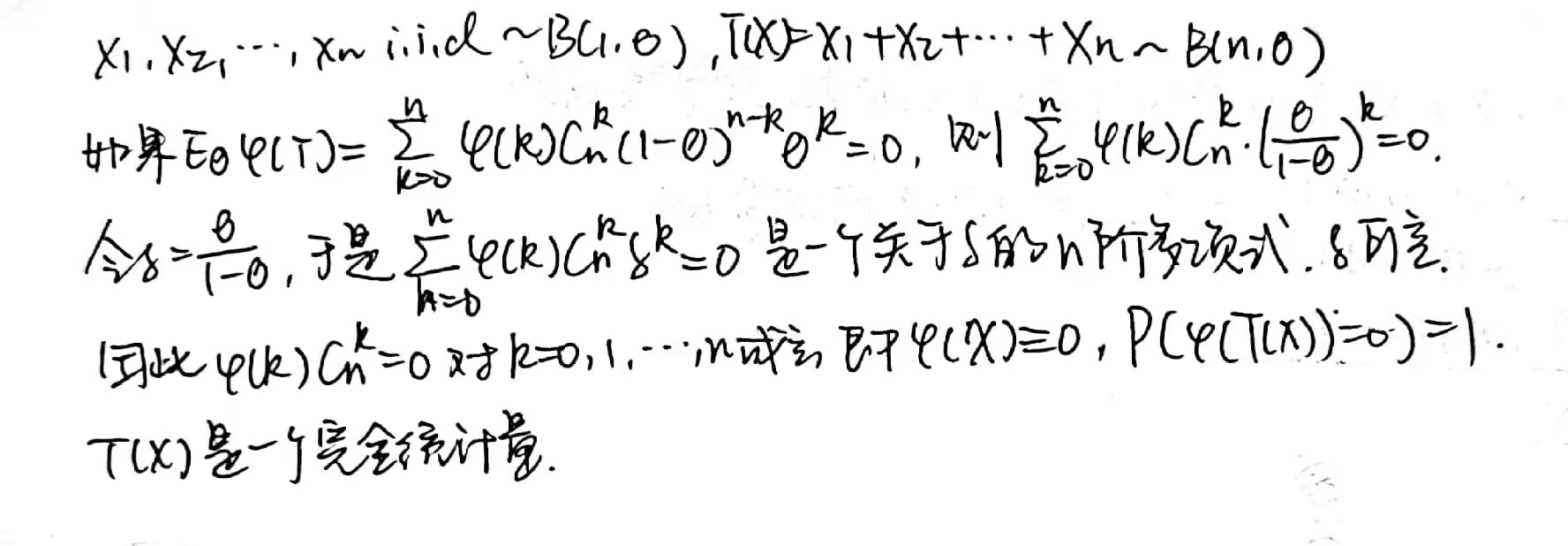
\(X=(X_1,X_2,...,X_n)\) 是来自于 \(Unif(0,\theta)\) 的随机样本,那么 \(T(X)=X_{(n)}\) 对于参数 \(\theta\) 是一个 complete statistic。验证如下:

complete statistic 不一定存在。
指数族中的完全统计量
指数分布族的 PDF 有形式: \(f(x; \theta) = c(\theta)h(x) exp[\Sigma_{j=1} ^{n} w_j(\theta) t_j(x)]\)
于是如果参数空间 \(\Theta\) 包括 \(R^k\) 的开集,则统计量 \(T(X)=(\Sigma_{i=1} ^m t_1(X_i),...,\Sigma_{i=1} ^m t_n(X_i))\) 是一个 complete statistic。
Remark:定理中要求开集是为了防止一些特殊情况,比如:
完全统计量的性质
如果 minimal sufficient statistic 存在,那么任何 complete statistic 都是 minimal sufficient 的。
Basu Theorem:如果 \(T(X)\) 是 (minimal) complete & sufficient statistic,那么它和任何 ancillary statistic 独立。这是一个很好的性质,因为直观上来看 ancillary statistic 是和任何 sufficient statistic 独立的而现实并非如此,而这个定理可以给出一个补充条件。
Basu Theorem 的应用:
设 \(X_1,...,X_n i.i.d\sim U(\theta_1,\theta_2)\),证明 \(\frac{X_{(i)} - X_{(1)}}{X_{(n)}-X_{(1)}}\) 与 \((X_{(n)},X_{(1)})\) 独立。
\(X_{(n)}\) 是 complete statistic,\((X_{(n)},X_{(1)})\) 是 minimal sufficient statistic,于是也是 minimal complete & sufficient statistic,只要证明 \(\frac{X_{(i)} - X_{(1)}}{X_{(n)}-X_{(1)}}\) 是 ancillary statistic 即可。
而这是一个位置-尺度分布族,需要先正规化为 \(Y_i = \frac{X_i-\theta_1}{\theta_2-\theta_1}\),则有 \(Y_1,Y_2,...,Y_n i.i.d.\sim U(0,1)\),于是 \(\frac{X_{(i)} - X_{(1)}}{X_{(n)}-X_{(1)}}=\frac{Y_{(i)}-Y_{(1)}}{Y_{(n)}-Y_{(1)}}\),从而是 \(\theta\) 的常函数,为 ancillary statistic。
设 \(X_1,...,X_n i.i.d\sim N(\mu,\sigma^2)\),证明 \(\bar{X}\) 和 \(S^2\) 是独立的。
实际上,这个问题在 Lecture 2 中我们使用正交矩阵证明过,此处再给出一个 Basu Theorem 下的证明。事实上,我们已经知道对于已知的 \(\sigma^2\),有 \(\bar{X}\) 是 complete & sufficient,而 \(S^2\) 是 ancillary,所以二者独立。
似然原理
如果 \(f(x;\theta)\) 是样本 \(X=(X_1,X_2,...,X_n)\) 的 Joint PDF,则记 \(\theta\) 的函数 \(L(\theta;x)=f(x;\theta)\) 为似然函数(Likelihood Function),有时也写作 \(L(\theta)\) 以突出变量。
Log Likelihood:\(l(\theta;x)=log L(\theta;x)\)。
Likelihood Principle:
- 用参数族 \(\Theta\) 中的不同参数 \(\theta_1,\theta_2\) 进行比较 \(L(\theta_1;x)>L(\theta_2;x)\),那么 \(\theta_1\) 比起 \(\theta_2\) 是一个更好的真实值的选择。从而可以在参数未知的情况下,对真实的 \(\theta\) 进行推断。
- 样本点 \(x,y\) 满足 \(L(\theta;x)\) 和 \(L(\theta;y)\) 之间成比例,即存在 \(L(\theta;x)=C(x,y)L(\theta;y)\),那么从 \(x,y\) 出发对 \(\theta\) 做如上推断,得到的结果是相同的。
Equivalence Principe:如果 \(Y=g(X)\) 是一个度量尺度变换,且 \(Y\) 的模型和 \(X\) 的模型具有相同的形式结构,则推断方法应同时满足度量同变和形式不变。
Lecture 4
本节介绍 Fisher Information 和 Point Estimation。
Fisher Information
定义
取 \(f(x;\theta),\theta \in \Theta\) 作为一个分布族,则 score function 定义为 \(S(x;\theta)=\frac{\partial log L(\theta)}{\partial \theta}=\frac{1}{f(x;\theta)} \frac{\partial f(x;\theta)}{\partial \theta}\)。
对于一个给定的 \(\theta\),可知 \(E[S(X,\theta)]=0,E[S(X,\theta)]^2=I(\theta)\),后者就是 Fisher Information。
因此,\(Var[S(X;\theta)]=E[S(X;\theta)]^2- E^2[S((X;\theta))]=I(\theta)\)
对于一个 score function 有较大方差的分布,我们希望能够较为容易地估计 \(\theta\)。
\(I(\theta) = E[S(X;\theta)]^2 = -E(\frac{\partial^2}{\partial \theta^2} logL(\theta))\)
与熵的关系
relative entropy:\(KL(p:q)=\int p(x)log \frac{p(x)}{q(x)} dx\),
定义:
\(D(\theta,\theta + \Delta \theta)=KL(f(x;\theta):f(x,\theta+\Delta \theta)) = -\int f(x;\theta)[log f(x,\theta + \Delta \theta)-log f(x;\theta)] dx\)
经过 Taylor 展开:
\(log f(x,\theta + \Delta \theta)-log f(x,\theta) = \frac{\partial log f(x,\theta)}{\partial \theta} \Delta \theta + \frac{1}{2} \Delta \theta^\prime \frac{\partial^2 log f(x,\theta)}{\partial \theta^\prime \partial \theta} \Delta \theta + o(||\Delta \theta||^2)\)
于是:
\(D(\theta,\theta+\Delta \theta) = -E[\frac{\partial log f(x,\theta)}{\partial \theta}]\Delta \theta - \frac{1}{2} \Delta \theta^\prime E[\frac{\partial^2 log f(x,\theta)}{\partial \theta^\prime \partial \theta} ]\Delta \theta + o(||\Delta \theta||^2) = -\frac{1}{2}\Delta \theta^\prime I(\theta) \Delta \theta\)
Remark: Fisher Information 越大,越能够区分参数。
充分统计量和辅助统计量
不是很懂。贴个图吧。
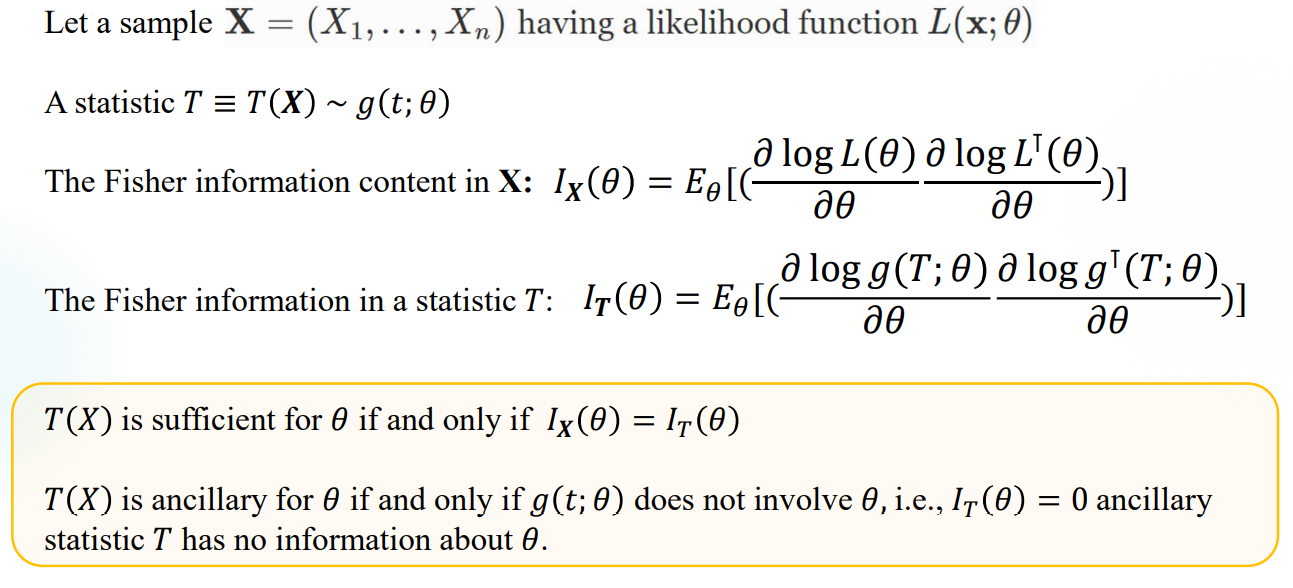
点估计
定义
- Example 1:\((X_1,X_2,...,X_n)i.i.d \sim N(\mu,\sigma^2)\),我们想找到两个参数比较好的一个估计,可以考虑 \(\mu = \bar{X},\sigma^2 = S^2\)。这是非常典型的估计量,因为 \(E(\bar{X})=\mu,E(S^2) =\sigma^2\) ,因此是无偏的。
- Example 2:\((X_1,X_2,...,X_n)i.i.d \sim P(\lambda)\),于是考虑 \(P(X_1=x_1,...,X_n=x_n)\)可知 \(T(X)= X_1+...+X_n \sim P(n \lambda )\) 是一个充分统计量,\(E(T(X))=\lambda\)。
- 实际上,样本的任意一个 statistic 都是它的点估计量(point estimator),实际观测值称为估计值,即 estimate,它是一个数值。
好的性质
无偏性。对于 population \(\lbrace f(x;\theta):\theta \in \Theta \rbrace\) 中的随机抽样 \(X=(X_1,...,X_n)\),\(g(\theta)\) 是定义在参数空间 \(\Theta\) 上的函数,一个 \(g(\theta)\) 的估计量,\(\hat{g}(X)=\hat{g}(X_1,...,X_n)\) 是 unbiased 如果 \(E_\theta [\hat{g}(X)]=g(\theta),\theta \in \Theta\)。否则是有偏的。
定义 systematic error 为 \(E(\theta)-\theta\),则无偏即为 systematic error 为 0.
说句人话,就是求某个 estimator 的期望是不是 \(\theta\),如果是的话就是无偏的。
有效性。对于两个 estimators \(\hat{g}_1(X),\hat{g}_2(X)\),如果 \(Var(\hat{g}_1(X))\leq Var(\hat{g}_2(X))\) 对任意 \(\theta \in \Theta\) 成立,并且参数空间中至少有一个 \(\theta\) 使上述式子不取等号,那么称 \(\hat{g}_1 (X)\) 相比 \(\hat{g}_2(X)\) 更有效。
相合性。
对任意样本量为 \(n\) 的样本,记 \(\hat{g}_n(X) = \hat{g}_n (X_1,...,X_n)\) 是一个 estimator,如果 \(\hat{g}_n(X)\) 依概率收敛到 \(g(\theta)\),也即,对任意的 \(\theta \in \Theta\),\(\varepsilon >0\),有 \(\lim_{n\to \infty} P_\theta (|\hat{g}_n (X) -g(\theta)| \geq \varepsilon)=0\),那么 \(\hat{g}_n(X)\) 被称为一个 \(g(\theta)\) 的 weakly consistent estimator。
如果对任意 $$,有 \(P_\theta (lim _{n \to \infty} \hat{g}_n (X)=g(\theta))=1\),则称其为 strongly consistent estimator。
如果对任意 \(\theta \in \Theta ,r>0\),有 $lim {n } E|_n(X)-g()|^r = 0 $,则称其为 \(g(\theta)\) 的 \(r\) 阶 consistent estimator。
Example 1:(这个对我来说还是一下子难以想到..归根结底是初概这一部分没学会,要补)
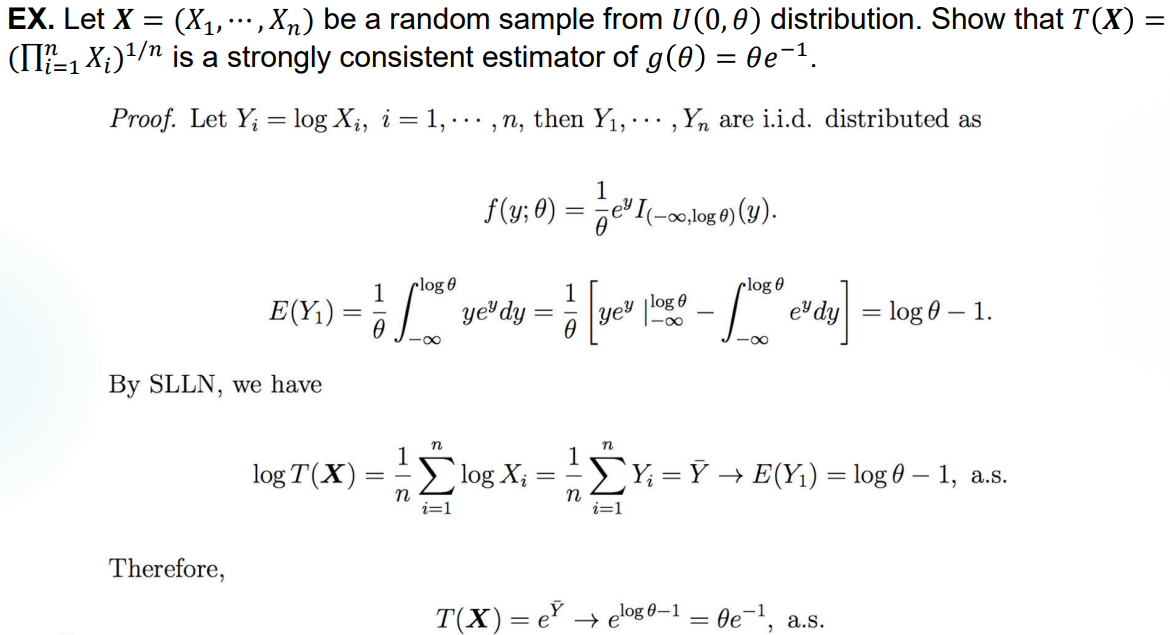
评价点估计的方式——MSE
Mean Squared Error(MSE):对于一个 estimator \(T\) 和一个参数 \(\theta\),MSE 定义为:
\(MSE(T)=MSE_\theta(T)=E_\theta((T-\theta)^2)=Var_\theta(T)+(Bias_\theta (T))^2\),
其中,\(Bias_\theta (T)=E_\theta(T)-\theta\)。于是对于一个无偏的 \(T\),它的 MSE 就是方差。
如果有某个 \(\hat{g}^*(X)\) 使得对任意的 estimator \(\hat{g}(X)\) 都有 \(E_\theta(\hat{g}^* (X)-g(\theta))^2 \leq E_\theta(\hat{g} (X)-g(\theta))^2\) 对任意的 \(\theta \in \Theta\) 成立,则称其为 uniformly minimum MSE estimator,不一定存在。
往往需要在 bias 和 MSE 之间进行权衡,二者不一定同时最小。
Example 1:


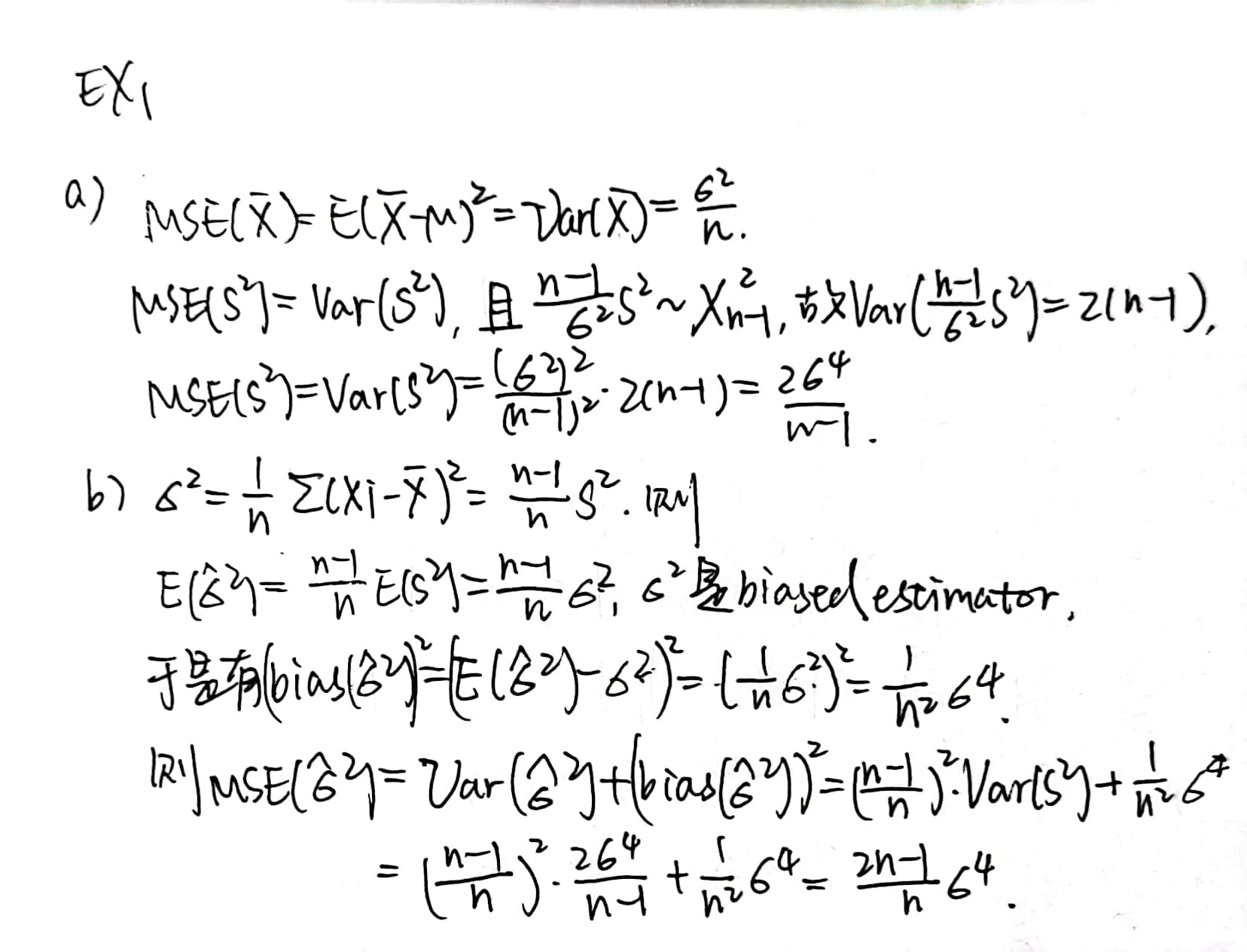
Example 2:


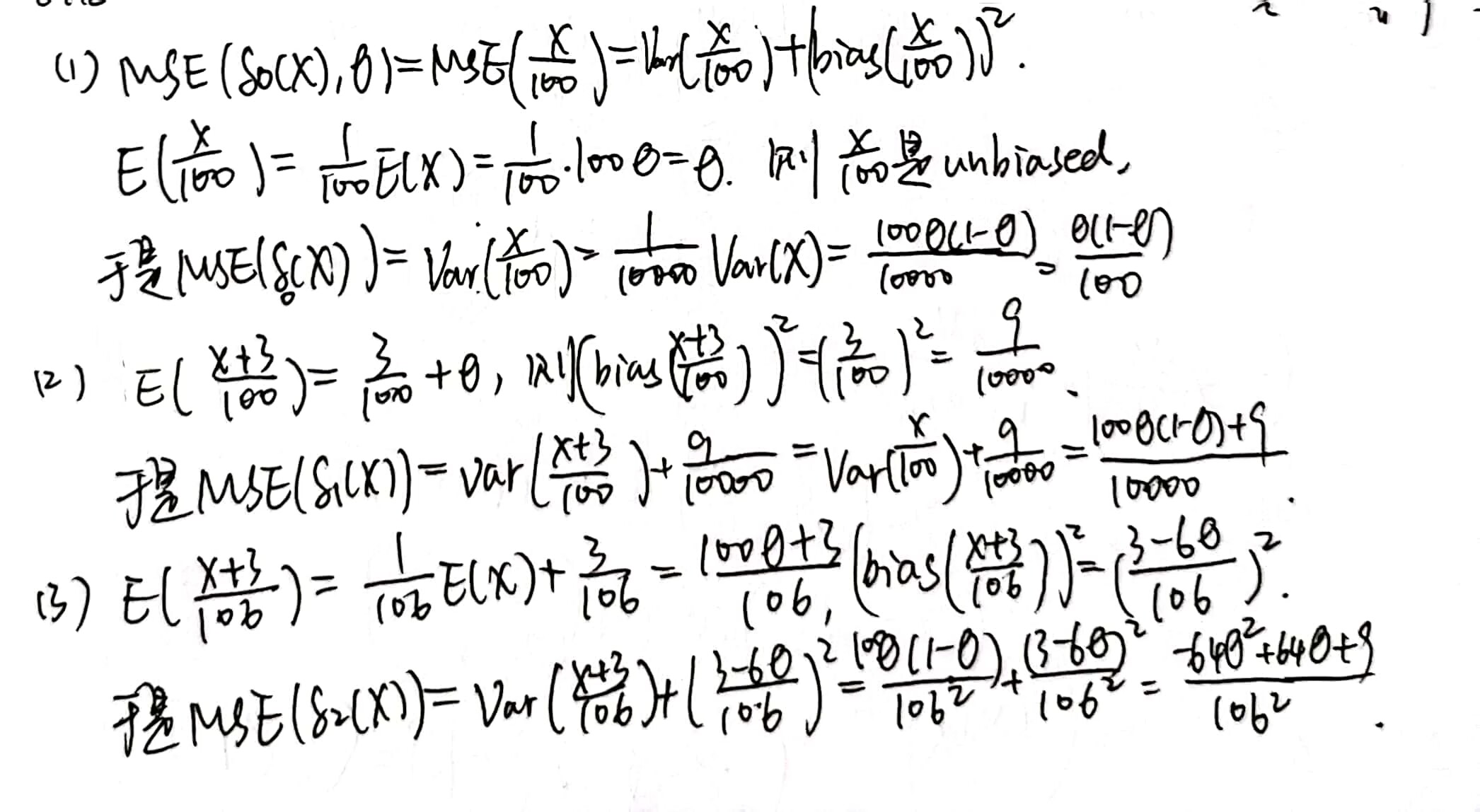
求估计量的方法——矩法
\(X_1,X_2,...,X_n\) 是来自于以 \(f_\theta(x)\) 为 PDF 的有有限 \(k\) 阶矩的随机样本,\(\theta=(\theta_1,...,\theta _k) \in R^k\) 是未知的。定义:
- Sample moment:\(m_1 = \frac{1}{n} \Sigma_{i=1} ^n X_i,m_2=\frac{1}{n}\Sigma_{i=1} ^n X_i^2,...\)
- Population moment:\(\mu_1 = E(X_1)=h_1(\theta),\mu_2=E(X_1 ^2)=h_2(\theta),...\)
Method of Moment(MOM)approach:对于未知的 \(\theta=(\theta_1,...,\theta_k)\),可以通过求解 \(k\) 个方程 \(m_i=h_i(\theta)\) 来确定它们每个的 estimator,\(k\) 个方程确定 \(k\) 个“未知数”,很合理。
事实上,这样解出来的 estimator 称为 moment estimator,也有可能解不出来。
Example 1:

矩法得到的 moment estimator 不一定唯一,比如取前 \(k\) 个方程和取后 \(k\) 个方程得到的结果可能是不一样的,有很多例子。为了计算方便,我们尽量会取低阶矩。为了 unbiasedness,往往会取中心矩。
MOM estimator 的性质:
无偏性:样本原点矩一般都无偏,其余的没有一致的论断。
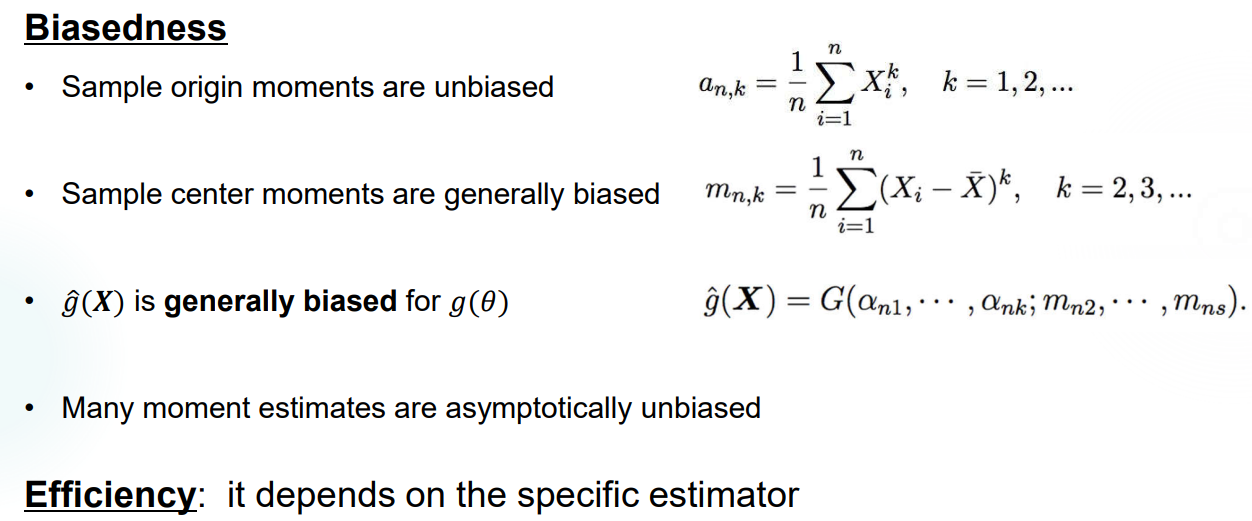
相合性:

MOM 的优缺点:
- 简单好算,不用知道分布。
- 样本较小时可能不精确,不一定完全反映样本的特征(漏参数)。
Homework 2

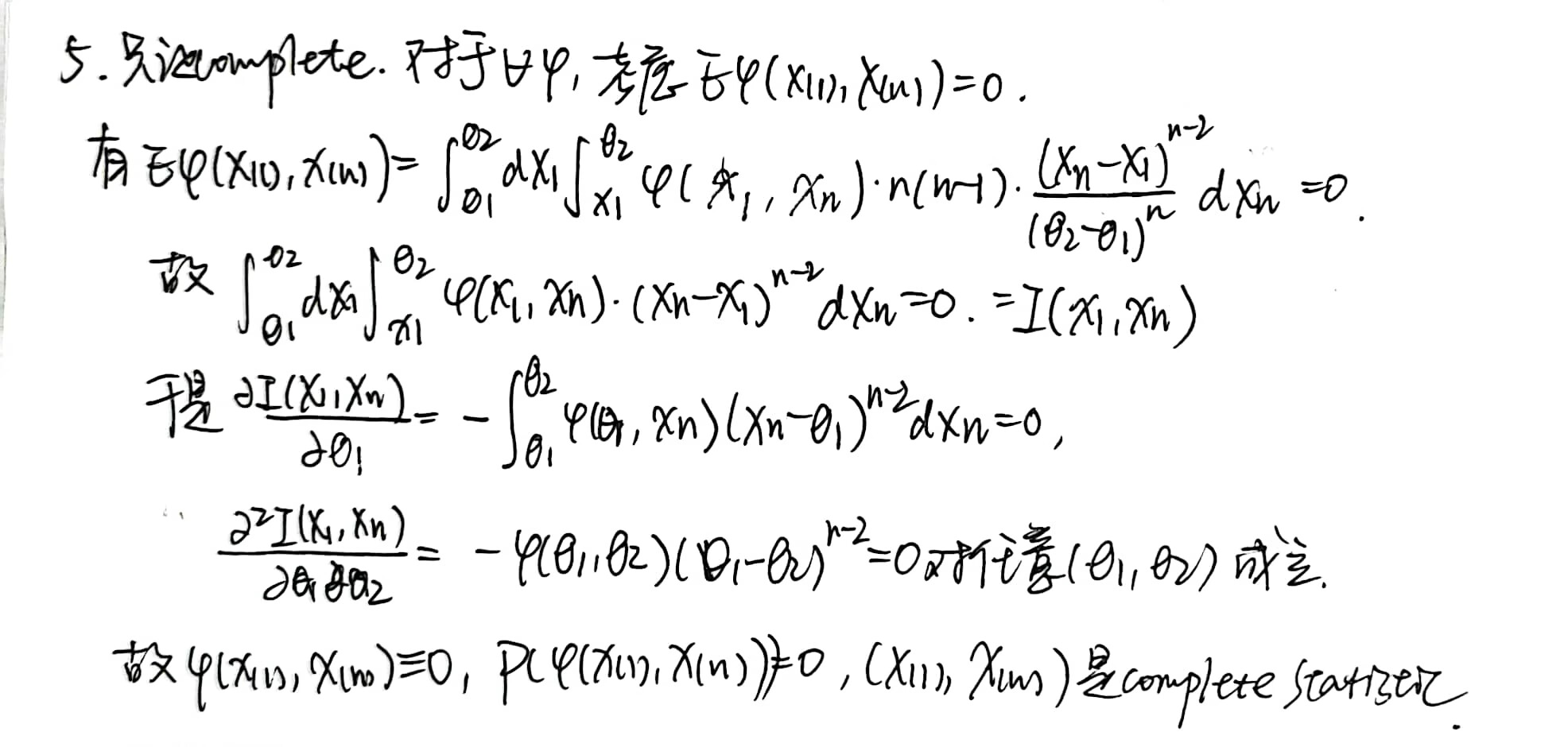
Lecture 5
本节介绍另一种点估计方法——Maximum Likelihood Estimator,这是最为流行的方法。
没想到的是这一讲还讲了一些数值方法,收敛到数值分析去了,我血赚(x
极大似然估计量 (MLE)
定义
找一个使得似然函数的值最大的常数 \(\theta\),其函数作为一个 estimator,称为 maximum likelihood estimator。
MLE 的求法不一定是求导,先看看求导能不能做 && 算出来的结果对了没有 && 有没有更简单的方法
举个超几何分布的例子,这个问题的主要难度其实在于意识到,\(X\) 单点就是一个观测值,以及用离散方法。
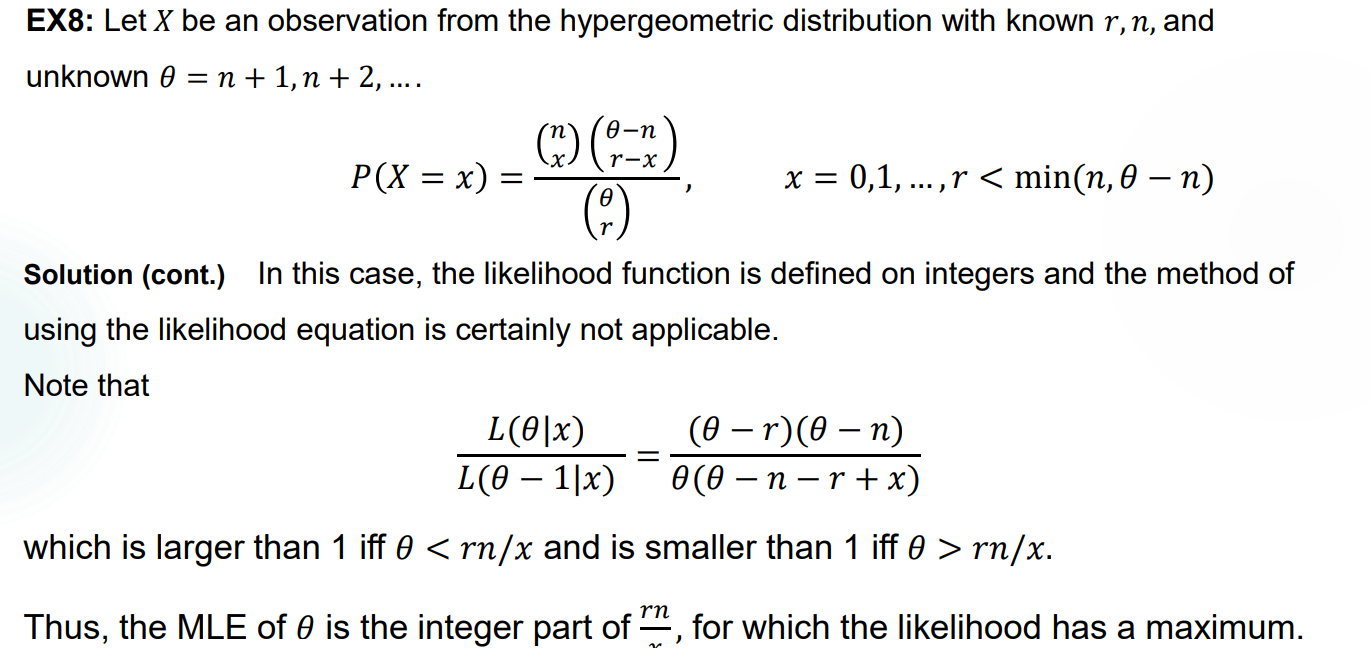
性质
Invariance Property:如果 \(\hat{\theta} _{MLE}\) 是 \(\theta\) 的 MLE,且 \(g\) 是任意的函数,则 \(g(\hat{\theta} _{MLE})\) 是 \(g(\theta)\) 的 MLE。
Consistency:在某些条件下,MLE 序列依概率收敛到某个 \(\theta\) 值。(非常模糊,看看就好
MLE & sufficient statistic:\(X=(X_1,X_2,...,X_n)\) 是 Population 中的一个随机抽样,Population 服从 \(\lbrace f(x;\theta),\theta \in \Theta \rbrace\) 的分布。如果 \(T=T(X_1,...,X_n)\) 是一个充分统计量,且 \(\theta\) 的 MLE 存在,那么 \(\hat{\theta}=\psi(T)\) 是 \(T\) 的一个函数。
Asymptotic normality:在某些情况下,MLE \(\hat{\theta}\) 的序列(作为一个未赋值的随机变量)趋近于正态分布,准确来说,\(\sqrt{n} (\hat{\theta}_n - \theta) \to N(0,\sigma_\theta ^2),n\to \infty\)。其中,\(\sigma_\theta ^2 = \frac{1}{I(\theta)}\),\(I(\theta)\) 是 \(X\) 的概率密度函数 \(f(x;\theta)\) 导出的 Fisher Information。
如果使用 Delta Method,可以导出 \(\sqrt{n}[g(\hat{\theta}_n)-g(\theta)] \to N(0,(g'^2(\theta)/I(\theta)))\)。
以上均为依分布收敛。
相比于矩法,MLE 方法有求解更快的优点,但有时缺乏数值稳定性,且必须知道 Population 的分布。
MLE 的数值解法
- 主要是使用牛顿法求解没有显式解的一阶微分方程。
MLE 的应用
标记重捕法:标记重捕过程实际上可以视为超几何分布过程,使用关于 \(\theta\) 的 MLE 估计即可。例如,第一次捉住了 10 只蜻蜓,全部做标记后放归。第二次捕捉 20 只蜻蜓后发现其中 4 只做了标记,希望求得种群数量 \(N\) 的估计值。实际上,记第二次捕获的蜻蜓里有 \(r\) 只做了标记,\(N\) 可以被视为随机变量 \(r\) 的分布中的参数,即 \(L(N;r)=f(r;N)=\frac{C_{10} ^r C_{N-10}^{20-r}}{C_N ^{20}}\),得到 \(N\) 的 MLE 为 \(\hat{N}=[\frac{200}{r}]\),种群总数为 50 只的概率最大。
Hardy-Weinberg Law: 一个二倍体基因型包括两个基因,每个基因有两种表示,A 和 a。在人群中随机抽样得到 56 人中有 13 个为 AA 型,24 个为 Aa 型,19 个为 aa 型。求此基因显示为 A 的概率的 MLE。
实际上可以将以上抽样视作对一个服从 \(B(112,\theta)\) 的 Population 进行抽样,得到一个容量为 112 的样本,其中抽取得到 50 个 A 和 62 个 a。考虑此样本的 Joint PDF 为 \(f(X)=C_{112} ^{50} \theta ^{50} (1-\theta) ^{62}\) 取最大值时,\(\theta=\frac{25}{56}\) 即为解。
Lecture 6
本节重新介绍 Fisher Information,并给出最后一种点估计方法——UMVUE。
Regular Condition
一共有五条,分别提示了开集,概率密度为正,对参数的导数存在,对参数的求导和对 x 的积分可交换,Fisher Information 有限。
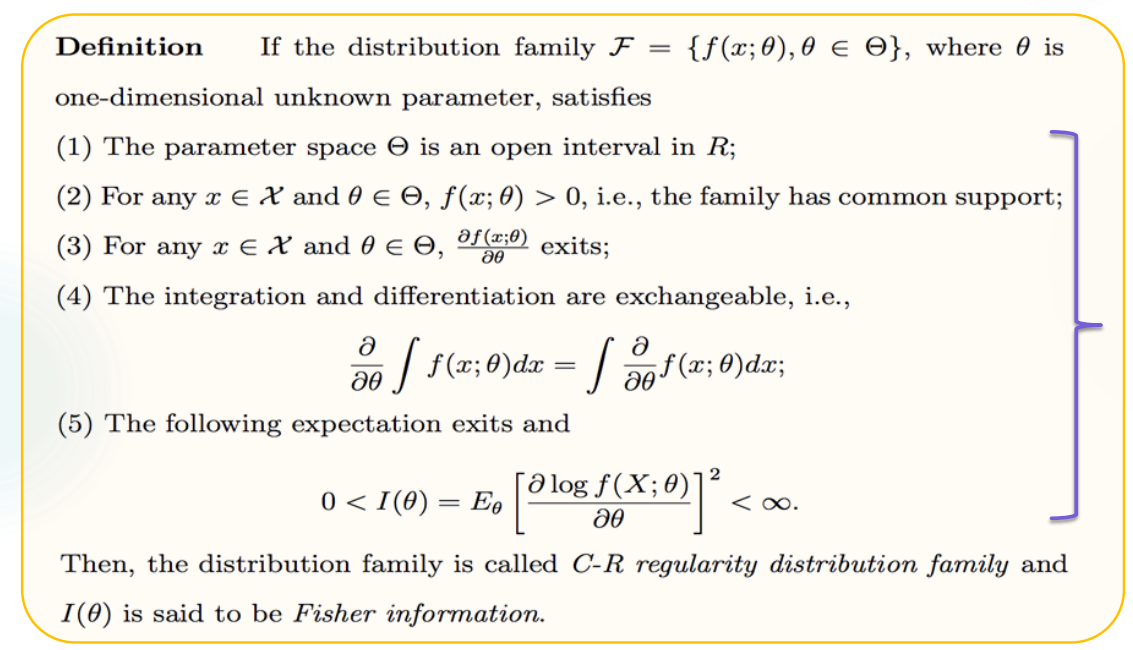
Revisit Fisher Information
Random Sample 的 Fisher Information
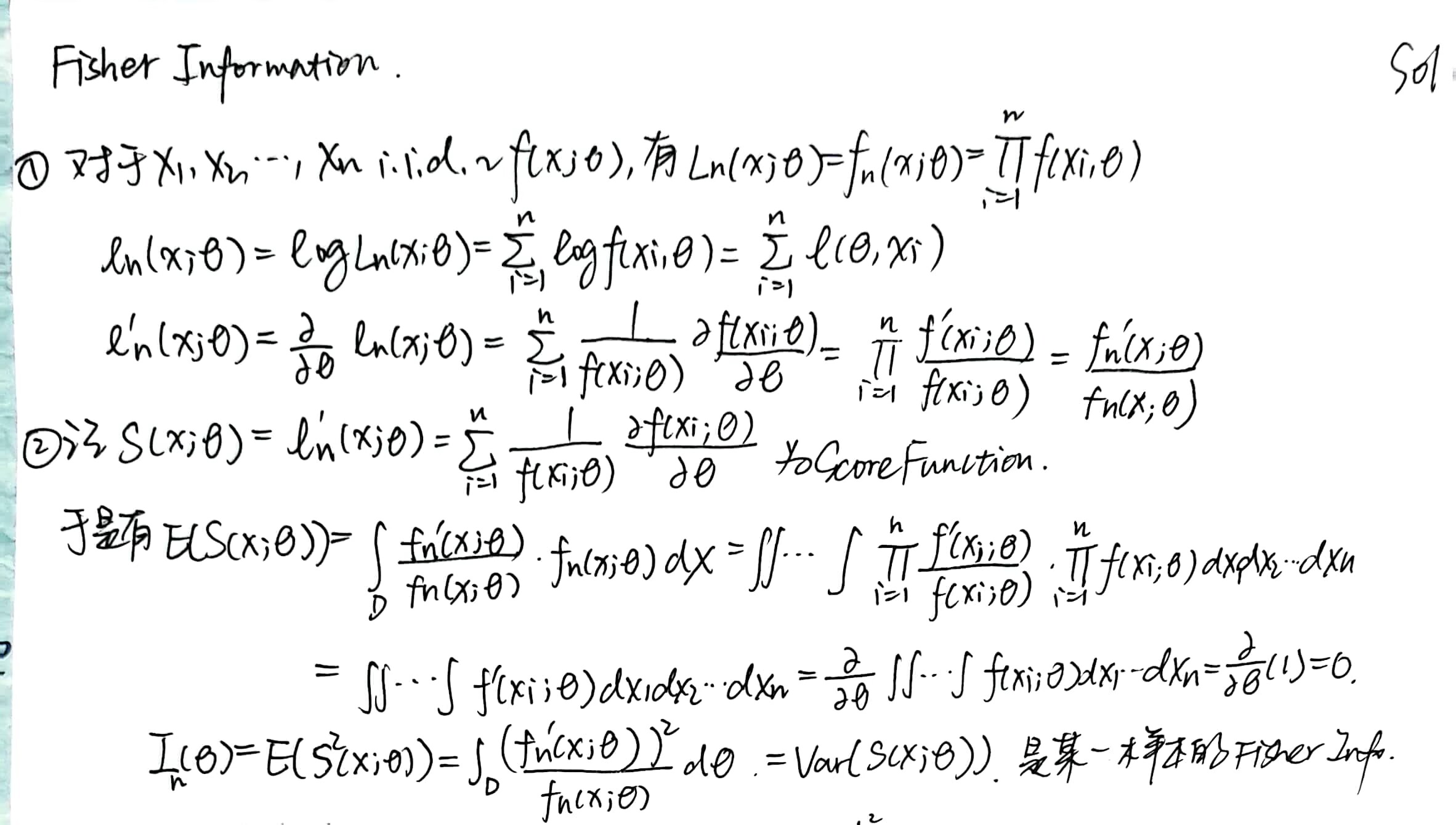
Population 的 Fisher Infomation
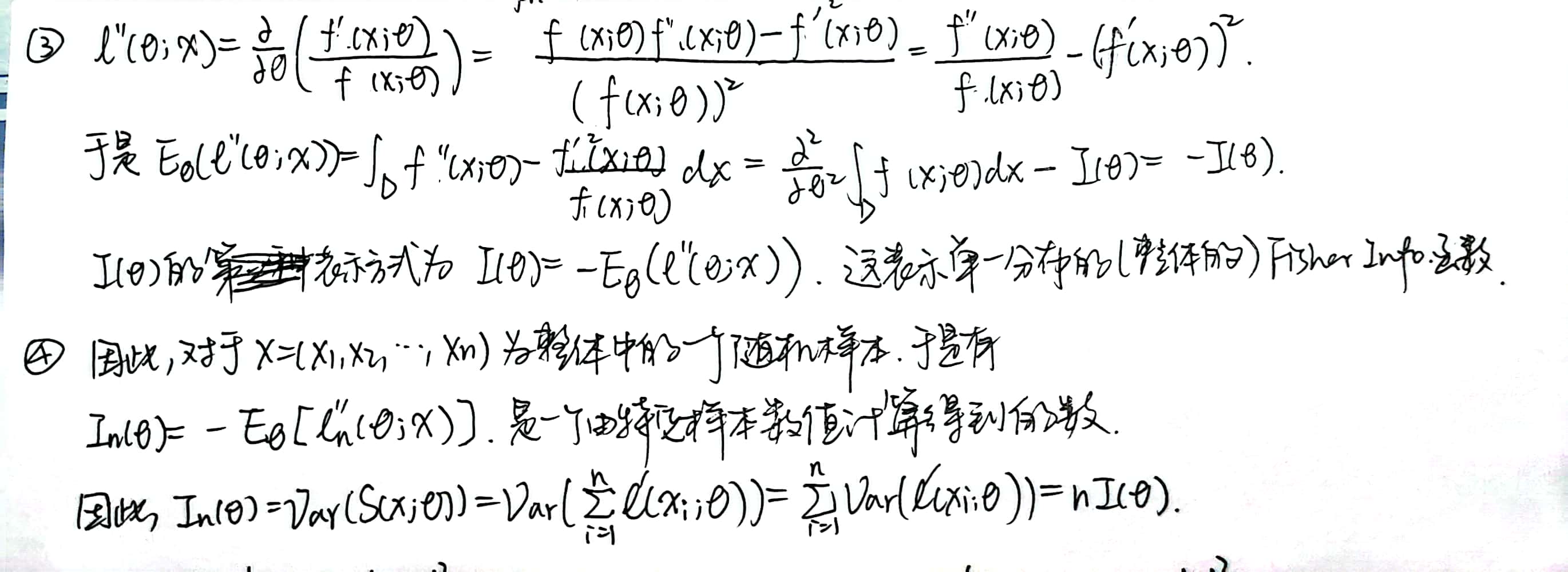
Example 1:对于\(X\sim N(\mu,\sigma ^2), \sigma^2\) 已知,求 \(I(\mu)\)。

对于一个 estimator 序列 \(\lbrace \hat{\theta}_n \rbrace\),有 \(\sqrt{n} (\hat{\theta}_n -\theta _0) \to N(0,\frac{1}{I(\theta _0)})\) 依分布收敛。考虑正态分布的性质可知,有 \(\hat{\theta}_n -\theta _0 \to N(0,\frac{1}{nI(\theta _0)})\)。其中 \(\theta_0\) 表示参数的真值。
UMVUE
定义
The best unbiased estimator 是方差最小的无偏估计量,因此其 MSE 也最小。也可以指 UMVUE,也即 uniformly minimum variance unbiased estimator,一致最小方差无偏估计。其中的 uniformly 指的是对所有的参数都成立。
当然,一个样本可能不存在 unbiased estimator,也就没有 UMVUE,比如:
\(X_1,X_2,...,X_n i.i.d. \sim B(1,p)\),\(g(p)=\frac{1}{p}\) 是要进行估计的量,它没有无偏估计量。

每个无偏估计都是 sufficient estimator 的函数。
验证 UMVUE
对于随机抽样 \(X_1,X_2,...,X_n\),样本对 \(\theta\) 的充分统计量为 \(T(X)\),则 \(h(T(X))\) 是 UMVUE 当且仅当对任意 \(0\) 的无偏统计量 \(\psi(T(X))\),有 \(cov(\psi(T(X)),h(T(X)))=0\)。其中有 \(E(\psi(T(X)))=0\)。
Example 1:
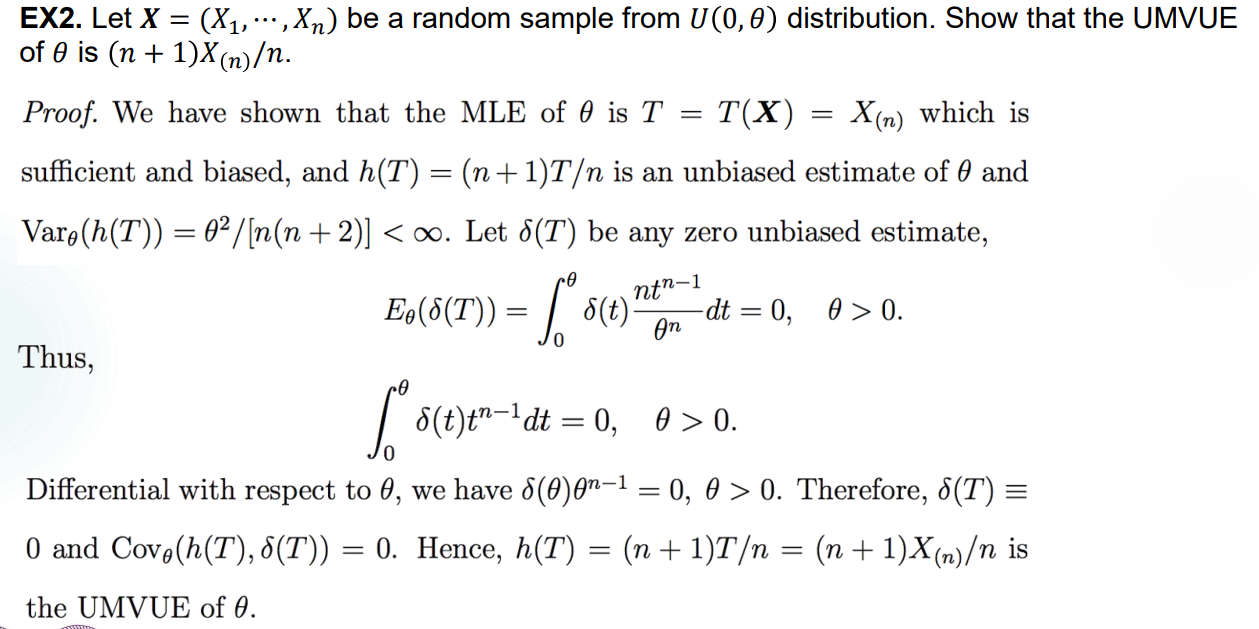
寻找 UMVUE
寻找总比验证更困难。
Cramer-Rao Inequality:\(X_1,X_2,...,X_n\) 是服从 PDF \(f(x | \theta)\) 的随机样本,\(W(X)=W(X_1,...,X_n)\) 是 \(X\) 的一个统计量,满足 \(\frac{d}{d\theta} E_\theta W(X) = \int \frac{\partial}{\partial \theta} [W(x)f(x|\theta)] dx\),且 \(Var_\theta W(X) < \infty\),于是 \(Var_\theta (W(X)) \geq \frac{(\frac{d}{d\theta} E_\theta W(X))^2}{nI(\theta)}\)。
如果一个 unbiased estimator 达到了 C-R lower bound,它就是 UMVUE。然而这不是充要条件,任意一个 UMVUE 未必满足取等条件。且需要注意只有在满足 Regularity Conditions 的时候才能保持 Cramer-Rao 成立。
多元形式的 Cramer-Rao Inequality:\(Cov_\theta(\hat{\theta}) \geq (nI(\theta))^{-1}\)。其中,\(A\geq B\) 表示 \(A-B\) 是一个非负定矩阵。
Example 1:
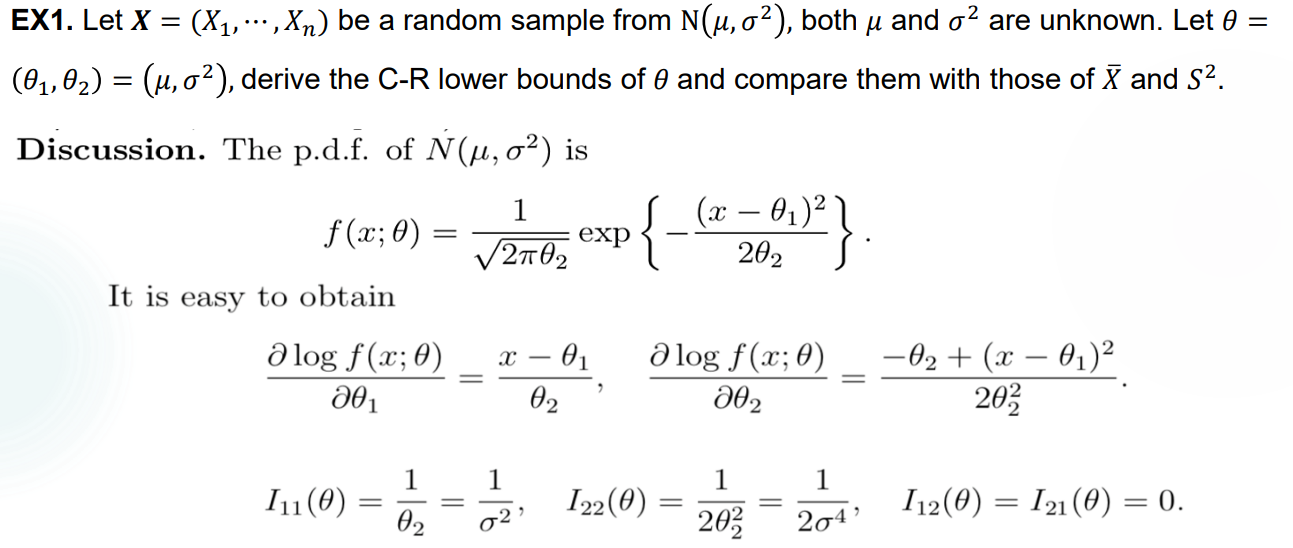
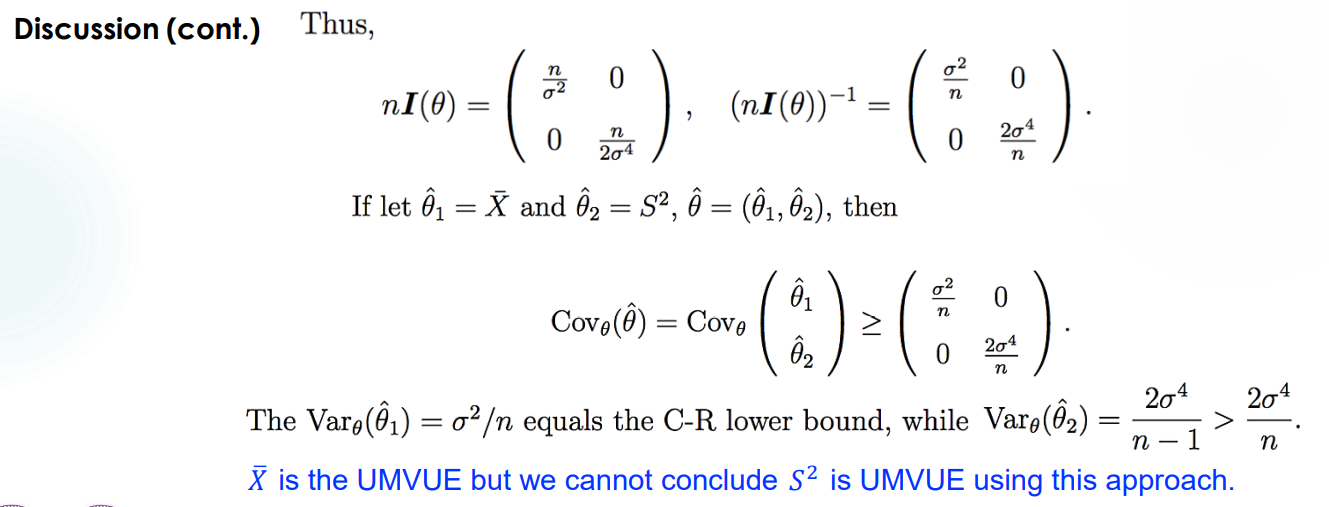
Rao-Blackwell:\(T(X)\) 是 \(g(\theta)\) 的 sufficient statistic,\(\hat{g}(X)\) 是 \(g(\theta)\) 的 unbiased estimator,于是记 \(h(T)=E(\hat{g}(X)|T)\) 也是一个 unbiased estimator,且 \(Var(h(T))\leq Var(\hat{g}(X))\)。
这是一个把 unbiased estimator 的方差降低的方法,启发出以下的 Lehmann-Scheffe Theorem。
\(T(X)\) 是 \(g(\theta)\) 的 complete and sufficient statistic,如果 \(\hat{g}(T(X))\) 是 unbiased estimator,那么它就是唯一的 UMVUE。
\(T(X)\) 是 \(g(\theta)\) 的 complete and sufficient statistic,\(U\) 是 \(g(\theta)\) 的 unbiased estimator,那么 \(\hat{g}(T)=E_\theta (U|T)\) 也是唯一的 UMVUE。
这给出了已知 complete and sufficient estimator 时的两种方法:要么直接寻找其函数使得它也是 unbiased estimator,要么得到一个 unbiased estimator 然后二者结合做出解。显然,对于 Exponential Family 中的分布来说,这个方法比较容易操作,因为我们可以轻松地找到 complete and sufficient estimator。
注意一个特例:Normal Distribution 的 UMVUE 就是对应的 \(\bar{X},S^2\) 在系数和常数上的修正,这是易于证明的。
Example 1:

Example 2:
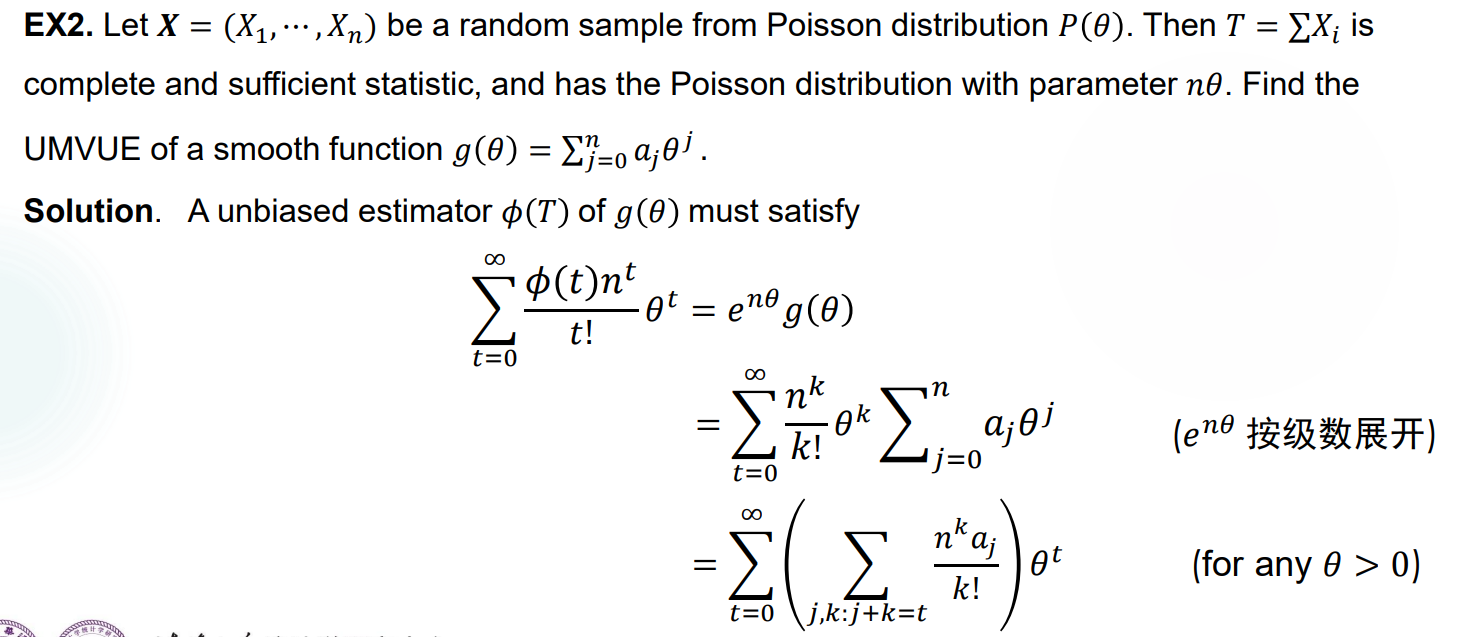
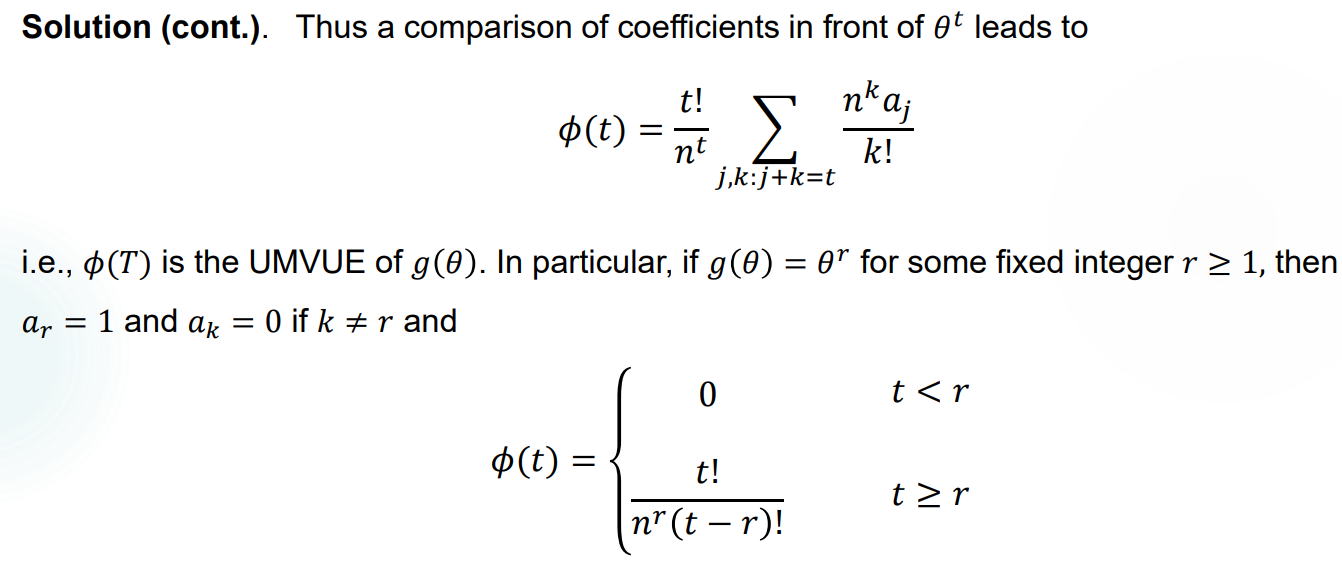
Example 3:

判别无偏统计量的有效性
Efficiency:

Homework 3

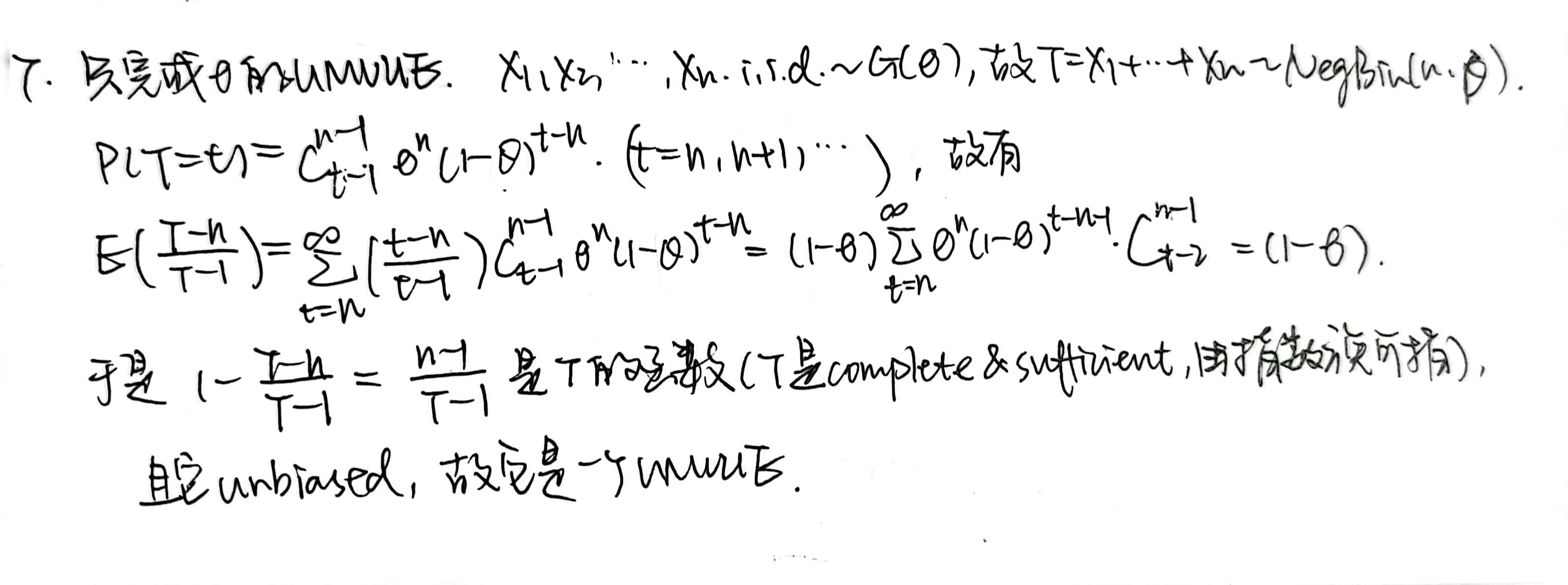
后记:期中考试又考了一遍这个题,不过问的是 \(\theta ^2\) 的 UMVUE。考场上自己写的时候才发现根本不用这么复杂,在第三行那一步的时候凑一个 \(\theta ^2\)(此处是 \(\theta\))出来就行,搞不懂助教为什么凑的是 \(1-\theta\)。结果是一样的,毕竟用 complete & sufficient statistic 得出的 UMVUE 是唯一的。
\(\theta ^2\) 的 UMVUE 是 \(\frac{(n-1)(n-2)}{(T-1)(T-2)}\),可见与 \(\theta\) 的 UMVUE 形式类似。
Mid-Term
问就是,不是我写的,跟我没关系,请不要开盒.jpg
Lecture 7
本节介绍区间估计,它对于参数的估计就更模糊一些,注重于根据一系列数据来提供若干个区间,使得参数的函数值落在其中。听起来没那么完美,但是现实就是这样的嘛。
Interval Estimation
定义
任意的 statistic \(\hat{g}_1(X),\hat{g}_2(X)\) 满足 \(\hat{g}_1(X) \leq \hat{g} _2 (X)\),则区间 \([\hat{g}_1(X),\hat{g}_2(X)]\) 是 \(g(\theta)\) 的一个 interval estimate(也可以叫做 confidence interval)。这个定义很宽泛,因为一个区间估计未必需要 \(g(\theta)\) 落在其中,它可以是无效的。需要注意的是,此处的用词是 estimate,意思是说,这里的 \(X\) 指的是一个确切的样本。
coverage probability:区间 \([\hat{g}_1(X),\hat{g}_2(X)]\) 的 coverage probability 是随机区间 \([\hat{g}_1(X),\hat{g}_2(X)]\) 包括真实值 \(g(X)\) 的概率,也就是 \(P\lbrace g(\theta) \in [\hat{g}_1(X),\hat{g}_2(X)] \rbrace >0\)。
Example 1:
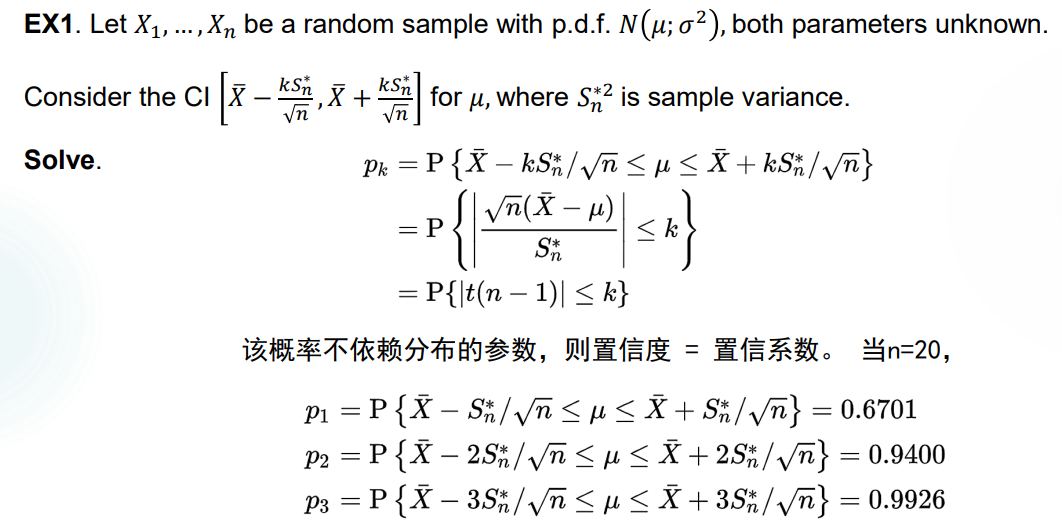

Measurement
然后就是要衡量一个 interval estimation 的有效度。
\(X_1,X_2,...,X_n\) 是一个服从 \(f(x;\theta)\) 的随机样本。Confidence Level(置信度,也写作 reliability)被定义为 \(P(\theta \in [\hat{\theta_1},\hat{\theta_2}])=P(\hat{\theta_1}\leq \theta \leq \hat{\theta_2})\)。
Confidence coefficient(置信系数):\(inf_{\theta \in \Theta} P_\theta (\hat{\theta _1} \leq \theta \leq \hat{\theta_2})\)
Precision(精确度):有很多种估计方法,此处取最常用的方法:mean interval length,即计算 \(E_{\theta}(\hat{\theta_2}-\hat{\theta _1})\),这个值越大说明区间越长,因此估计的精确度越差。
一般来说,置信度和精确度是一对相反的要求,需要进行 trade-off。
Example 1:
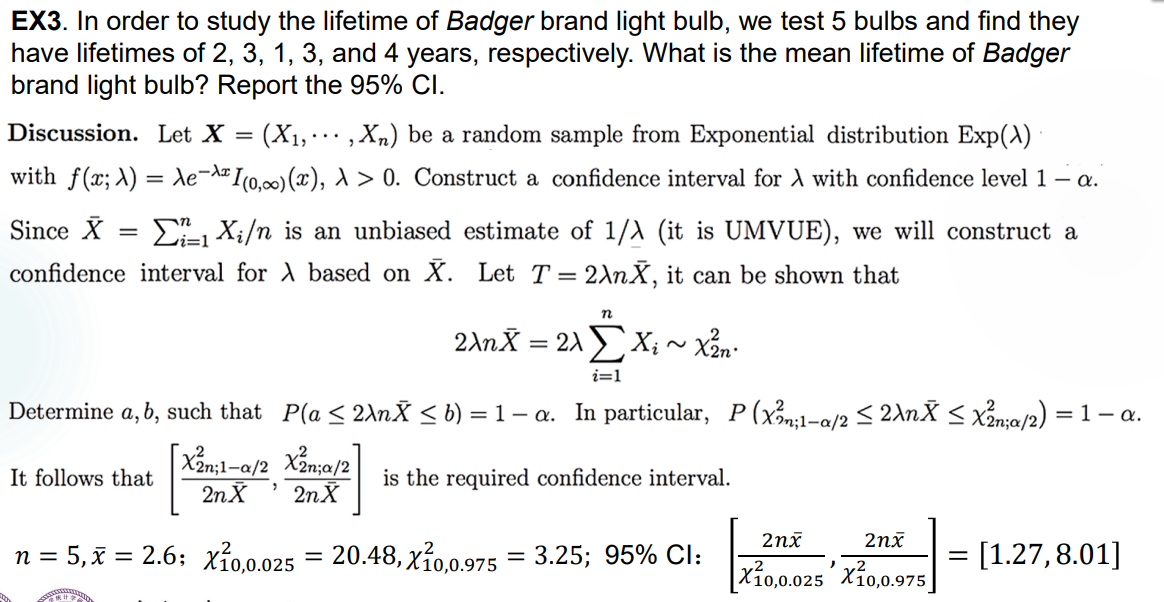
Revisit Confidence Interval:重新对于 confidence interval 进行定义,加上 confidence coefficient 的条件后如下:区间 \([\hat{\theta _1}(X),\hat{\theta _2}(X)]\) 是 \(\theta\) 的一个 interval estimate,且对于一个给定的 \(\alpha\) 有 \(0<\alpha <1\),如果 \(P(\hat{\theta_1}(X)\leq \theta \leq \hat{\theta_2}(X)) \geq 1-\alpha\),那么称区间 \([\hat{\theta _1}(X),\hat{\theta _2}(X)]\) 是一个有 confidence level 为 \(1-\alpha\) 的, \(\theta\) 的 confidence interval。
于是 confidence coefficient \(inf_{\theta \in \Theta} P_\theta (\hat{\theta _1} (X)\leq \theta \leq \hat{\theta_2}(X)) \leq \alpha\),是 confidence interval \([\hat{\theta _1}(X),\hat{\theta _2}(X)]\) 的 confidence coefficient。
Remark 1:此处如果有 \(\alpha=0.05\),不代表 \(\theta\) 有 \(0.95\) 的概率落在得到的区间里,而是指的是我们有 \(0.95\) 的信度能够确定 \(\theta\) 在此区间里。更形象地,我们取 \(1000\) 个样本,得到的 \(1000\) 个区间里大约会有 \(950\) 个覆盖住 \(\theta\)。
Remark 2:在取样本之前,所有的区间 \([\hat{\theta _1}(X),\hat{\theta _2}(X)]\) 都是 random interval,但取得样本之后区间的左右端都变为定值,称为 observed interval。
Confidence Limit:有的时候我们只关心参数的上界或下界,即只考虑单边。对于给定的 statistic \(\hat{\theta}_U (X),\hat{\theta}_L (X)\),对于给定的 \(0<\alpha <1\),如果 \(P_\theta(\theta \leq \hat{\theta}_U (X))\geq 1-\alpha,\theta \in \Theta\),或者 \(P_\theta(\theta \geq \hat{\theta}_L (X))\geq 1-\alpha,\theta \in \Theta\),则称 \(\hat{\theta}_U (X),\hat{\theta}_L (X)\) 分别是 \(\theta\) 的 upper confidence limit 和 lower confidence limit,且有置信度 \(1-\alpha\)。
针对 confidence limit 的 precision 估计:\(E(\hat{\theta}_U(X))\) 越小或者 \(E(\hat{\theta}_L(X))\) 越大,越精确。
此时,取 confidence interval 为 \([\hat{\theta _L}(X),\hat{\theta _U}(X)]\),它的 confidence level 为 \(1-\alpha_1-\alpha_2\)。
多维情形
略(
构造合适的 Interval Estimation
Pivot quantity method
如果要翻译的话,可以称为“枢轴量方法”。
寻找 Pivot Quantity 的方法:找到一个包含参数 \(\theta\) 的随机变量,它关于 \(X_1,X_2,...,X_n\) 的部分最好是一个充分统计量的形式,且这个随机变量的分布已知。
观察此 pivot quantity 落在区间 \([a,b]\) 上的概率,并适当选取让这个概率大于 \(1-\alpha\)。
再把这个式子改成关于 \(\theta\) 的 interval estimation 的形式。
总之,要找一个分布与 \(\theta\) 无关,且形式上与 \(\theta\) 有关的随机变量,它在形式上也不能和其他未知的参数有关。
位置-尺度族的常用 Pivot Quantity:
Form of PDF Type of PDF Pivotal Quantity \(f(x-\mu)\) Location \(\bar{X}-\mu\) \((1/\sigma)f(x/\sigma)\) Scale \(\bar{X}/\sigma\) \((1/\sigma)f((x-\mu)/\sigma)\) Location-Scale \((\bar{X}-\mu)/S\)
Approximate CI
顾名思义,在找不到合适的 pivot estimation 的时候,可以利用中心极限定理等方式取得一个依分布收敛的随机变量,把它作为 pivot estimation,然后进行考虑。
常用于不确定分布的 Population,或者无法求得合适的 pivot estimation 的 Population。如果有精确的 pivot estimation 但是转化为参数中心的不等式时计算太复杂,也可以将其中的项进行改动,比如把某个 \(\mu\) 改成 \(\bar{X}\),等等。
Example 1:
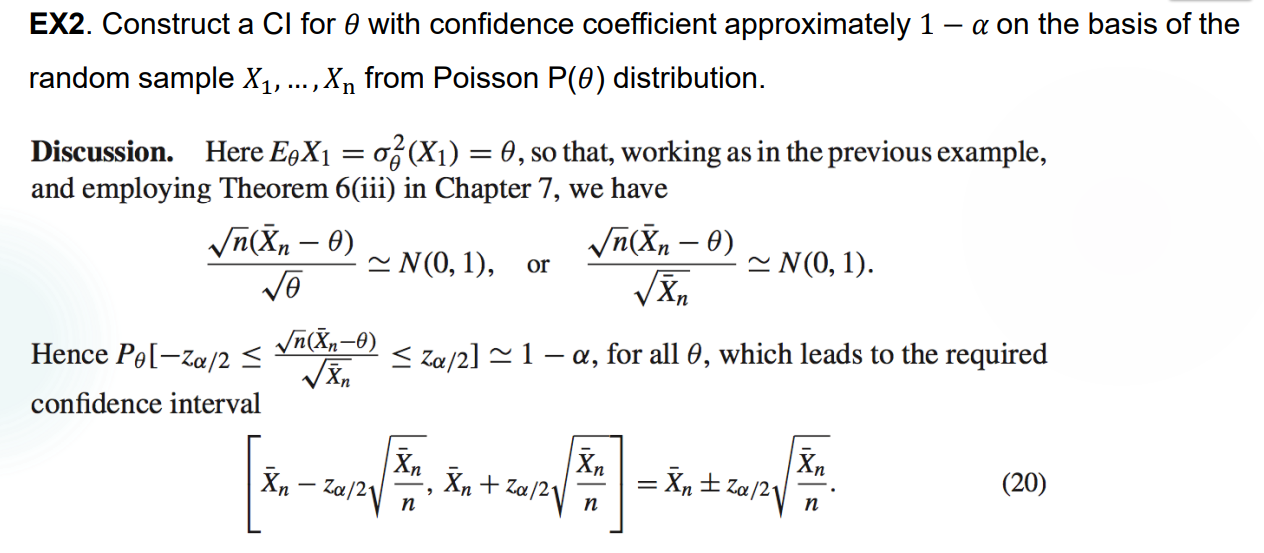
前提是样本量足够大。
关于正态分布的 CI
幸运的是,下面这张图上有你需要的一切:
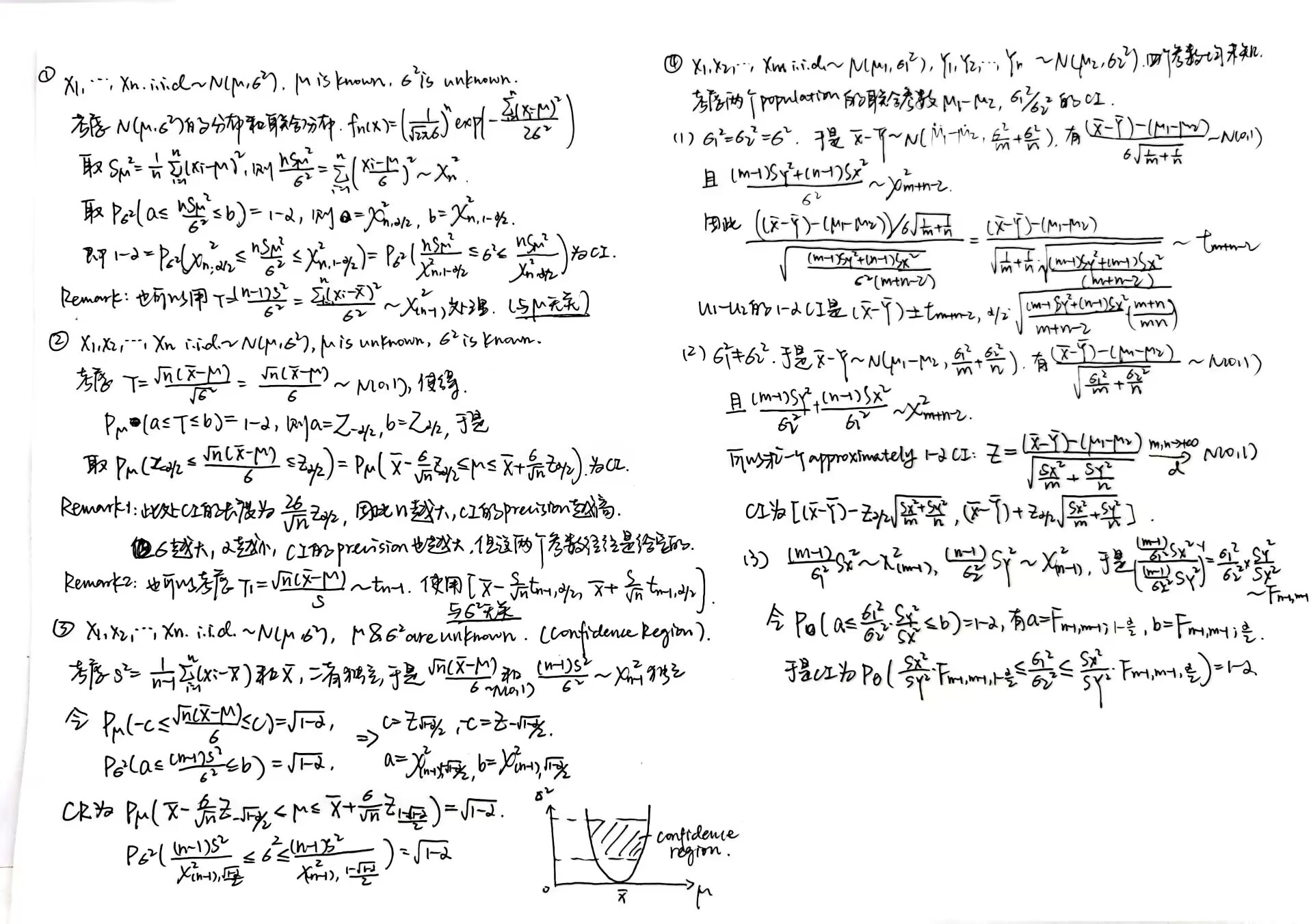
1 和 2 指出的是对于某个随机样本 \(X_1,...,X_n i.i.d \sim N(\mu, \sigma^2)\),在参数之一已知的时候,求出另一参数的 CI 的方法。在 Remark 里提出了不需要已知参数时的方法。
3 指出的是两个参数都不可知时,利用独立性得出 \(\mu,\sigma^2\) 的 Confidence Region 的方式,虽然考试中并不会涉及,但是我觉得思路相当好。
4 指出的是两个不同的正态 Population 中分别取样,得出 \(\mu_1-\mu_2\),\(\frac{\sigma_1 ^2}{\sigma_2 ^2}\) 的 CI 的方法。
分类讨论了几种:在方差相等时 \(\mu_1-\mu_2\) 的 CI 可以准确求出(如果已知了 \(\sigma\) 甚至更方便,用标准化到正态分布的 \(T\) 就可以做了),方差不等时 \(\mu_1-\mu_2\) 的 CI 是 approximate 的;此外,\(\frac{\sigma_1 ^2}{\sigma_2 ^2}\) 的 CI 求法在最后一种情况里给出。
Homework 4
略,基本就是以上内容的简单应用,不过计算量有点大(
Lecture 8
心情如图所示:orz orz orz orz orz orz

本节介绍假设检验的一些基本信息,这也是直到学期末为止的后半部分课程的主要内容。
突然想起 V1ncent19 学长说过的一段话:
如果对生存分析不太熟悉的同学可以先笼统地理解为研究“某件事情什么时候发生”,这个时候就不得不提起某蒙古上单的评论“* * 什么时候 * 啊”,大概就是研究这种事情。
所以假设检验的通俗解释大概就是,对于某个样本,我们先验证它是否满足 A 条件,如果满足,我们就认为某个与参数相关的结论 B 是对的。否则,有一个和结论 B 矛盾的结论 C 成立。生活中其实处处都是假设检验,类似于通过“今天 ta 和我说话了”来判断出“ta 一定喜欢我吧!”这一假设成立,显然信度不是很高。
基本定义
检验的定义
Hypothesis Testing:我们有一个 distribution family 为 \(F=\lbrace f(x;\theta),\theta \in \Theta \rbrace\),记 \(X=(X_1,X_2,...,X_n)\) 是上述分布族中的一个随机样本。记 \(\Theta_0\) 是 \(\Theta\) 中不为空的一个子集,我们想检验是否有 \(\theta \in \Theta_0\)。记 \(\Theta_1=\Theta - \Theta_0\) 是 \(\Theta_0\) 的补集。
- Null Hypothesis(原假设):记为 \(H_0\):\(\theta \in \Theta_0\),说明存在某个 \(\theta_0 \in \Theta_0\),使得 \(X_i \sim f(x;\theta_0)\)。
- Alternative Hypothesis(备择假设):\(H_0\) 的 Alternative Hypothesis 记为 \(H_1\):\(\theta \in \Theta_1\)。
- 于是假设检验过程可以写为:\(H_o:\theta \in \Theta_0 \leftrightarrow H_1 : \theta \in \Theta_1\)。
- Simple and composite hypothesis :\(H_0 (/ H_1)\) 是一个 simple hypothesis 等价于 \(\Theta_0(/ \Theta_1)\) 是一个单点集,否则是 composite hypothesis。
根据样本检验 \(H_0\) 是否正确的过程,称作对于 \(H_1\) 检验假设 \(H_0\)。(我瞎翻译的,原文是 testing the hypothesis \(H_0\) against the alternative \(H_1\))
在 Hypothesis Testing 中,null hypothesis \(H_0\) 称为 original belief,是一个我们希望通过样本验证它是错的的精确条件。我们一般预设它是错的,预设 alternative hypothesis 是对的。
Rejection Region:在一个随机样本 \(X=(X_1,X_2,...,X_n)\) 上我们要做出一个决定,即接受还是拒绝 null hypothesis \(H_0\)。也就是说我们要定义出一个条件 \(A\),满足此条件则 accept null hypothesis,否则 reject null hypothesis。
不满足条件 \(A\) 的样本 \(X\) 会使得 null hypothesis 被拒绝,符合我们的预设,这样的 \(X\) 的集合称为 Rejection Region(或称 critical region),记为 \(D\),是一个样本子空间。于是 \(D^c\) 就是 Acceptance Region,满足 \(\chi=D+D^c\),\(\chi\) 是样本空间。
Two-side 和 One-side test:
双边检验:\(H_0:\theta=\theta_0 \leftrightarrow H_1:\theta \neq \theta_0\),它的检验条件 \(A\) 是 \(A: -c \leq T(X)\leq c\),其中 \(T(X)\) 是 \(\theta\) 的一个估计量。于是 rejection region 就是 \(D=\lbrace |T(X)| >c \rbrace\)。
单边检验:\(H_0:\theta \leq \theta_0 \leftrightarrow H_1 : \theta > \theta_0\),它的检验条件 \(A\) 是 \(A: T(X)\leq c\),其中 \(T(X)\) 是 \(\theta\) 的一个估计量。于是 rejection region 就是 \(D=\lbrace T(X) >c \rbrace\)。
对称地,如果 \(H_0:\theta \geq \theta_0 \leftrightarrow H_1 : \theta < \theta_0\),它的检验条件 \(A\) 是 \(A: T(X)\geq c\),其中 \(T(X)\) 是 \(\theta\) 的一个估计量。于是 rejection region 就是 \(D=\lbrace T(X) <c \rbrace\)。
检验函数
Test Function:在某些非黑即白的检验条件下,\(\psi(X)=I_{\lbrace reject H_0 \rbrace}\)。也就是说 \(H_0\) 被 reject、符合预设的时候 test function 取为 \(1\),否则取为 \(0\)。
实际上,更标准的 test function 定义为 reject \(H_0\) 的概率,如果是 non-randomized test 则 \(\psi(X)=0,1\),如果是 randomized test 则 \(\psi(X)\) 可取 \([0,1]\) 之间的值。
以下考虑一些 randomized test。
Example 1:
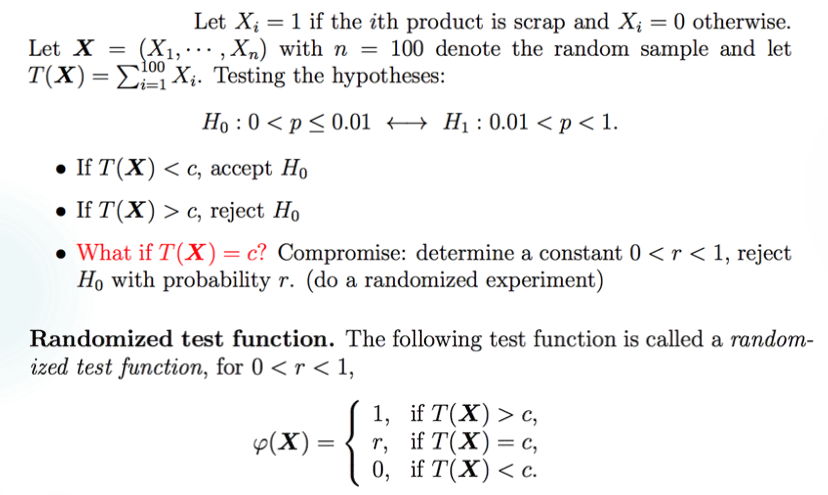
由此定义 randomized test function:临界条件下定义 \(\psi (X)=r\),\(X\in D\) 时 \(\psi(X)=1\),否则 \(X\in D^c\) 时 \(\psi (X)=0\)。
Type I & II Errors
实际上,我们在假设检验中进行随机抽样,总有可能取到偏误的样本,导致错误地 reject 或者 accept 了 \(H_0\)。有两种错误,分别称为 Type I & II Error。
通俗来说,Type I Error 是假阳性,也就是把实际正确的 \(H_0\) 给 reject 了,就像给健康人判了感染一样。发生 Type I Error 是因为取到的样本恰好落在了 \(D\) 里,这个概率是:
\(\alpha(\theta)=P(I)=P[(X_1,X_2,...,X_n) \in D | H_0]=P[(X_1,X_2,...,X_n) \in D | \theta \in \Theta_0]\)
发生 Type I Error 的最大概率,也就是 \(\alpha=max_{\theta \in \Theta_0} P(I)\),称为 the level of significance(显著性水平)。当 \(\alpha=0\) 时说明 \(D=\emptyset\),也就是说 \(H_0\) 永远被接受。
相对地,Type II Error 就是假阴性,\(P(II)=P[(X_1,X_2,...,X_n) \in D^c | \theta \notin \Theta_0]\)。
定义发生 Type II Error 的概率为 \(\beta(\theta)\),于是 \(\beta(\theta)=1\) 时也有 \(D=\emptyset\),这是和预设不符的。
同时降低两种 Error 是不太可能的,以一个正态的估计量 \(T(X)\) 为例,可以看到呈一个此消彼长的趋势。(课上这个图画了好久,不是很懂,摸鱼去了)
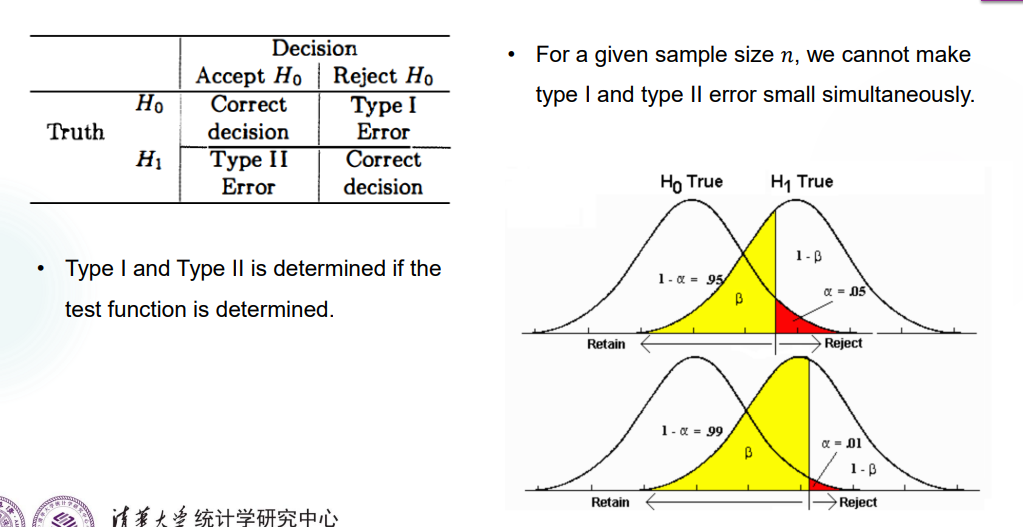
但是在实际操作中我们会遵循 Neyman-Pearson Principle,去尽量降低发生 Type I Error 的概率,让 the level of significance 降低到一个预设的级别 \(\alpha\),再去考虑降低 Type II Error 的概率。
于是如果样本落进了 \(H_0\) 的 acceptance region,我们会保持自己的预设,优先考虑这个样本没有提供足够的证据来 reject \(H_0\),而不是我们应该 accept \(H_0\)。
Power Function
Power Function(功效函数,势函数)定义为一个假设检验中,样本落在 \(H_0\) 的 rejection region \(D\) 上的概率,即 \(\pi(\theta)=P_\theta (X \in D)\)。当 accept \(H_0\) 时,\(\pi(\theta)=\alpha(\theta)\),否则 \(\pi(\theta)=1-\beta(\theta)\)。
单次检验 \(\psi\) 的 power function 定义为 \(\pi_\psi(\theta)=E_\theta [\psi(X)]\),其中 \(\psi(X)\) 是 reject \(H_0\) 的概率,也就是说 power function 是整个检验中 reject \(H_0\) 的概率总和。
对于一个 non-randomized test,\(\pi_\psi(\theta)=P_\theta (X=(X_1,...,X_n) \in D)\),因为 \(\psi\) 取值为 \(0,1\)。
对于一个 randomized test,\(\pi_\psi(\theta)=P(T(X)>c)+rP(T(X)=c)\),因为 \(\psi\) 取值 \(0,1,r\)。
Example 1:
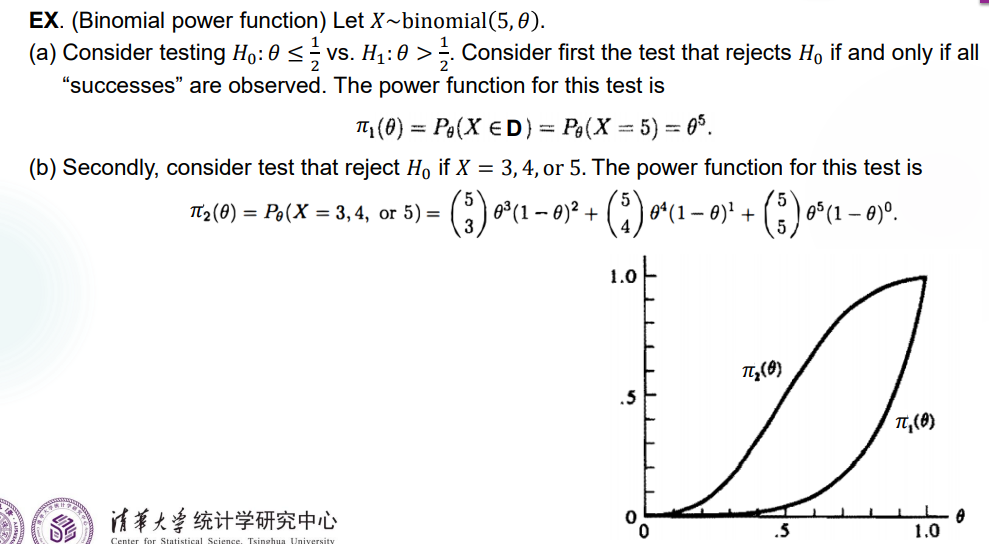
Remark:这个题给出了两个 power function 的曲线,可以看到 \(\pi_1(\theta)\) 底部和 \(\theta\) 轴贴得比较近,对于 Type I Error 的预防较好;在 \(\theta\) 落在 \(\Theta_1\) 中时 \(\pi(\theta)=1-\beta(\theta)\),因此 \(\pi_2(\theta)\) 对 Type II Error 的预防较好。
实际上,这两个检验方式都不够好,没有同时预防两种 Error。最理想的 power function 应该在 \(\theta=0.5\) 处陡然上升,这样 \(\alpha(\theta)\) 和 \(\beta (\theta)\),也即发生 Type I & II Error 的概率都能得到控制。
P-value
感觉不是很好理解,先举个例子。我们已经知道在假设检验的时候一般都有一个范围,例如在 \(T(X)>a\) 时 reject \(H_0\),等等。当拿到一个样本计算出 \(T(X)\) 后,它在大于 \(a\) 时可能离 \(a\) 很远,也可能离 \(a\) 很近。离 \(a\) 越远,我们越确信这个样本更好地反映了应该 reject \(H_0\)。因此,我们希望找一个标准来衡量这种“确信”的程度,因此引入 P-value。
某一个样本 \(X\) 的 P-value 反映出了在 reject or accept \(H_0\) 这件事上有相同结果的时候,所能得到的其他样本比 \(X\) 更加极端的概率。虽然听起来很奇怪,但就是这样的。反映到具体例子里,大概就是:
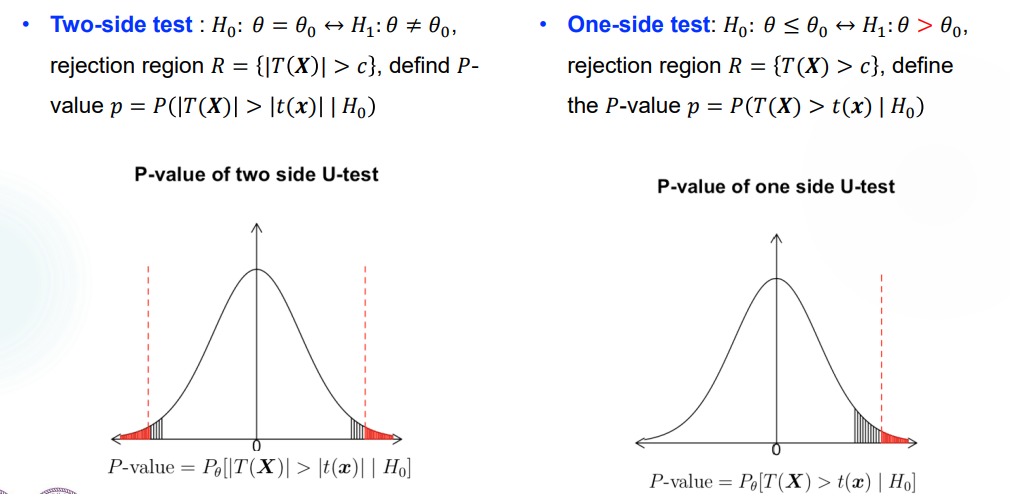
P-value 是一个基于所得样本的条件概率,前提是 \(H_0\) 成立。
Decision Rule:给出一个衡量标准 \(\alpha\),我们在 \(T(X)\) 符合判断要求,且 \(P-value \leq \alpha\) 时 reject \(H_0\)。因此,P-value 能够衡量做出 rejection of a hypothesis 这一决定的证据充分程度,P-value 越小,拒绝的理由越充分,这样的操作就可以称为一个 strong rejection,称结果 highly statistically significant(统计学上有高度的显著意义(我瞎翻译的
Example 1(HW):
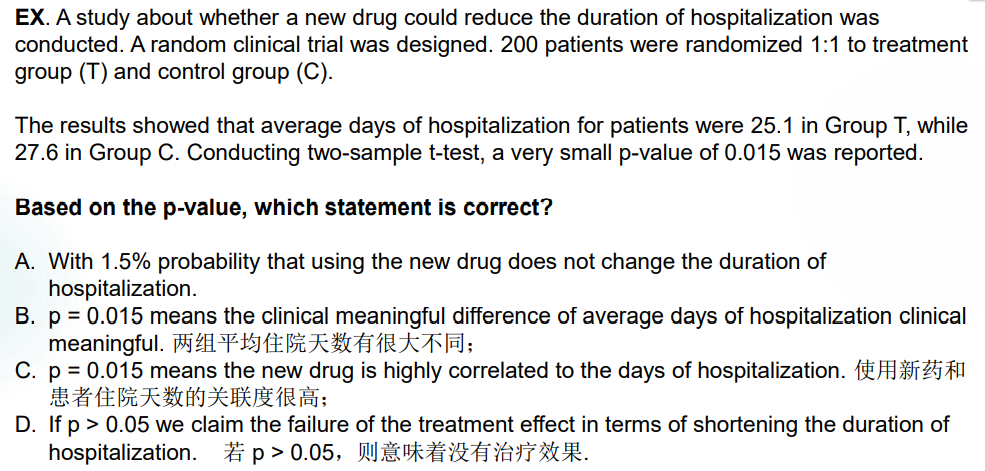
先建个模:试验得到的样本是 \((x_1,x_2)=(25.1,27.6)\),null hypothesis 指的是“药是无效的”,alternative hypothesis 指的是“药是有效的”(对此区分是因为我们预设 reject null hypothesis)。如今得到了一个比较小的 P-value 是 \(0.015\),这说明了我们有比较大的把握通过这一个样本来确定药是有效的。
四个选项都不对。\(A\) 选项计算的是 \(P(H_0)\),\(B\) 选项计算的或许是 \(E(X_1-X_2)\),\(C\) 选项计算的是 \(P(T(X_1)<a | H_0)\),虽然在形式上比较接近 P-value 的定义了但还是不对,\(D\) 选项问题在于 \(p>0.05\) 时说明这一组样本对于 reject \(H_0\) 的可信度不够高,并不完全证明没有治疗效果。
The American Statistical Association's statement on p-values: context, process, and purpose
因为 P-value 真的很容易被误用,所以 ASA 在 2016 年提出了使用和解释 P-value 的原则。摘录如下:
P-values can indicate how incompatible the data are with a specified statistical model.
A p-value provides one approach to summarizing the incompatibility between a particular set of data and a proposed model for the data.
The smaller the p-value, the greater the statistical incompatibility of the data with the null hypothesis, if the underlying assumptions used to calculate the p-value hold.
P-values do not measure the probability that the studied hypothesis is true, or the probability that the data were produced by random chance alone.
Researchers often wish to turn a p-value into a statement about the truth of a null hypothesis, or about the probability that random chance produced the observed data. The p-value is neither.
Scientific conclusions and business or policy decisions should not be based only on whether a p-value passes a specific threshold.
Proper inference requires full reporting and transparency.
A p-value, or statistical significance, does not measure the size of an effect or the importance of a result.
Smaller p-values do not necessarily imply the presence of larger or more important effects, and larger p-values do not imply a lack of importance or even lack of effect.
Any effect, no matter how tiny, can produce a small p-value if the sample size or measurement precision is high enough, and large effects may produce unimpressive p-values if the sample size is small or measurements are imprecise.
Similarly, identical estimated effects will have different p-values if the precision of the estimates differs.
(讲了一些选取 estimator 会带来的区别,课程还没涉及到)
By itself, a p-value does not provide a good measure of evidence regarding a model or hypothesis.
Researchers should recognize that a p-value without context or other evidence provides limited information.
For example, a p-value near 0.05 taken by itself offers only weak evidence against the null hypothesis.
总的来说,P-value 能够提供的信息是有限的。
Lecture 9
本节继续介绍了以正态分布样本为主的假设检验。变得越来越像 Interval Estimation 了。
首先回顾一下假设检验的过程:
- 先设出一个 null hypothesis \(H_0\) 和对应的 alternative hypothesis \(H_1\),二者不一定构成全集。
- 找到用于假设检验的 test statistic \(T(X)\),以及对应的 rejection region \(D\),例如 \(D=\lbrace X | T(X)>a \rbrace\),\(a\) 是待定的。
- 找到一个合适的 level of significance \(\alpha\),一般是 \(0.01,0.05\),通过控制 critical value,也就是控制发生 Type I Error 的概率小于 \(\alpha\),来决定 \(D\) 的具体形式。
- 取样本,计算 \(T(X)\),看它是否在 rejection region 里,判断是否要 reject null hypothesis。
- 计算 P-value 的大小,来判断通过这组样本作出决定的这一做法有多大的可信度。
每一步都比较清楚了,目前落实到具体问题里需要处理的是找 test statistic,以及控制 critical value 来得到 rejection region 两步。
Testing in various populations
懒得翻译了,总之在正态分布的一些情况里、以及一些简单分布中进行分析。
A single normal population
检验 \(\mu\) 的过程分为是否知道 \(\sigma\) 具体值的两种情况,又分为三种典型的 Hypothesis 进行处理,一切都在图中:
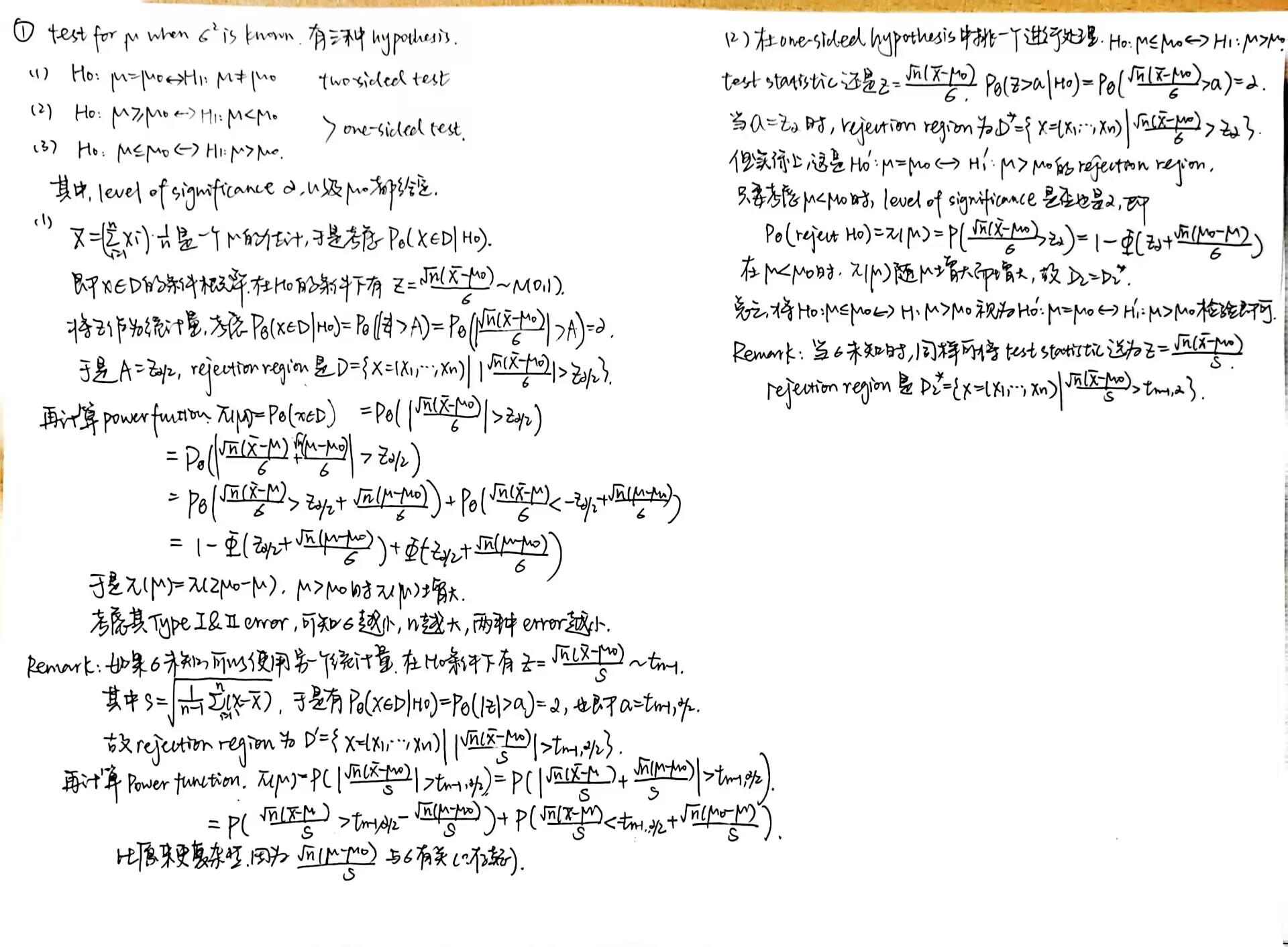
注意我们在进行检验的时候,往往把等于号的情况归到 null hypothesis 中去。
以上前半部分对 two-sided 进行了检验,remark 里指出了 \(\sigma\) 未知的检验方法,这称为 \(U\) 检验;后半部分对 one-sided 的一种情况进行了检验,同样在 remark 里指出了 \(\sigma\) 未知的检验方法,这称为 \(t\) 检验。
检验 \(\sigma\) 的过程分为是否知道 \(\mu\) 具体值的两种情况,又分为三种典型的 Hypothesis 进行处理,一切都在图中:
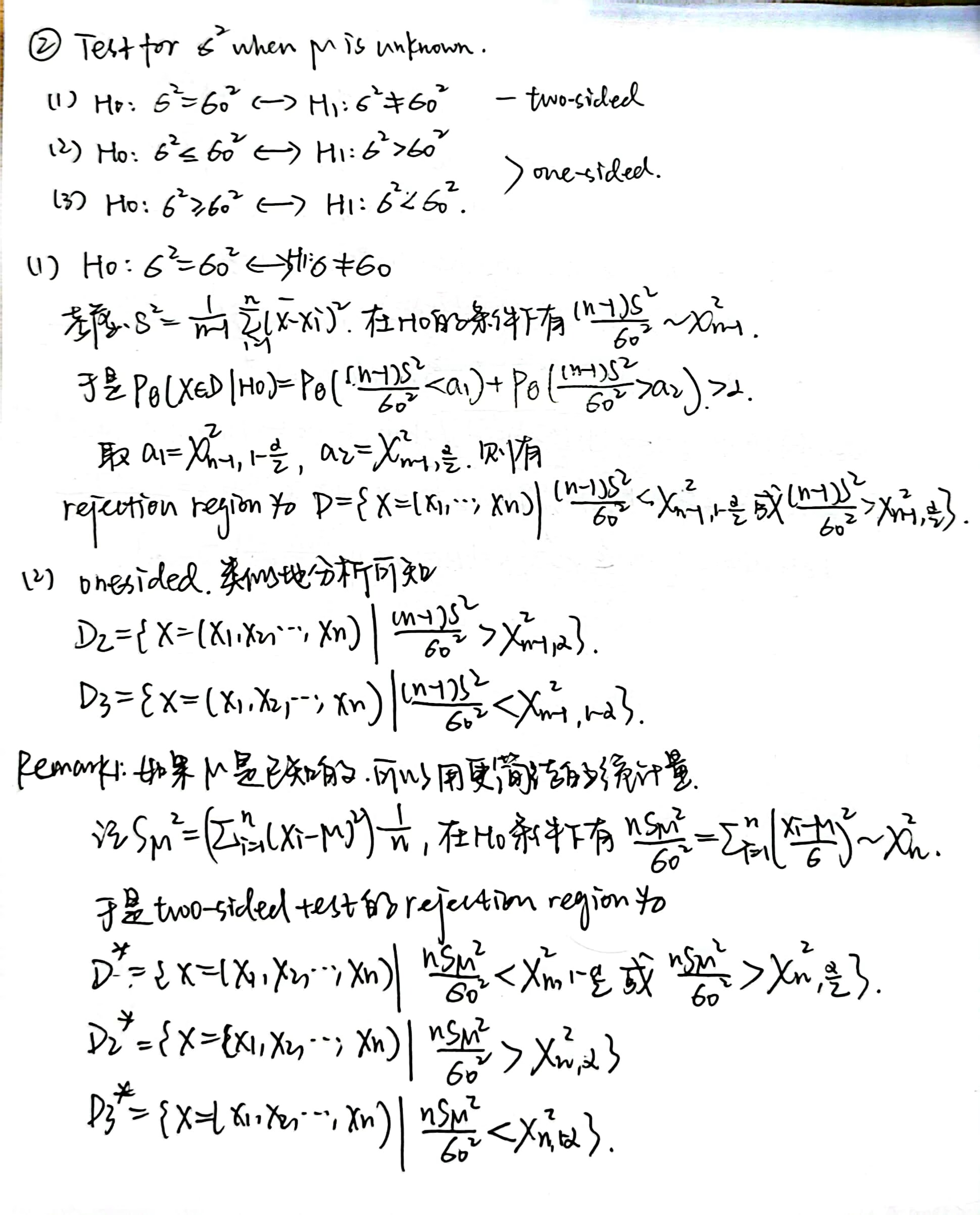
此处都是利用 \(\chi^2\) 分布进行检验,称为 \(\chi^2\) 检验。
Non-normal population
检验 \(B(1,\theta)\) 分布的 population 的参数
以一个例子来说明:

这带我们回顾了 test function \(\varphi(X)\) 的定义,它代表了 \(T(X)\) 取某个值的时候 reject \(H_0\) 的信度。
Two normal distributions
在 two normal distribution 的情况下,检验 \(\mu_1-\mu_2\),\(\sigma_1^2 / \sigma_2 ^2\),以及进行 paired comparison。
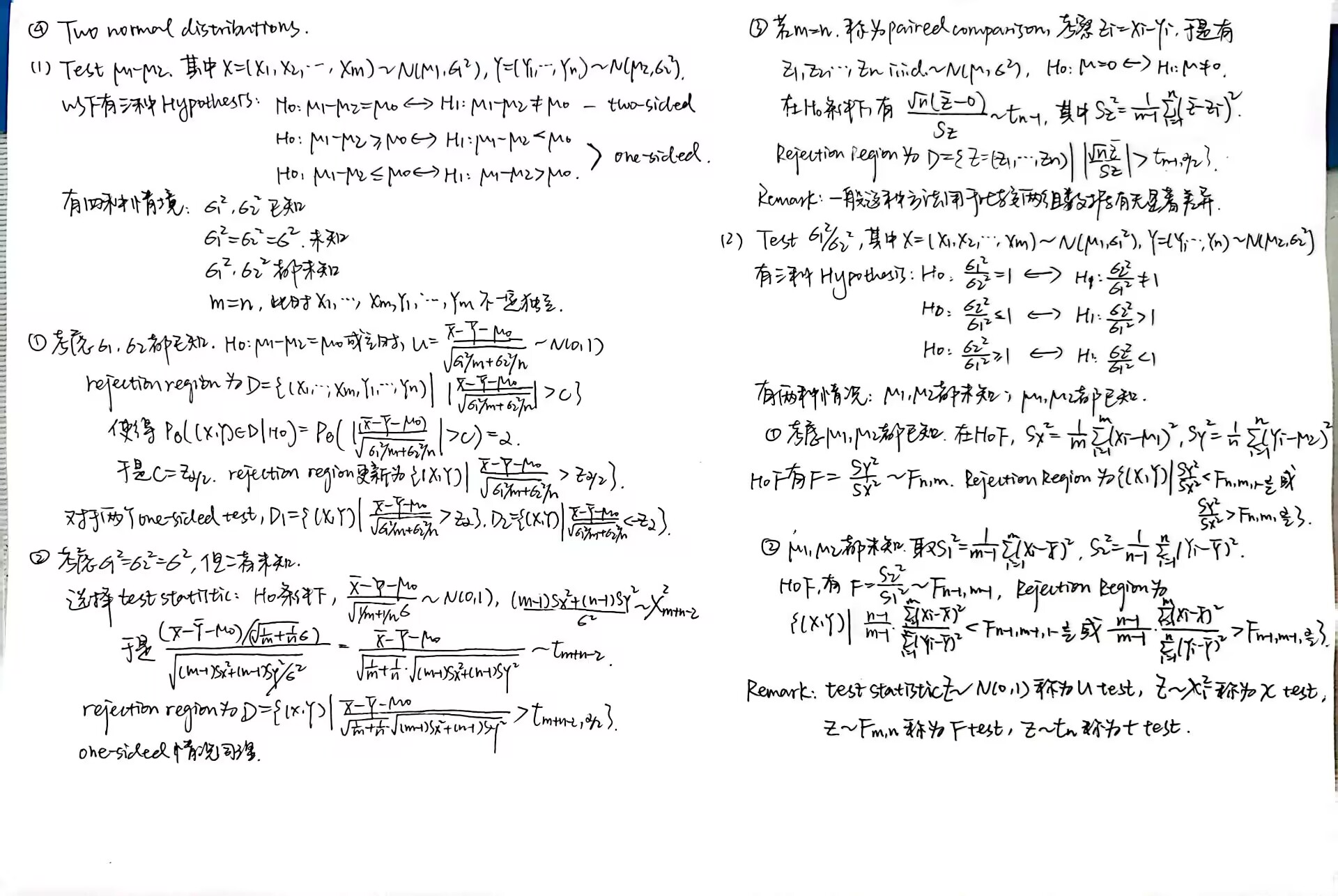
Summary
本来想自己画个表格,结果摆了。
- One normal population


- Two normal populations(不包括 paired comparison,paired comparison 的目标是考察一个正态分布的期望是否为 0)


Non-normal population
\(B(1,\theta)\) 见前。
Bootstrapping Method
本来觉得看起来很好玩,没想到居然直接不讲了,sigh。我自己补一个。
实际情况下样本不一定来自一个 Normal Distribution,数据集也可能不够大。我们可以用 Bootstrap 的方法嗯造一个 Normal Distribution 的数据集,然后进行假设检验。方法是每次有放回地从数据集里抽取一组数据,注意不仅是样本之间可以有重叠,样本内部抽每个数据的时候也是有放回抽取的。
比如对于一个较小的、不确定是否为 Normal Distribution 的数据集做假设检验:\(H_0:\mu = 33.02\),\(H_1:\mu \neq 33.02\)。
| No. | 1 | 2 | 3 | 4 | 5 | 6 | 7 | 8 | 9 | 10 |
|---|---|---|---|---|---|---|---|---|---|---|
| Data | 28 | -44 | 29 | 30 | 26 | 27 | 22 | 23 | 33 | 16 |
| No. | 11 | 12 | 13 | 14 | 15 | 16 | 17 | 18 | 19 | 20 |
| Data | 29 | 24 | 24 | 40 | 21 | 31 | 34 | -2 | 25 | 19 |
Bootstrap Method 代码实现如下:
1 | # To see whether datas are from a normal population |
综上,这一组数据不足以支持 \(H_0\),我们选择 Reject \(H_0\)。
Test based on CLT
实际情况里不一定发生既不是 Normal Distribution,数据集又很小这么背的事情。如果数据量很大的话,完全可以使用 CLT 方法,进行一个 asymptotic sampling distribution 的规约,然后对近似正态分布进行 Hypothesis Testing。
对于一组 \(X_1,X_2,...,X_n i.i.d. \sim F\),有 mean \(\mu\) 和 variance \(\sigma^2\),取 \(\bar{X_n}=\Sigma_{i=1} ^n X_i/n\) 为 sample mean,\(S^2 = \Sigma _{i=1} ^n (X_i-\bar{X})^2 /(n-1)\) 为 sample variance。利用 CLT 可知:
\(F=N(\mu,\sigma^2)\) 时,一定有 \(\sqrt{n}(\bar{X_n}-\mu)/\sigma \sim N(0,1)\)。否则 \(n\) 足够大时,由 CLT 也有 \(\sqrt{n}(\bar{X_n}-\mu)/\sigma \to N(0,1)\)。
\(F=N(\mu,\sigma^2)\) 时,有 \(\sqrt{n}(\bar{X_n}-\mu)/S \sim t_{n-1}\)。否则 \(n\) 足够大时,由 CLT 和 Slutsky Theorem,有 \(\sqrt{n}(\bar{X_n}-\mu)/S \to N(0,1)\)。这个形式是用在 \(\sigma\) 未知的场合下进行假设检验的。
以上二者均依分布收敛。
Test \(\mu_1 -\mu_2\) when \(\sigma_1 ^2,\sigma_2 ^2\) unknown, and m, n are both large enough
由 CLT 和 Slutsky Theorem,可知在 \(H_0:\mu_1 -\mu_2 =\mu_0\) 条件下,\(U=\frac{\bar{Y}-\bar{X}-\mu_0}{\sqrt{S_X ^2 /m+ S_Y ^2 /n}} \to N(0,1)\)。对其假设检验,得到双尾检验的 Rejection Region 是 \(D=\lbrace (X_1,...,X_m,Y_1,...,Y_n) | |U|>z_{\alpha /2} \rbrace\)。
Test the mean \(\theta\) of \(B(1,\theta)\) when n is large enough
由 CLT 可知在 \(H_0:\theta = \theta_0\) 条件下,\(U=\frac{\sqrt{n}(\bar{X}-\theta_0)}{\sqrt{\theta_0(1-\theta_0)}} \to N(0,1)\),双尾检验的 Rejection Region 为 \(D=\lbrace (X_1,...,X_n) | |U| > z_{\alpha /2} \rbrace\)。
Test the mean \(\theta\) of \(P(\theta)\) when n is large enough
由 CLT 可知在 \(H_0:\theta = \theta_0\) 条件下,\(U =\frac{\sqrt{n}(\bar{X}-\theta_0)}{\sqrt{\theta_0}} \to N(0,1)\),双尾检验的 Rejection Region 为 \(D=\lbrace (X_1,...,X_n) | |U| > z_{\alpha /2} \rbrace\)。
Homework 5
略麻烦,我不是很懂那个 \(B(1,\theta)\) 的自主检验方法,蹲一个标答。
Lecture 10
老师发着烧还坚持上课,辛苦了 qwq
本节继续介绍 Hypothesis Testing,但是使用 Likelihood Ratio 方法。
Likelihood Ratio Test (LRT)
我们之前知道,解 MLE 方法的原理是 Likelihood Function 的值越大,说明 \(\theta\) 作为参数的可能性越大。在 Hypothesis Test 中也可以通过 \(H_0,H_1\) 的 maximum likelihood 得到最佳的 \(\theta\),从而对 \(H_0,H_1\) 做判断。
为了方便后续的计算,我们先给出:对于一个 random sample \(X_1,...,X_n i.i.d. \sim N(\mu,\sigma ^2)\),在 MLE 那一讲已经求得,其 \(\hat{\mu}_{MLE} = \bar{X}\) 是 sample mean,但 \(\hat { \sigma } _{MLE} ^2\) 不是 sample variance,而是 \(\frac {1} {n} \Sigma _{ i=1 } ^n (x _i - \mu) ^2\)。
Likelihood Ratio Method
\(H_0:\theta =\theta_0 \leftrightarrow H_1:\theta =\theta_1\),一个不是非常寻常的 hypothesis test。
考虑 \(\frac{L(\theta_0; x)}{L(\theta_1; x)} <c\) 时 reject \(H_0\)。显然,如果 accept \(H_1\),则说明全域 \(\Theta\) 上的最佳参数是 \(\theta_1\),也即它是 MLE,使得 \(L(\theta_1;x)>L(\theta_0;x)\) 成立。于是在 hypothesis test 中放松些要求,考虑 \(\frac{L(\theta_0; x)}{L(\theta_1; x)} <c\) 时 Reject \(H_0\)。
推广到 \(H_0:\theta \in \Theta_0 \leftrightarrow H_1:\theta \in \Theta_1\)
考虑 \(\frac{sup_{\theta \in \Theta_0} L(\theta;x)}{sup_{\theta \in \Theta_1} L(\theta;x)} <c\) 时 reject \(H_0\)。这个想法也很自然,\(sup_{\theta \in \Theta} L(\theta;x)\) 对应的 \(\theta\) 就是 \(\Theta\) 域中最佳的参数取值。
实际上,我们可以把 \(sup _{\theta \in \Theta _0 } L(\theta ; x )\) 记作 \(L( \hat { \theta } _{MLE ; 0} )\)。
同样地,把 \(sup _{\theta \in \Theta } L(\theta;x)\) 记作 $ L( _{MLE} )$。
于是当 \(L(\hat{\theta} _{MLE; 0} )\) / $ L( _{MLE} )$ 接近于 \(1\) 时,\(H_0\) 更有可能是对的;如果 \(L(\hat{\theta} _{MLE; 0} )\) / \(L(\hat{\theta} _{MLE} )\) 距离 \(1\) 比较远,就更有可能是错的。
记 likelihood ratio 为 \(\lambda (x) = L(\hat{\theta} _{MLE; 0} )\) / \(L(\hat{\theta} _{MLE} )\) ,于是当 \(\lambda(x)<\lambda_0\) 时 reject \(H_0\),其中 \(\lambda_0\) 是一个等待被决定的常数。
决定这个常数的过程和上一讲的操作基本上是一样的。一般来说,我们会把 reject \(H_0\) 的条件等价地写成:\(-2 log \lambda > C(=-2log \lambda_0)\),然后对于 continuous / discrete distribution 进行讨论。
对于 non-randomized test,\(\varphi (x) = I_{\lbrace \lambda < \lambda_0 \rbrace}\),考虑 \(\pi(x) = E_\theta \varphi(X) \leq \alpha\)。
对于 randomized test,在 \(\lambda=\lambda_0\) 处插入 \(\varphi(x)=r\),\(r\) 是一个 \((0,1)\) 上的值即可。
单 Population 上样本的 LRT
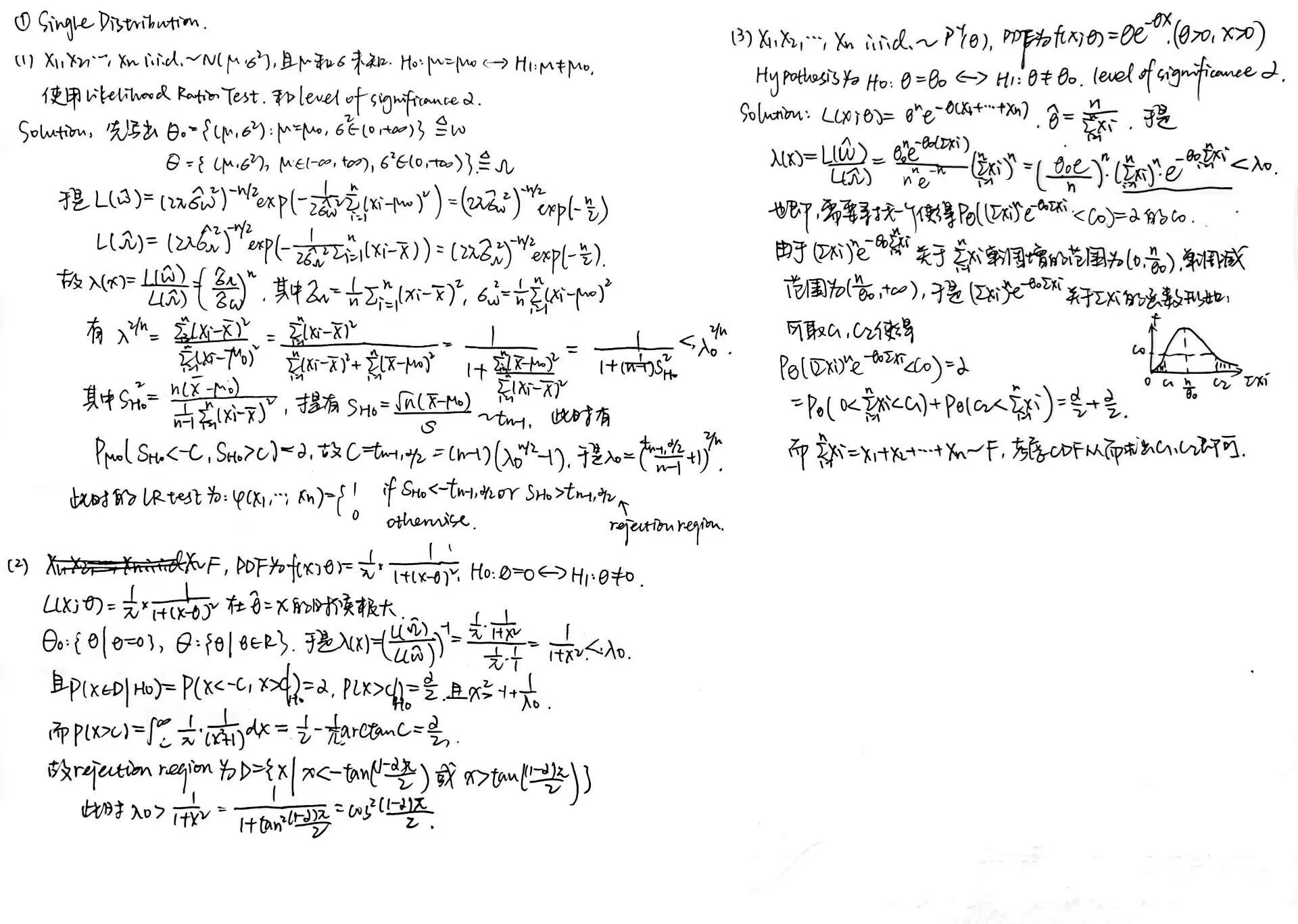
单 Normal Distribution 上样本的 LRT
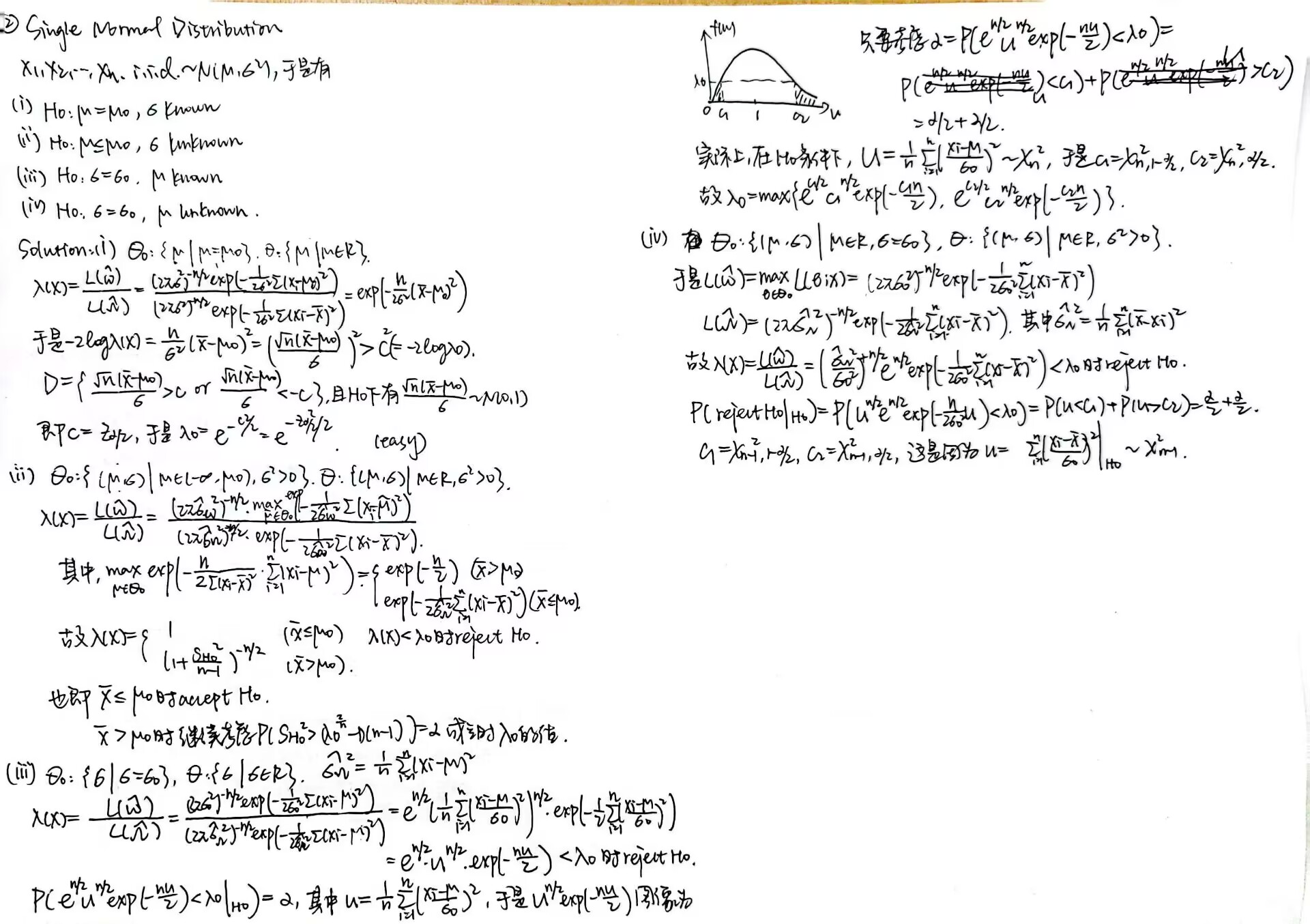
双 Normal Distribution 上样本的 LRT
饶了我罢。
PPT 第 27-36 页,自行查阅,此处略过。
Limiting Distribution of LR
如果 \(\Theta\) 的维度为 \(k\) 严格大于 \(\Theta_0\) 的维度 \(s\),分布的 PDF 符合正则条件,则对于检验问题 \(H_o:\theta \in \Theta_0 \leftrightarrow H_1 : \theta \in \Theta_1\),在 \(H_0\) 条件下,当 \(n \to \infty\) 时有 \(-2log \lambda(X) \to \chi _t ^2\) 依分布收敛,\(t=n-s\)。
Example 1:
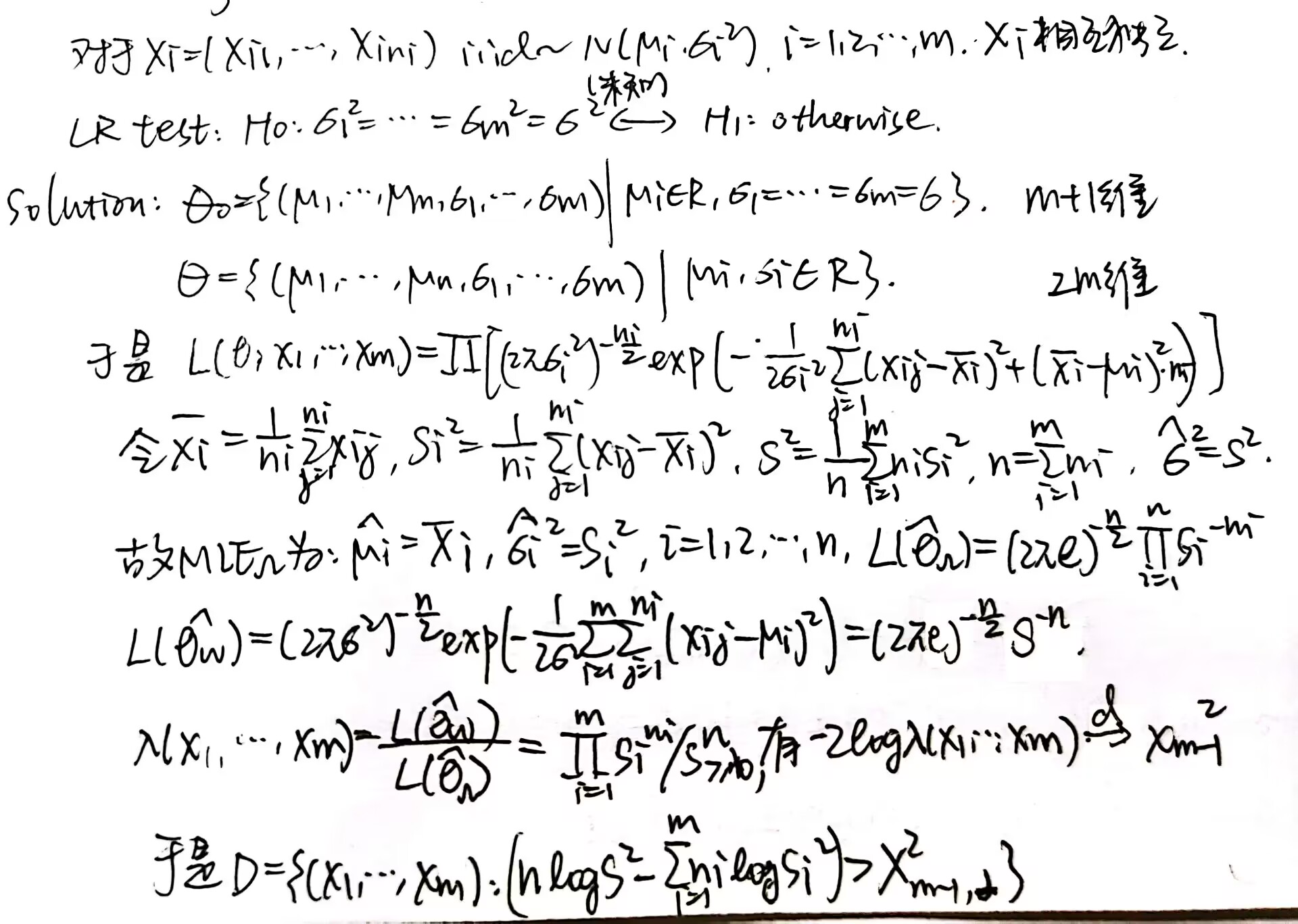
总的来说,对于一个大样本,我们对 \(H_0:\theta \in \Omega_0 \leftrightarrow H_1:\theta \notin \Omega_0\) 进行 LRT 时,LR 即为 \(\lambda=\frac{max_{\theta \in \Omega_0} L(\theta)}{max_{\theta \in \Omega} L(\theta)}\) 且使得 \(-2log\lambda \to \chi_t ^2\)。于是 reject \(H_0\) 的条件即为 \(-2log \lambda>-2log \lambda_0=\chi_{t,\alpha} ^2\),由此可以确定 \(\lambda_0\)。
Application: (Hardy-Weinberg equilibrium) 一个基因可以表达为 \(A\) 或者 \(a\),组合成为 \(AA,Aa,aa\) 之一。对于观察到的基因样本,我们已知一个样本量为 \(n\) 的样本中每种基因的个数,记为 \(N_{AA},N_{Aa},N_{aa}\)。希望通过这一数据,推算出基因表达为 \(A\) 的概率 \(\theta\)。(以我高一上学期生物期中考试 42 分的水平勉强表达完了题面,真不懂这个东西)考虑如下:
Hardy-Weinberg equilibrium 的 null hypothesis 为:\(H_0: p_{AA}=\theta^2\),\(p_{Aa}=2\theta (1-\theta)\),\(p_{aa}=(1-\theta)^2\) 对某个 \(\theta \in (0,1)\) 成立。对应的 alternative hypothesis 即为 otherwise。用 LRT 进行检验:
\(\Theta_0=\lbrace (p_{AA},p_{Aa},p_{aa} )| p_{AA}=\theta^2\),\(p_{Aa}=2\theta (1-\theta)\),\(p_{aa}=(1-\theta)^2 \rbrace\) 是一维的,因为变量实际上只有 \(\theta\)。
\(\Theta=\lbrace (p_{AA},p_{Aa},p_{aa} )| p_{AA}+p_{Aa}+p_{aa}=1\rbrace\) 是二维的,因为它由一个线性式决定。故 \(t=n-s=1\)。
于是 $ =( { {AA} })^{N {AA} }$ \(( \frac{ \hat{p} _{0,Aa} } {\hat{p} _{Aa} }) ^{N _{Aa} }\) \((\frac{\hat{p} _{0,aa} } {\hat{p} _{aa} } ) ^{N _{aa} }\)。
Full-model MLE 是 \(\hat{p} _{AA}=N _{AA} /n\),\(\hat{p} _{Aa}=N _{Aa}/n\),\(\hat{p} _{aa}=N _{aa}/n\)。
而 sub-model 的 MLE 可以计算 Likelihood Function 得到,为 \(\hat{\theta} = \frac{2N_{AA}+N_{Aa}}{2n}\)。
对应可求得 \(\hat{p} _{0,AA}\),\(\hat{p} _{0,Aa}\),\(\hat{p} _{0,aa}\),再代入 \(-2log\lambda \to \chi_1 ^2\) 就可以求出 rejection region,是一个 \(\chi^2\) 检验的形式。
Summary
没想到今天又熬了个通宵学统推,很酣畅淋漓的感觉。问就是生活在东四区。
沃日,修炸掉的 LaTeX 又修了半个小时, 这下快到东三区了。
LRT 的内容其实说白了和费尽心思找 test statistic 的 Hypothesis Test 求法没有区别,最后困难的点还是收敛到了找参数上面。LRT 是借助 level of significance 以及视 \(\lambda(x)\) 为 rejection region 的雏形来找 \(\lambda_0\),上一讲的检验找的是分位数,差不多的事。
Lecture 11
Hypothesis Test 的最后一讲,关于 Universal Most Powerful Test,理解起来真的很折磨王。
UMP Test
Definition:对于某些特定的 hypothesis:\(H_0: \theta \in \Theta_0 \leftrightarrow H_1 : \theta \in \Theta_1\),如果 power function 在 \(\Theta_0\) 上的取值满足 \(\beta _{\varphi} (\theta)=E _\theta [\varphi (X)] \leq \alpha, \forall \theta \in \Theta_0\),则记 test function \(\varphi(x)\) 是一个 level \(\alpha\) test。
此时,记 \(\Phi _{\alpha} = \lbrace \forall \varphi (x): \beta _{\varphi} (\theta) \leq \alpha , \theta \in \Theta_0 \rbrace\) 是一系列满足 power function 的检验,如果其中存在某个检验 \(\varphi ^* (x) \in \Phi _{\alpha}\) 使得对任意的 \(\varphi (x)\),有 power function 在 \(\Theta_1\) 上的任意取值也满足 \(\beta _{\varphi ^*} (\theta) \geq \beta _{\varphi } (\theta)\),那么称检验 \(\varphi ^* (x)\) 是一个 uniformly most powerful level \(\alpha\) test。
说人话:对于一些 Type I Error 发生概率不超过 \(\alpha\) 的检验,其中 Type II Error 也最小(也就是说 \(\beta(\theta)\) 在 \(\theta \in \Theta_1\) 上取值总是最大)的那个就是 UMP test。
Neyman-Pearson Lemma 是一个在双单假设检验中寻找 UMP test 的充要条件。定理叙述为:
对于 Hypothesis \(H_0: \theta = \theta_0 \leftrightarrow H_1 : \theta = \theta _1\),分布对应 PDF 或 PMF 为 \(f(x | \theta_i)\),有某个 test 满足以下条件:
- 如果 \(\frac{f(x|\theta _1)}{f(x|\theta _2)} > k\),则有 \(x \in D\),样本在 \(H_0\) 的 rejection region 中。
- 如果 \(\frac{f(x|\theta _1)}{f(x|\theta _2)} < k\),则有 \(x \in D^c\),样本不在 \(H_0\) 的 rejection region 中。
- \(\alpha = P _{\theta _0} (X \in D | H_0)\),即 Type I Error 发生的概率是 \(\alpha\)。
其中 \(k\) 是某个非负数,\(\alpha\) 是设定好的 level of significance。
于是这个 test 是 UMP level \(\alpha\) test。反过来对于一个 UMP test,也一定满足上述条件,也就是说按照 Likelihood Ratio 的范围来确定 rejection region。
Neyman-Pearson Fundamental Lemma 是一个关于 discrete distribution 的更详细叙述。
对于 Hypothesis \(H_0: \theta = \theta_0 \leftrightarrow H_1 : \theta = \theta _1\),分布对应 PMF 为 \(f(x | \theta_i)\),样本为 \(X=(X_1,...,X_n)\),于是 test function 记为:\(\varphi(x)\) 在 \(\frac{f(x|\theta _1)}{f(x|\theta _2)} > k\) 时取 \(1\),在 \(\frac{f(x|\theta _1)}{f(x|\theta _2)} < k\) 时取 \(0\),在 \(\frac{f(x|\theta _1)}{f(x|\theta _2)} = k\) 时取 \(r\)。
于是存在 \(k>0,0<r<1\) ,使得 \(E _{\theta _0} \varphi(X)= P _{\theta _0} [\frac{f(x|\theta _1)}{f(x|\theta _2)} > k] + r P _{\theta _0} [\frac{f(x|\theta _1)}{f(x|\theta _2)} = k] = \alpha\) ,这个 test 是所有 level of significance 小于 \(\alpha\) 的 test 的 UMP。注意上式是一个在 \(H_0\) 下的条件概率,表征 Type I Error 的概率。在具体例子里,我们可以通过这个式子确定 \(r\) 的取值。
当然,如果是 continuous distribution,\(r=0\),同样做检验即可。
Corollary:有三条推论,但是懒得写了。
对某个 Hypothesis 的 UMP level \(\alpha\) test,它的 power function 在 \(\Theta_0\) 上取值是 \(\alpha\),所以在 \(\Theta_1\) 上大于等于 \(\alpha\)。
关于充分统计量的两条。感觉不太会拿来考试就直接截个屏吧。证明也不难。
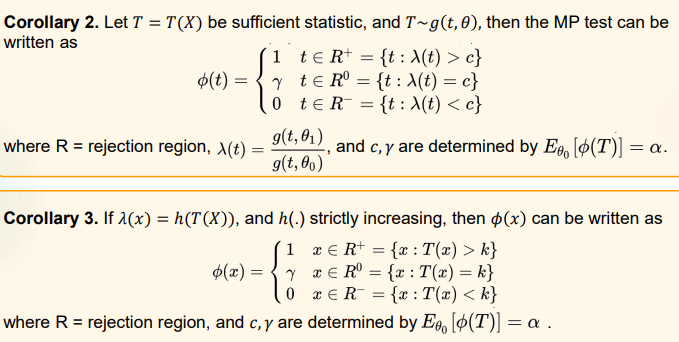
Applications:
Example 1:

Discussions for Example 1:
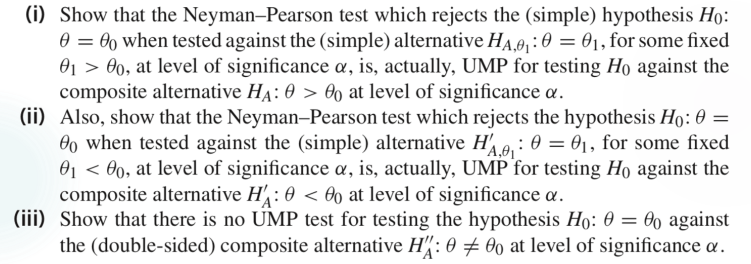
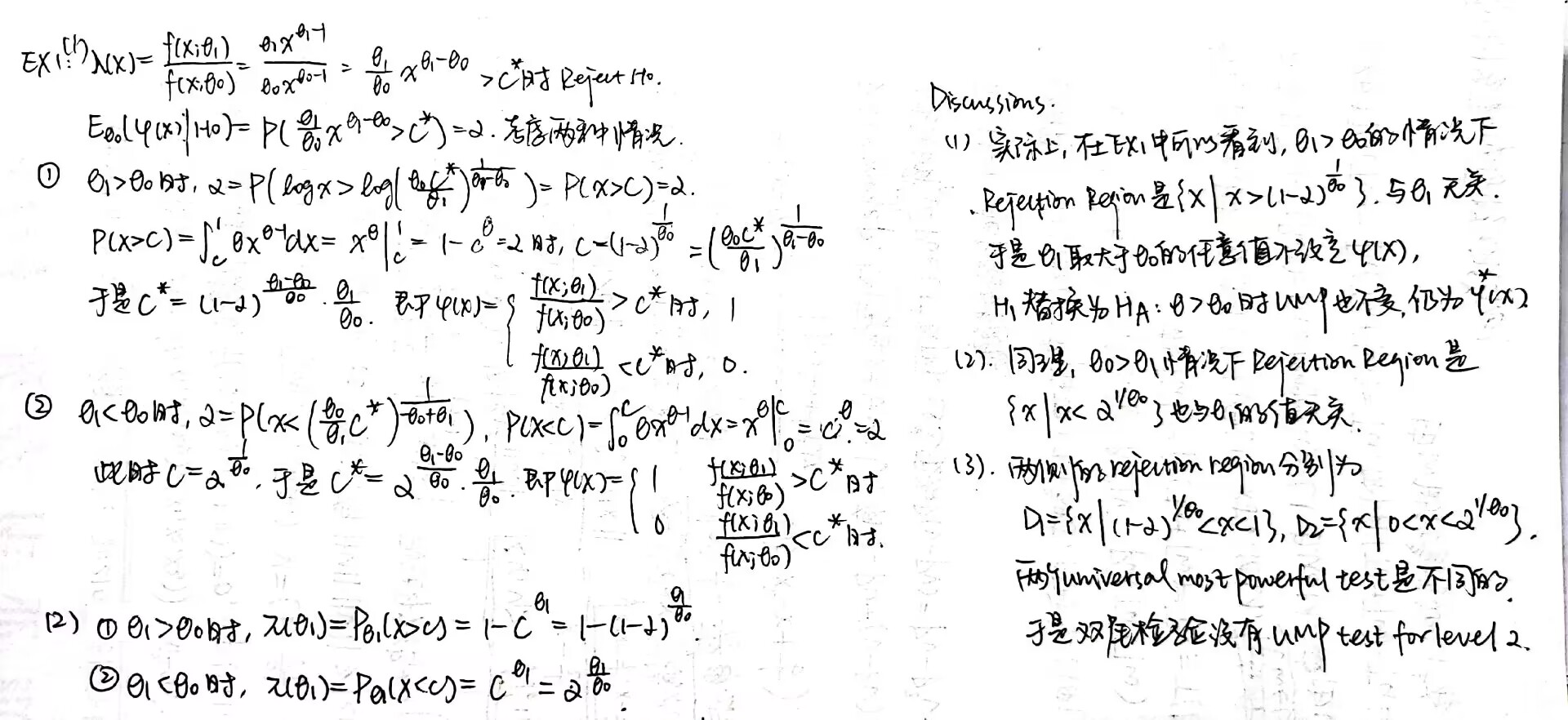
Remark:这个很典型,从单点推广到单侧检验,但是双侧检验是行不通的。
Example 2:
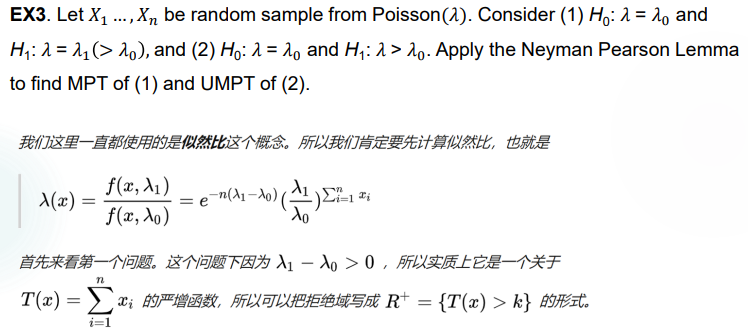
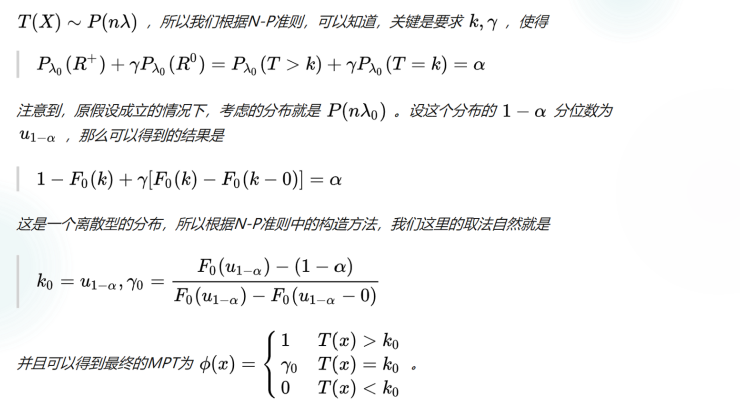
Remark:因为会做所以就不手写了,截个图当存档。可以当做 UMP 系列中 randomized test 的范本。
Example 3:


Remark:最后一问下次再看看。
UMP Test 问题的常见规约
在上面的 Application Examples 里面我们看到,UMP Test 问题有很多规约情况,可以通过两个单点 hypothesis 先归到一个单点,再推广到双区间情况。也有时候双侧检验不能规约。下面对于一般的情况进行讨论。
\(\varphi (x)\) 是 hypothesis \(H_0 : \theta = \theta _0 \leftrightarrow H_1 : \theta = \theta _1 (\theta _1 > \theta _0)\) 的一个 \(\alpha\) level 检验。如果 \(\varphi(x)\) 的取值不依靠 \(\theta _1\) 而存在,则上述 hypothesis 可以推广到 \(H_0 : \theta = \theta _0 \leftrightarrow H_1 : \theta > \theta _0\) 形式。
Example 1:
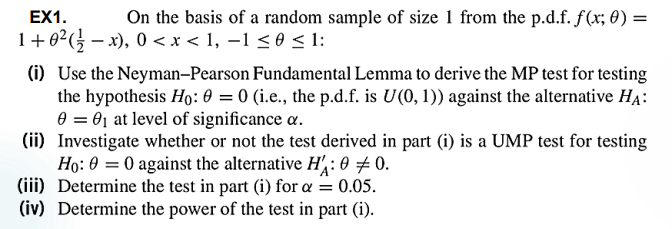
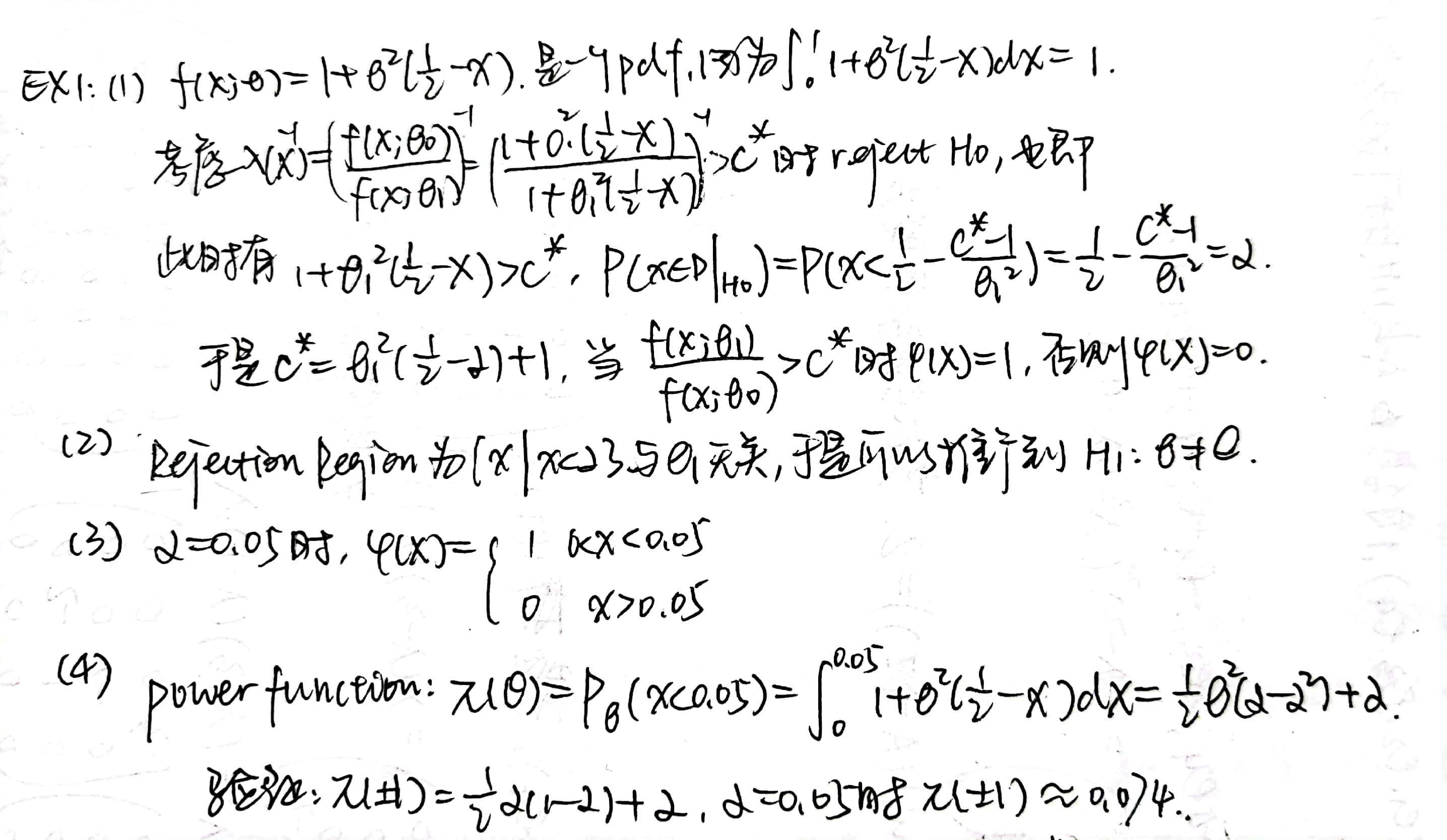
Remark:第二问里面是一个双侧检验,但是 rejection region 仍然是单侧的。说明二者之间没有必然的关系。
Example 2:

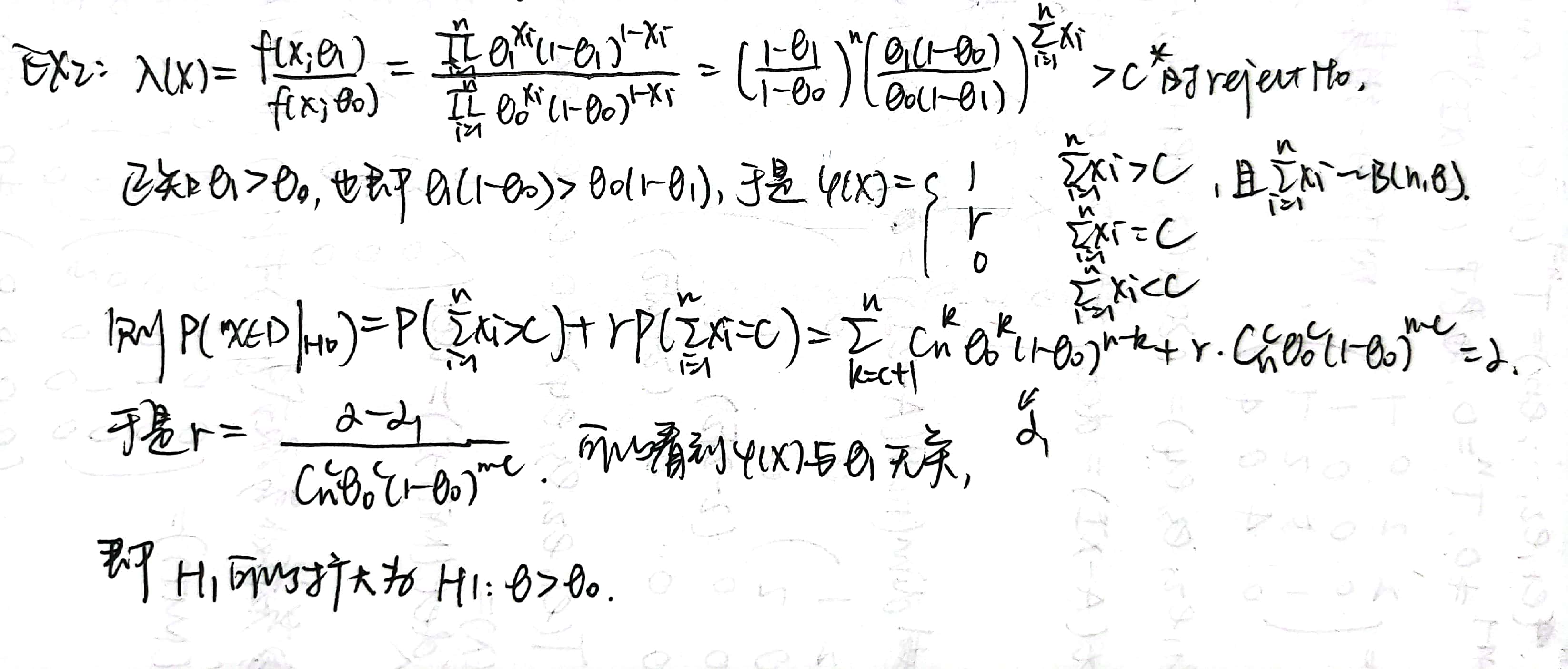
Summary:做一般复合假设的 MP 的步骤,general hypothesis 记为 \(H_0: \theta \in \Theta _0 \leftrightarrow H_1: \theta \in \Theta _1\)。
- 在 \(\Theta _0\) 里寻找一个尽量靠近 \(\Theta _1\) 的点 \(\theta _0\),在 \(\Theta _1\) 里同样找一个 \(\theta _1\)。
- 按照 NP lemma 来建立一个关于 \(H_0: \theta = \theta _0 \leftrightarrow H_1: \theta =\theta _1\) 的 MP,记为 \(\varphi _{\theta _1}\)。
- 如果 \(\varphi _{\theta _1}\) 关于 \(\theta _1\) 独立,则它可以扩充到 \(H_0: \theta =\theta _0 \leftrightarrow H_1: \theta \in \Theta _1\) 的 UMP。
- 想要再扩充到 \(H_0: \theta \in \Theta _0 \leftrightarrow H_1: \theta \in \Theta _1\) 的话,需要检验 power function 在 \(\Theta_0\) 里的取值,也即验证 \(E _\theta \varphi (X) \leq \alpha,\theta \in \Theta_0\)。一般来说,如果 power function 是单调的,这个条件比较容易满足,而这在单参数指数分布族中比较常见。
- 以上方法对单维度参数可行,且要求参数空间在 \(R\) 上。分布属于单参数指数分布族。
Fun Fact:实际上是先有了 N-P Lemma,人们才回头构造了 Likelihood Ratio Test,最后才有最开始学习的 F-test,t-test 之类的东西。
Hypothesis Testing & Confidence Interval
之前做题的时候一直感觉到这二者之间有关系,下面用定理和一个简单的一菜两吃(x)的例子详细说一下为什么其实是一回事,也作为 hypothesis testing 学习的尾声。
Example:

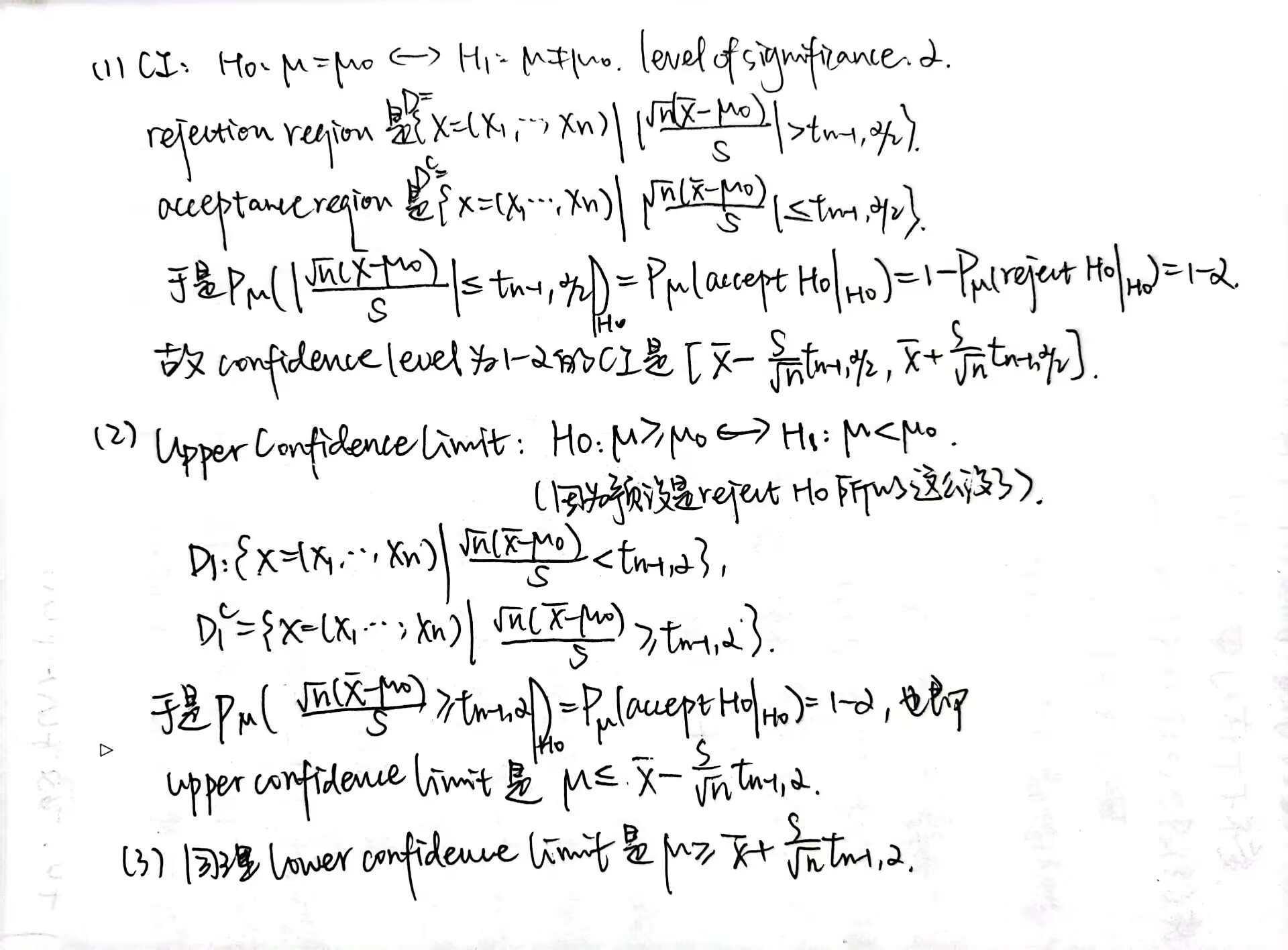
Summary:实际上我们再看这个过程。以寻找 CI 为例。
把目标转化为 Test the hypothesis: \(H_0: \theta = \theta _0 \leftrightarrow H_1: \theta \neq \theta _0\),要求 level of significance 为 \(\alpha\)。然后来计算 \(\theta\) 的 confidence interval \([\hat{\theta} _1 (X),\hat{\theta} _2 (X)]\),有 confidence level 为 \(1-\alpha\)。
在 \(H_0\) 条件下,如果 \(\theta \notin [\hat{\theta} _1 (X),\hat{\theta} _2 (X)]\),我们就 reject \(H_0\)。这一概率是 Type I Error 概率:
\(P(reject | H_0)=P_{\theta _0}(\theta _0 \notin [\hat{ \theta } _1 (X), \hat { \theta } _2 (X) ]) = 1 - P _{ \theta _0} ( \theta _0 \in [\hat{ \theta} _1 (X),\hat{ \theta} _2 (X)]) = \alpha\)
所以 \([\hat{\theta} _1 (X),\hat{\theta} _2 (X)]\) 是一个以 confidence level \(1-\alpha\) 的 confidence interval
寻找 upper confidence limit 则检验 hypothesis:\(H_0: \theta \geq \theta _0 \leftrightarrow H_1: \theta < \theta _0\);
寻找 lower confidence limit 则检验 hypothesis:\(H_0: \theta \leq \theta _0 \leftrightarrow H_1: \theta > \theta _0\)。
Theorem 1:对任意的 \(\theta \in \Theta\),有一个 hypothesis \(H_o:\theta = \theta _0\) 的检验,它的 level of significance 是 \(\alpha\),而 \(H_0\) 的 acceptance region 是 \(A(\theta _0)\)。于是集合 \(C(X)= \lbrace \theta : X \in A(\theta) \rbrace\) 是一个以 \(1-\alpha\) 为 confidence level 的 confidence region for \(\theta\)。
Theorem 2:\(C(X)\) 是一个以 \(1-\alpha\) 为 confidence level 的 confidence region for \(\theta\),也就是对任意 \(\theta _0 \in C(X)\),有 \(P[\theta _0 \in C(X) | \theta = \theta _0] = 1- \alpha\)。于是 hypothesis \(H_0 : \theta = \theta _0\) 的 acceptance region 是 \(A(\theta _0)=\lbrace X : \theta _0 \in C(X) \rbrace\),这一 test 的 level of significance 是 \(\alpha\)。
Extended Content *
总之就是好玩的东西。
Monotone Likelihood Ratio
对于某个 sample 的充分统计量 \(T(X)\),考虑关于它的检验使得以 \(T(x)\) 为 rejection region 的度量。
UMP in Exponential Family
\(X_1,X_2,...,X_n\) 是一组来自 exponential family 的 random sample,它们的 population 服从一个以 $f(x;) = C() h(x) exp(Q() T(x)) $ 为 PDF 的 distribution。其中,\(Q(\theta)\) 是严格单调的。由 exponential family 的性质,我们记 \(V(x_1,...,x_n) = \Sigma _{i=1} ^n T(x_i)\) 为一个 sufficient statistic。
如果 \(Q(\theta)\) 严格递增,考虑 hypothesis \(H_0: \theta \leq \theta _0 \leftrightarrow H_A : \theta > \theta _0\),UMP test 的形式由 test function 给出: \(V(x_1,...,x_n)>C\) 时 \(\varphi (x_1,...,x_n) = 1\),\(V(x_1,...,x_n)<C\) 时 \(\varphi (x_1,...,x_n) = 0\), \(V(x_1,...,x_n) = C\) 时 \(\varphi (x_1,...,x_n) = \gamma\)。根据 level of significance 是 \(\alpha\),可以确定出 \(\gamma\) 的取值。
hypothesis 的形式为 \(H_0: \theta \geq \theta _0 \leftrightarrow H_A : \theta < \theta _0\) 的做法类似,\(Q(\theta)\) 单调递减时的操作也类似。
可以这么做的原因是,这和使用 likelihood function 的结果是一样的。
先考虑单点 hypothesis \(H_0: \theta = \theta _0 \leftrightarrow H_A : \theta = \theta _1(\theta _1 > \theta _0)\),此时有 \(\lambda (x)=\frac{f(x; \theta _1)} {f(x; \theta _0)}\) 是关于 \(V(x)\) 严格单调的,由此可以给出单点处的 MP Test,它不依赖于 \(\theta _1\),可以把 \(H _A\) 延拓到 \(\theta > \theta _0\)。而 power function 在 \(\Theta _0\) 上是关于 \(\theta\) 单调的,可以再把 \(H_0\) 延拓到 \(\theta \leq \theta _0\)。
Example 1:The Binomial Case
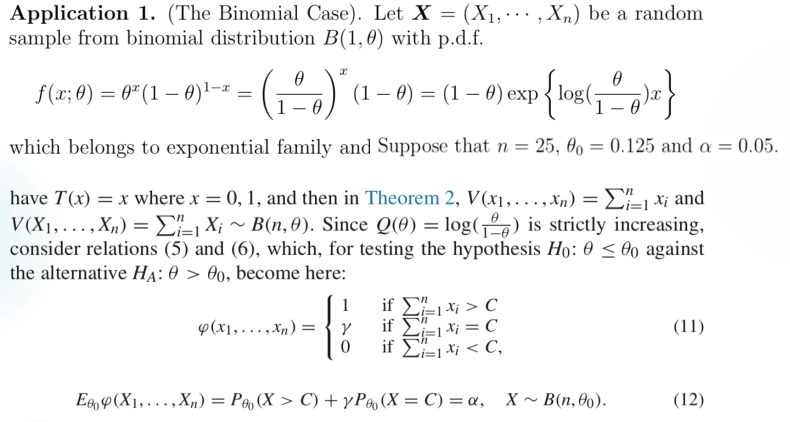
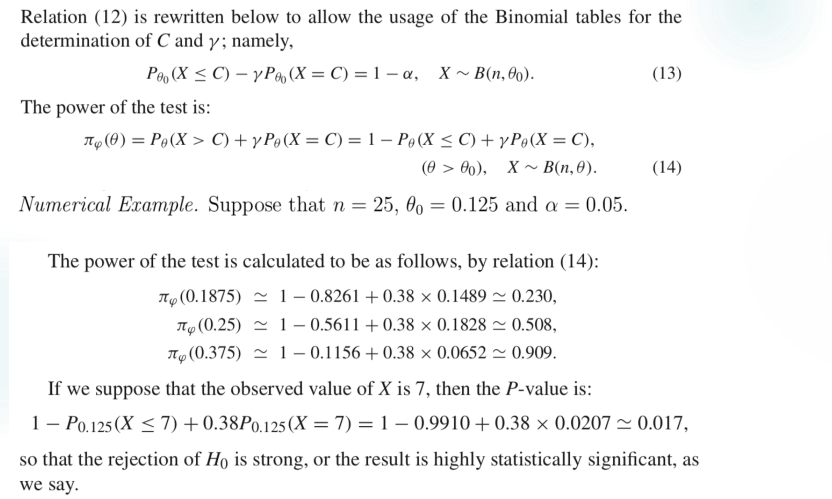

Homework 6
破事挺多啊
助教在干啥助教为什么不批作业了(
Lecture 12
最后一课,介绍一些分布未知时的处理方法,称为非参数检验。
Sign Test
对于 paired data 的检验。
假定 \(X=(X_1,...,X_n),Y=(Y_1,...,Y_n)\) 是已知的两组数据,希望知道二者之间有没有显著差异,即 hypothesis 为 \(H_0: \mu = 0 \leftrightarrow H_1 : \mu \neq 0\),其中记 \(Z_i = Y_i - X_i,\mu = E(Z_i)\)。
实际上我们也可以通过 two sample t test 进行操作,假设 \(X,Y\) 是正态分布的。但是这样做精度不高,而且无法突出两组数据的特征,尤其是在有明显偏离的数据上,non-parametric test 表现更好。
说回主题,在 sign test 中我们可以赋予每一个 data 一个 sign 值,以祈这一组 sign 值近似于某一分布。最简单的方式就是按照 data 的正负性来赋值,记 \(n_+\) 为 sign 的正值数量,\(n_-\) 为负值数量,舍弃 \(0\) 值。于是有 \(n_0 = n_+ + n _-\),且 \(n_+ \sim B( n_0 , \theta)\),原假设即转化为 \(H_0 : \theta = 0.5 \leftrightarrow H_1 : \theta \neq 0.5\),变成了熟悉的检验形式。
Example for paired test
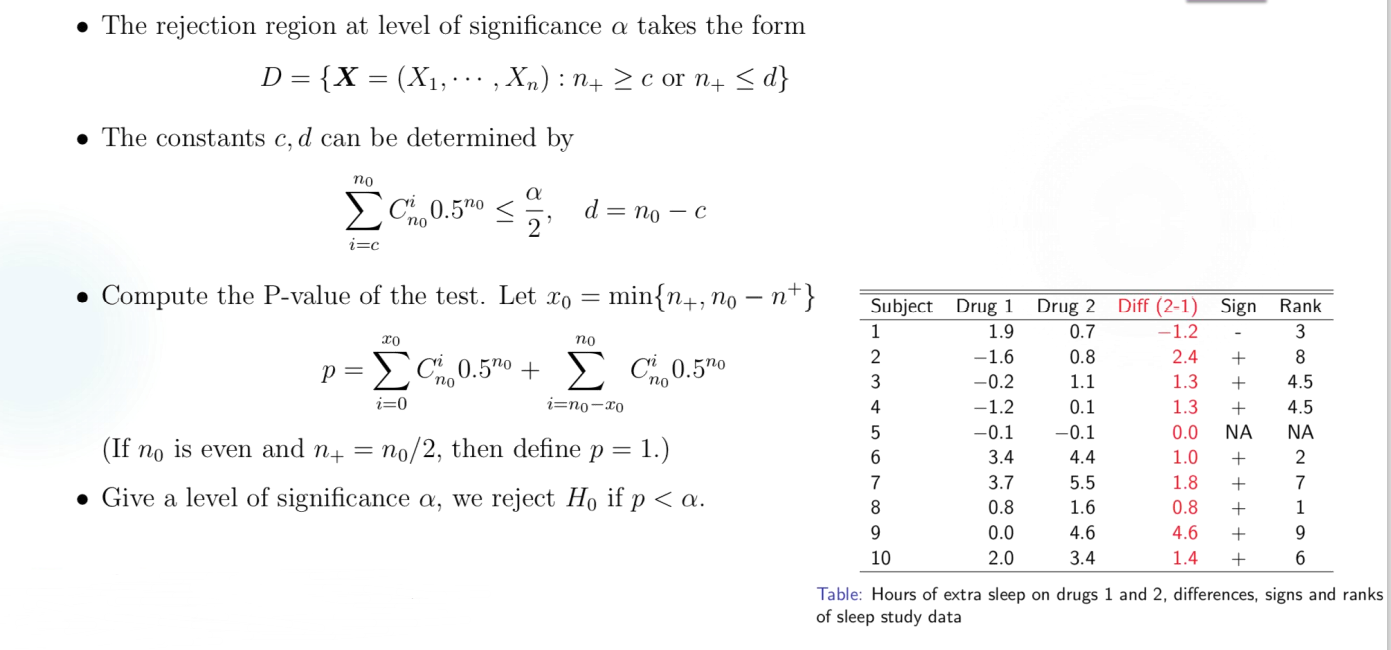
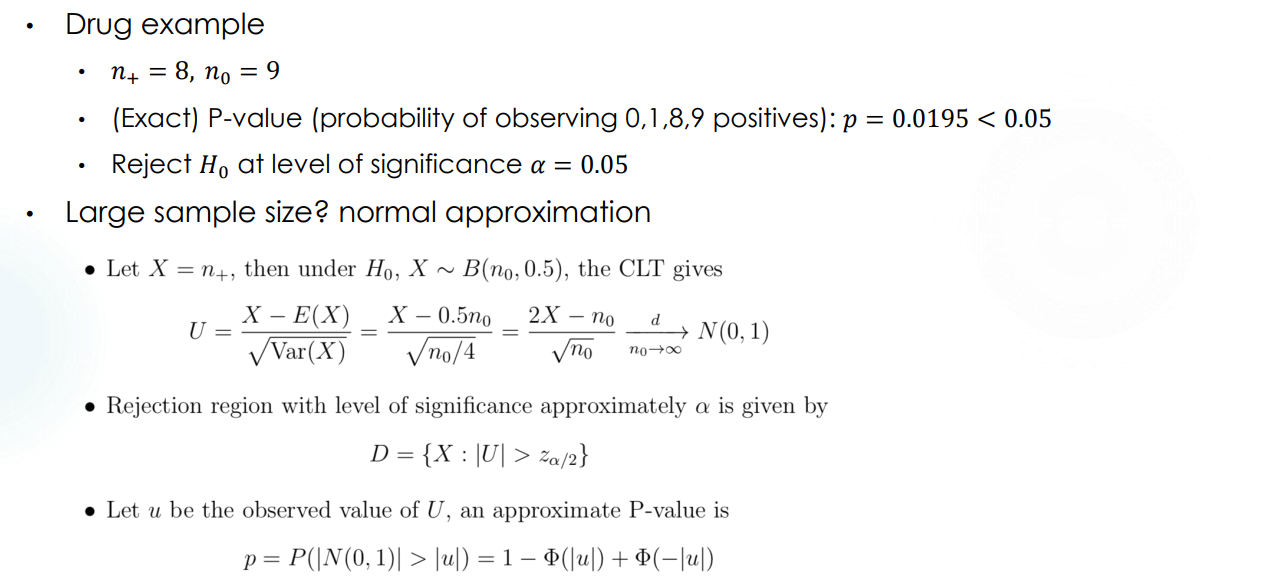
Test median of population
通过一个样本来找某一 population 的中位数,也可以通过 sign test 进行,放一个例子在这里,就不细说了。
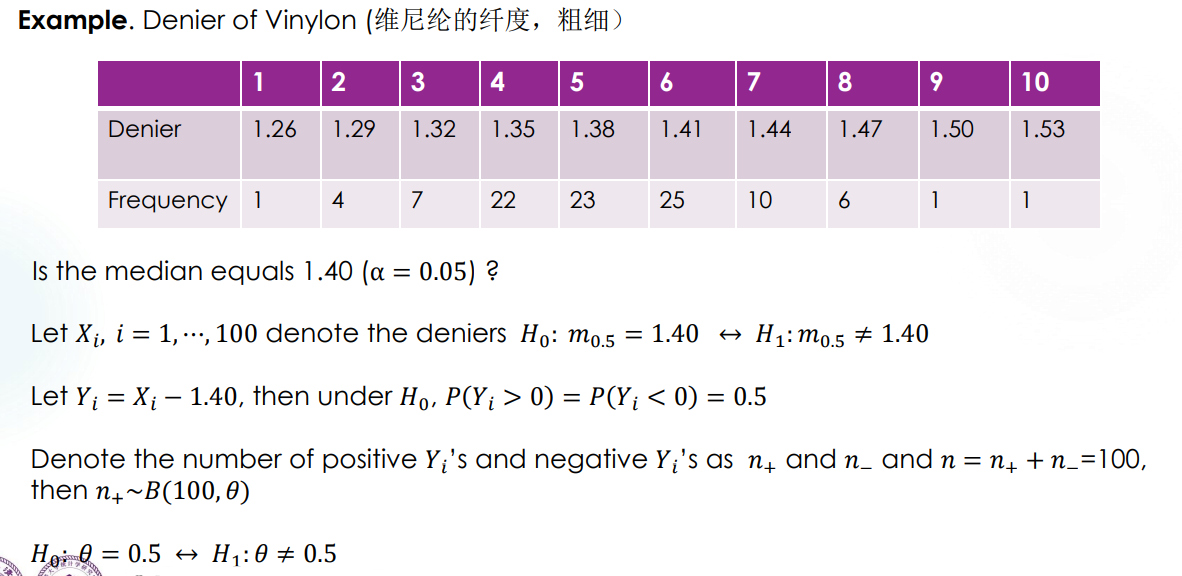
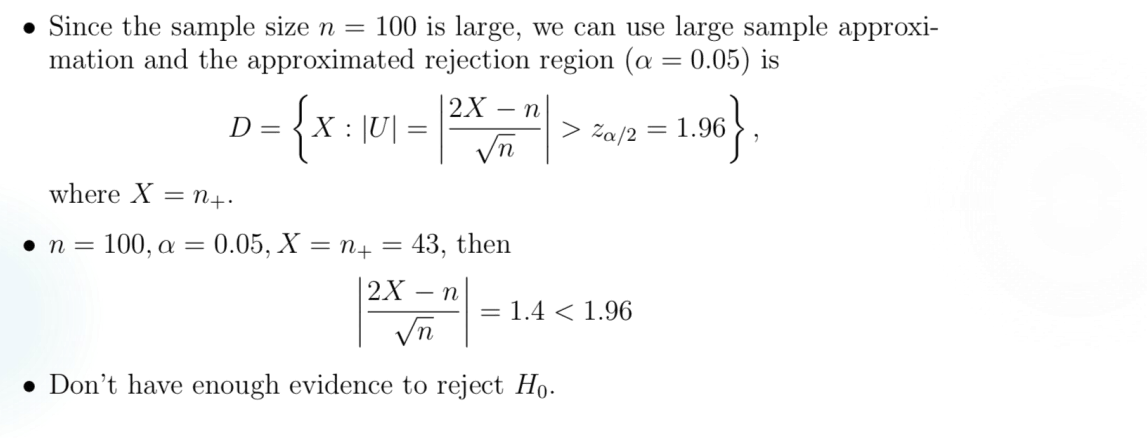
Remark:实际上在这个例子里,取 median 为 1.39 也不影响检验结果。sign test 对具体数据的表现能力较弱,实际上是 low power 的。
Wilcoxon Signed Rank Sum Test
这个东西很好玩,但是考试暂时不考,码的成分又比较大,而且理论部分我想后面再研究研究再写,先跳过了。
Goodness of Fit Test
难得遇到一个我早就考虑过的问题,大概是高一上生物课的时候,讲孟德尔种豌豆发现某些基因表达的比例大概是 \(9:3:3:1\)。我就很好奇这个是怎么近似出来的,你总不能只告诉我“看着很像”吧。Goodness of fit test 大概就是解决这一类问题。
设 \(X=(X_1,...,X_n)\) 是来自某一 population 的随机样本,\(F\) 是一个给定的分布,也叫做 theoretical distribution,我们想要验证 \(H_o: X \sim F\) 这一假设。
首先我们需要进行一些量化,来反映某个 statistic 什么情况下能代表 \(X \sim F\)。也就是说,要定义一个 quantity \(D=D(X_1,X_2,...,X_n,F)\) 使得在 \(D \geq c\) 时 reject \(H_0\)。这时定义 goodness-of-fit 的程度为 \(p(d_0) = P(D \geq d_0 | H_0)\),\(d_0\) 是确切样本下 \(D\) 的观测值。
Pearson \(\chi ^2\) test for discrete F
令 \(X=(X_1,X_2,...,X_n)\) 是 population \(X\) 中的一个随机样本,theoretical distribution \(F\) 为一个离散分布,其 PMF 为 \(f(a_i)=p_i,\Sigma _{i=1} ^r p_i =1\)。于是 hypothesis 转化为 \(H_0: P(X=a_i) = p_i,i=1,2,...,r\)。
记 \(v_i\) 是样本中观察到的 \(a_i\) 的出现次数,于是 \(\Sigma _{i=1} ^r v_i= n\),\(v_i\) 是自然数。在 \(H_0\) 条件下,当 \(n\) 足够大时,有频率 \(\frac { v_i }{n} \to p_i\)。于是我们用 \(K_n = \Sigma _{i =1} ^r c_i (\frac {v_i}{n} -p_i) = \Sigma _{i=1} ^r \frac{(v_i - np_i) ^2}{np_i }\) 作为衡量的指标,其中的系数 \(c_i = \frac{n} {p_i }\)。
这一指标的好处在于,在 \(H_0\) 条件下,当 $n $ 时有 \(K_n \to \Chi _{r-1} ^2\)。所以称为 Pearson \(\chi ^2\) test。
Example 1:
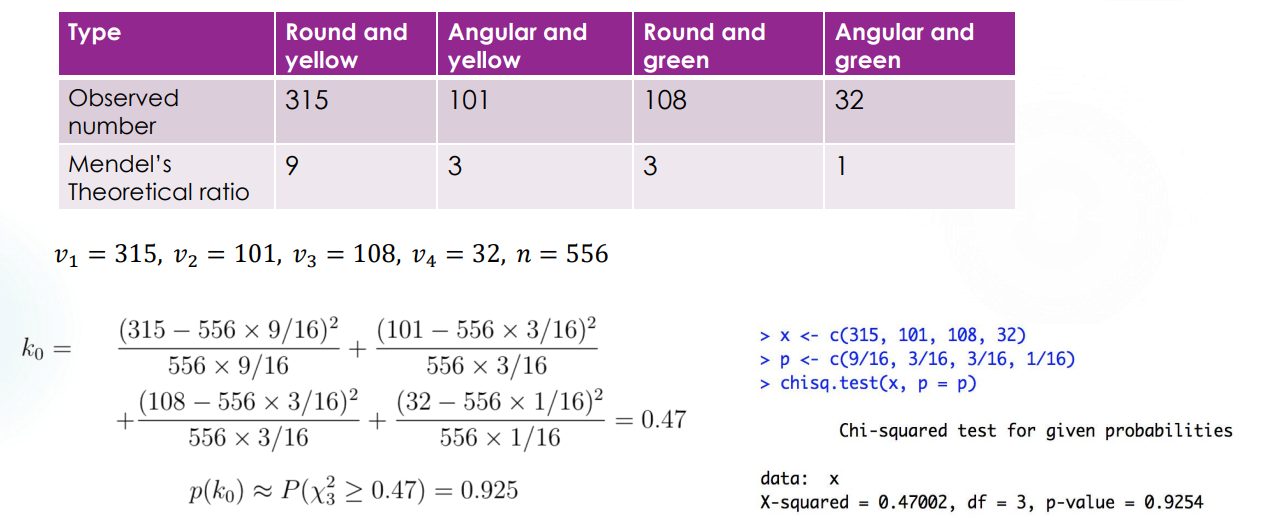
Pearson \(\chi ^2\) test for continuous F
这和数值分析里面那个差分技巧还挺像的,分割区间然后强行转成 discrete distribution 就可以了。取 \(r-1\) 个常数 \(a_0 = -\infty < a_1 < a _2 <...< a _{r-1} < + \infty = a _r\),就把区间分割成了 \(r\) 段(注意它们的起和止,除了 \(I_r\) 之外都是左开右闭的):\(I _1 = (- \infty , a _1], I_2 = (a_1, a_2],..., I _r = (a _{r-1} , \infty)\)。再记 \(p_j = P _F(X \in I_j) = F(a_j) - F(a _{j-1})\) 即可做出假设:\(H_0 : P(X \in I_j) = p_j,j=1,2,...,r\)。
类似地给出衡量指标 \(K_n = \Sigma _{i =1} ^r c_i (\frac {v_i}{n} -p_i) = \Sigma _{i=1} ^r \frac{(v_i - np_i) ^2}{np_i }\),在 \(H_0\) 条件下,当 $n $ 时有 \(K_n \to \Chi _{r-1} ^2\)。
Remark:可以看到这个操作的近似程度做得比较多,所以有几点注意事项。
- 关于 \(r\) 的选择。理论上和实际观测到的 frequency \(v_i\) 不能小于 \(5\),否则应当合并相邻的区间。
- 不能根据得到的 sample 来划定 \(a_i\),这是没有普遍性的。
- 实际上因为左右端是取到无穷的,这一区间的选择方式可能带来一定问题。
Example 1:
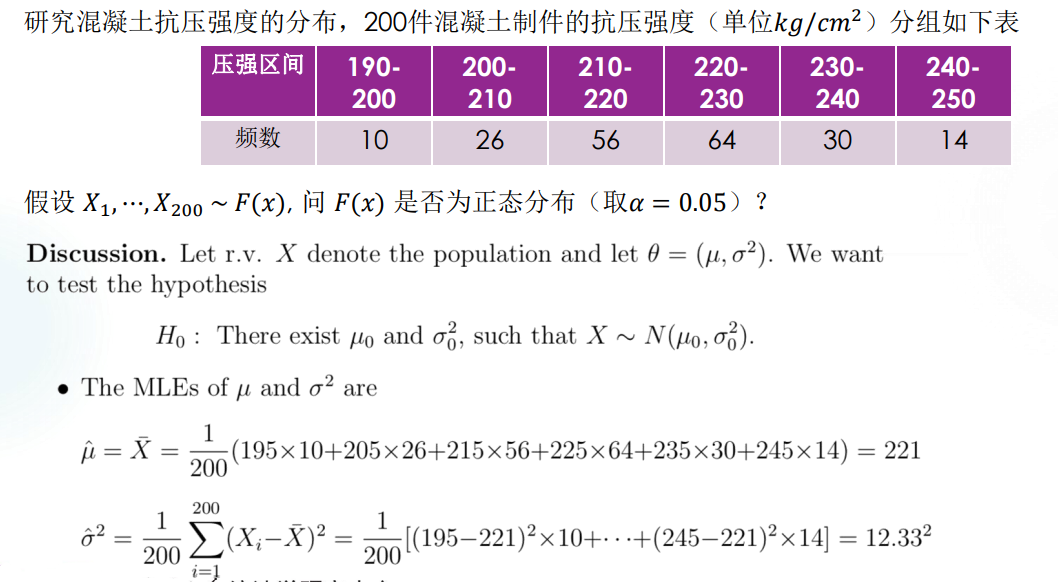
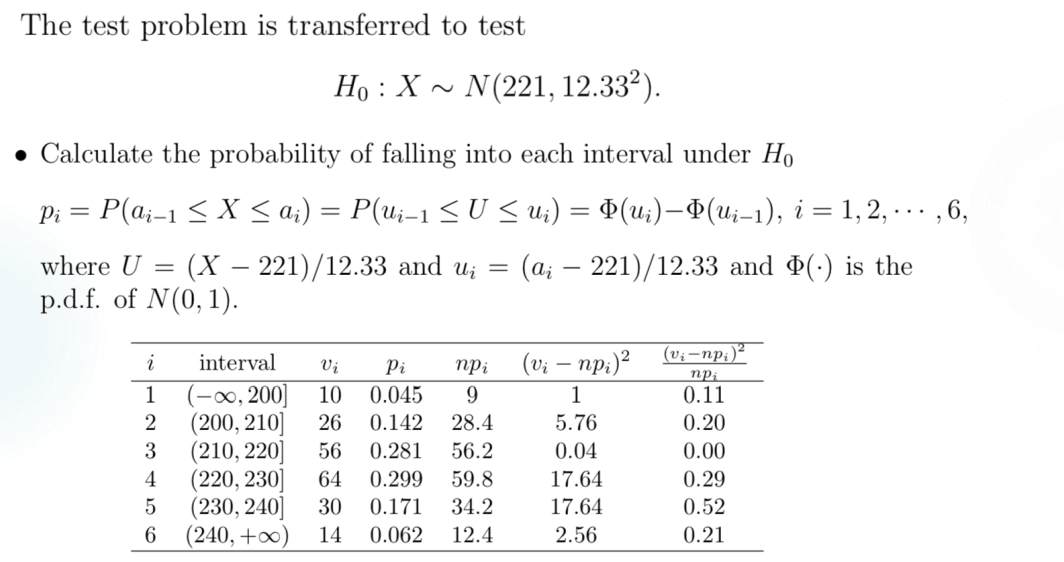

Remark:可以看到这里 Pearson 指标的近似分布是 \(\chi ^2 _3\) 而不是 \(\chi ^2 _5\),这是因为此处的 theoretical distribution 参数也是未知的,是通过 MLE 方法估计出来的。在这种情况下,Pearson 指标将收敛到 \(\chi ^2 _{r-s-1}\),其中 \(s\) 是未知参数的数目。
Contingency Table Independence
另一种问题,种豌豆的时候每一次收获的结果必然有数值上的差异,(开始认真地编数据),比如说第一次是 \(213 : 76 : 69 : 25\),第二次是 \(254 : 85 : 89 : 32\),那么凭什么说它们都反映了同样的比例?
我们称 \(10\) 次采集豌豆统计出来的表格为 contingency table,contingency 为偶然的意思,称这种检验为 homogeneity test,即为同质性检验。(词汇量 ++!(
实际上,我们用一个高维的 \(\chi ^2\) 检验来解决问题。Contingency table 的形式如下:
Category 1 ... Category C \(\Sigma\) Group 1 \(N_{11}\) ... \(N_{1C}\) \(N_{1+}\) ... ... ... ... ... Group R \(N_{R1}\) ... \(N_{RC}\) \(N_{R+}\) \(\Sigma\) \(N_{+1}\) ... \(N_{+C}\) \(n\) 记 \(p_{ij} = P(Category_j | Group _i) = \frac{N _{ij} }{N _{i+} }\),于是有 \(\Sigma _{j=1} ^C p_{ij} = \Sigma _{i=1} ^R p_{ij} = 1\)。比较粗暴地来说,我们想要确定每一组 \(p_{ij}=p_j\) 对任意的 \(i\) 都是成立的,而 \(p_j = P(category _j)\)。
所以假设可以写成:$H_0 : p_{ij} = p_j $ 对任意的 \(i \leq R\) 都成立。此时 Pearson 指标可以写成:
\(\Sigma _{i=1} ^R \Sigma _{ j=1 } ^C \frac{(N _{ij} - N _{i+}N _{+j} /n) ^2} {N _{i+}N _{+j} /n} = n (\Sigma _{i=1} ^R \Sigma _{ j=1 } ^C \frac{N_{ij} }{N_{i+} N_{+j}} - 1) \to \chi _{(R-1)(C-1)} ^2\),这一近似在 \(R,S\) 较大且符合 \(H_0\) 假设的情况下是成立的。
Example 1:
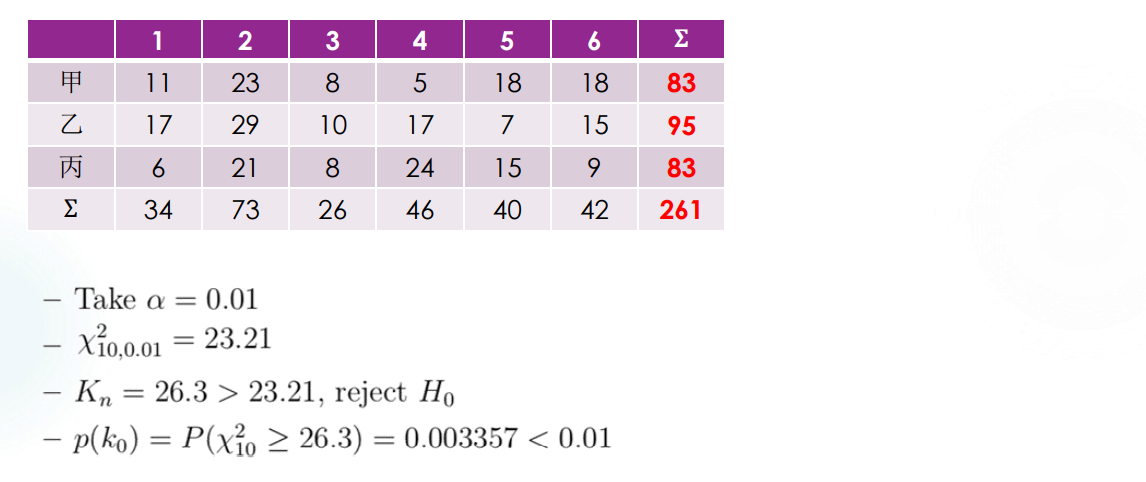
Normality Test
和 Wilcoxon Test 类似的原因,暂时先咕了
Summary
Non-parametric Test 应用范围更广,毕竟一般都不知道是什么分布;在大样本情况下表现较好。
Parametric Test 的 model assumption 正确时精度很高,但是泛用性不够强。
完结撒花
证明和代码都还没有补齐,暂时称不上证明完毕。但是以考试为目标的应用部分完结了,目前称得上一个夜话团圆。

Final
一些简单的提示。
在正态分布 \(X_1,X_2,...,X_n i.i.d. \sim N(\mu ,\sigma ^2)\) 里,一些常用于检验的统计量及其分布:
\(\frac{\sqrt{n} (\bar{X} - \mu )}{\sigma} \sim N(0,1)\),利用正态分布的线性性质即可。
记 sample mean 为 \(S^2 = \frac{1}{n-1} \Sigma _{i=1} ^n (X_i - \bar{X})^2\),于是有 \(\frac{(n-1)S^2} {\sigma ^2} \sim \chi _{n-1} ^2\)。
另一个 Chi-square 分布是 \(\frac{nS _{\mu} } {\sigma ^2} = \Sigma _{i=1} ^n (\frac{X_i - \mu}{\sigma})^2 \sim \chi ^2 _{n}\)。注意区分 \(S_\mu\) 和 \(S\) 的区别,前者实际上是 2-nd center moment,后者是 sample variance。
以上计算都比较依赖 \(\sigma\),实际上 \(\frac{\sqrt{n} (\bar{X} - \mu)}{S} \sim t_{n-1}\),由 \(t-\) 分布的构造可以得出。
大数定律下,sample variance \(S \to \sigma\)。
经典的 CI 估计
单 population 下 \(X=(X_1,X_2,...,X_n) i.i.d. \sim N(\mu ,\sigma ^2)\),四种估计:
\(\mu\) 已知,估计 \(\sigma\),pivot statistic 为 \(\frac{nS _{\mu} } {\sigma ^2} = \Sigma _{i=1} ^n (\frac{X_i - \mu}{\sigma})^2 \sim \chi ^2 _{n}\)
\(\mu\) 未知,估计 \(\sigma\),pivot statistic 为 \(\frac{(n-1)S^2} {\sigma ^2} \sim \chi _{n-1} ^2\)
\(\sigma\) 已知,估计 \(\mu\),pivot statistic 为 \(\frac{\sqrt{n} (\bar{X} - \mu )}{\sigma} \sim N(0,1)\)
\(\sigma\) 未知,估计 \(\mu\),pivot statistic 为 \(\frac{\sqrt{n} (\bar{X} - \mu)}{S} \sim t_{n-1}\)
双 population 下 \(X=(X_1,...,X_m) i.i.d. \sim N(\mu _1,\sigma _1 ^2)\),\(Y=(Y_1,...,Y_n)i.i.d. \sim N(\mu _2,\sigma _2 ^2)\),四个参数都未知时的四种估计:
\(\sigma _1 ^2 = \sigma _2 ^2 = \sigma ^2\) 时估计 \(\mu_1 - \mu _2\)
\(\sigma _1 \neq \sigma _2\) 时渐进估计 \(\mu_1 -\mu_2\) 和 \(\sigma _1 ^2 / \sigma _2 ^2\)
Precision(精确度):有很多种估计方法,此处取最常用的方法:mean interval length,即计算 \(E_{\theta}(\hat{\theta_2}-\hat{\theta _1})\),这个值越大说明区间越长,因此估计的精确度越差。
还有 confidence coefficient 的定义。

